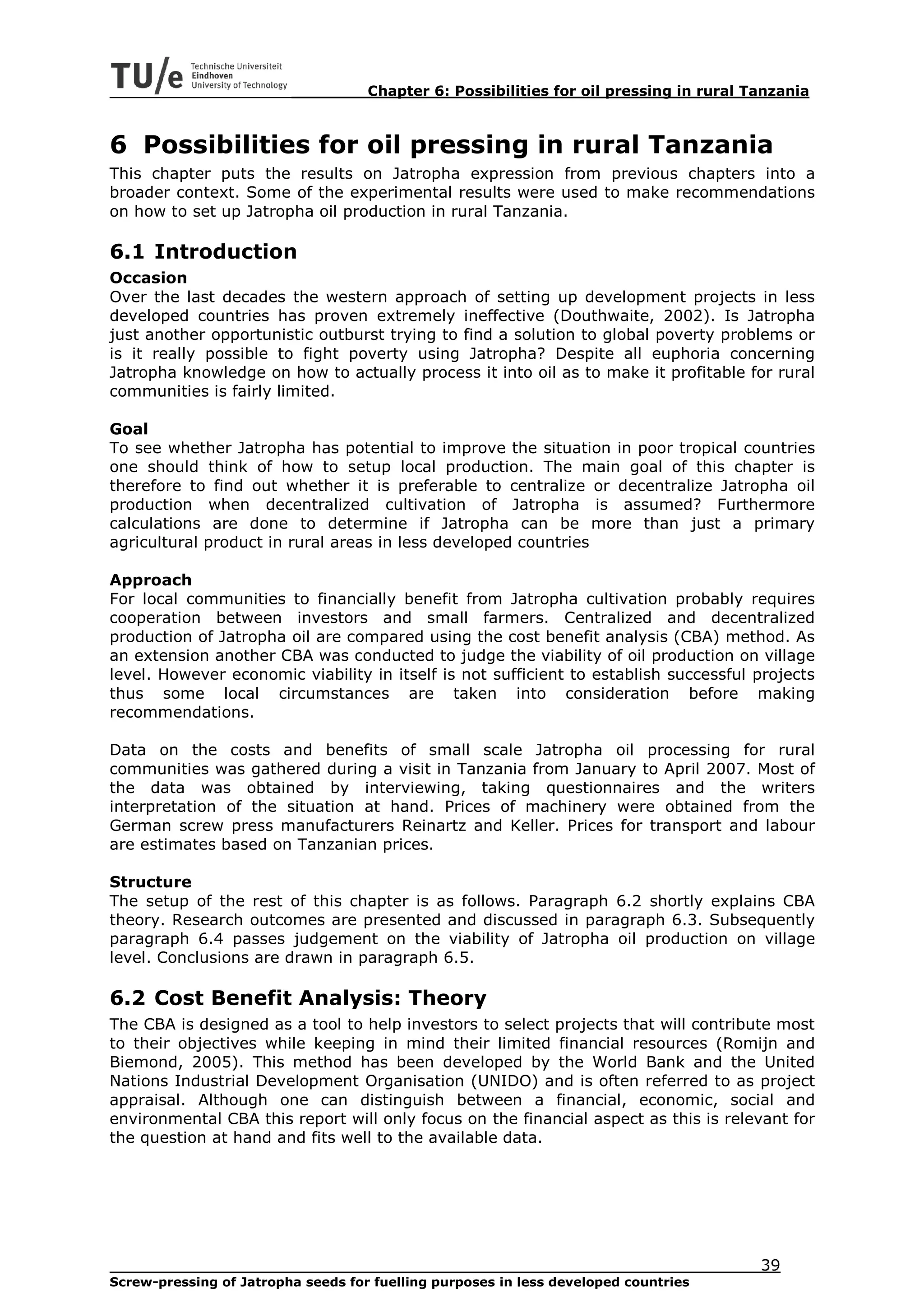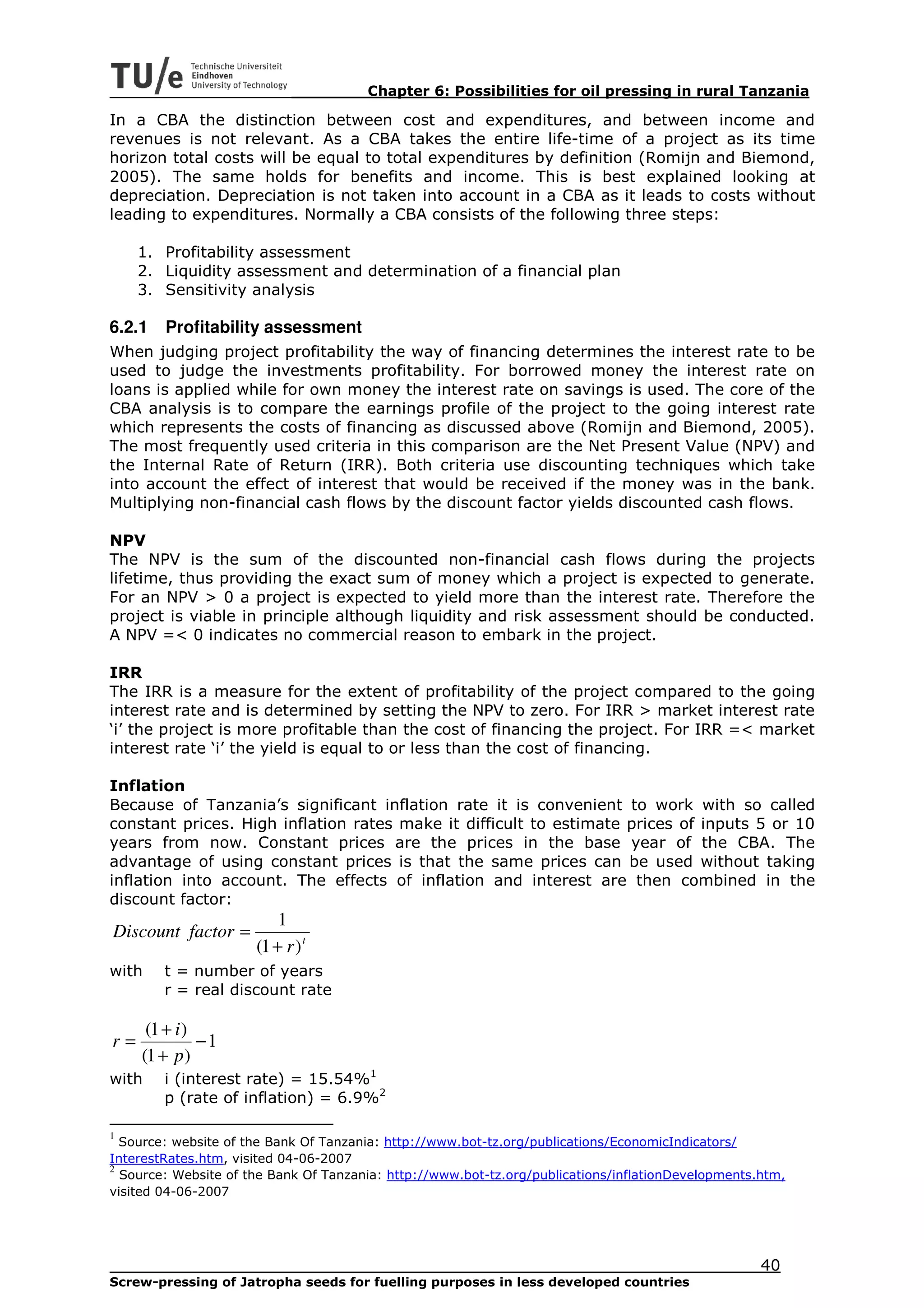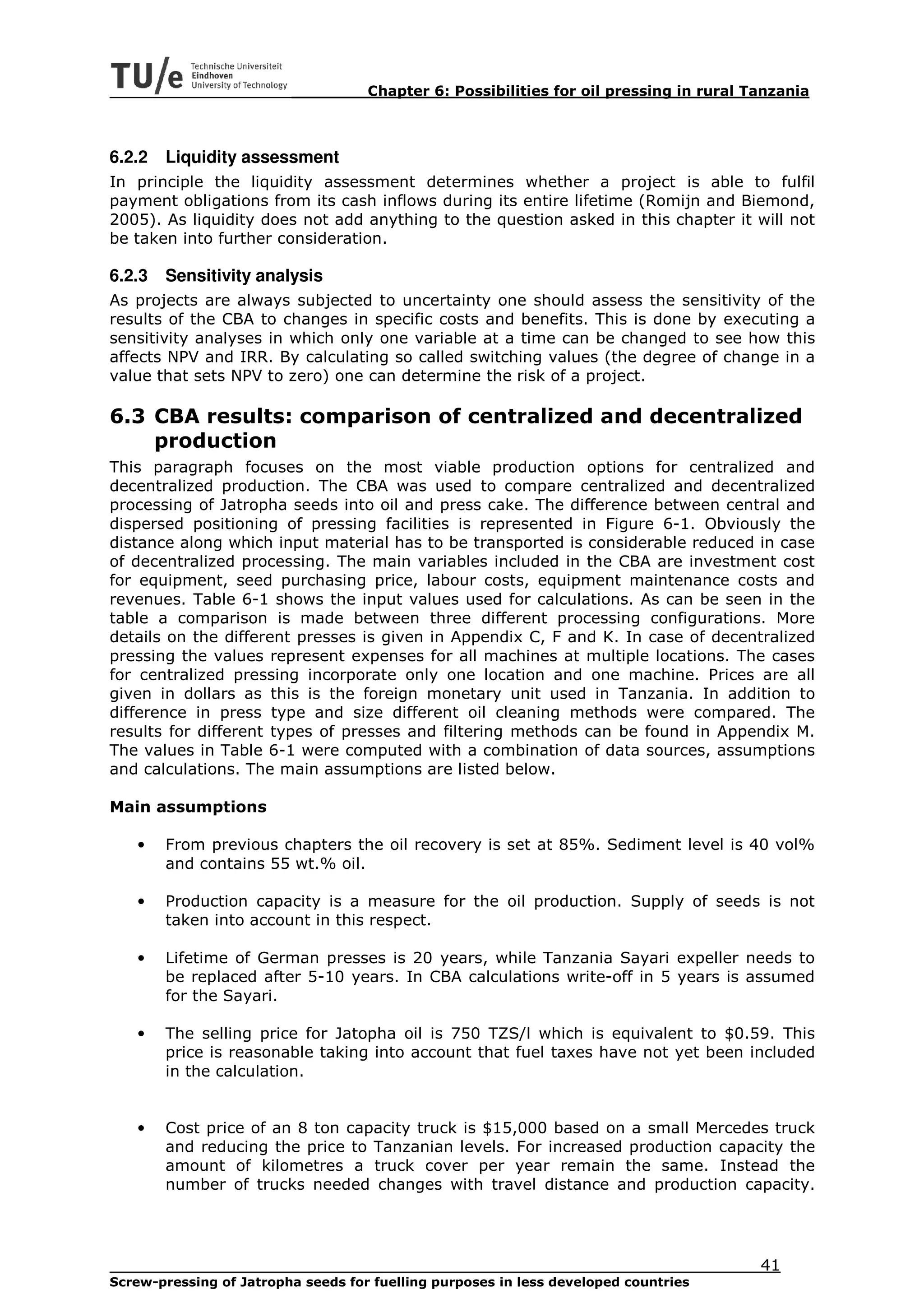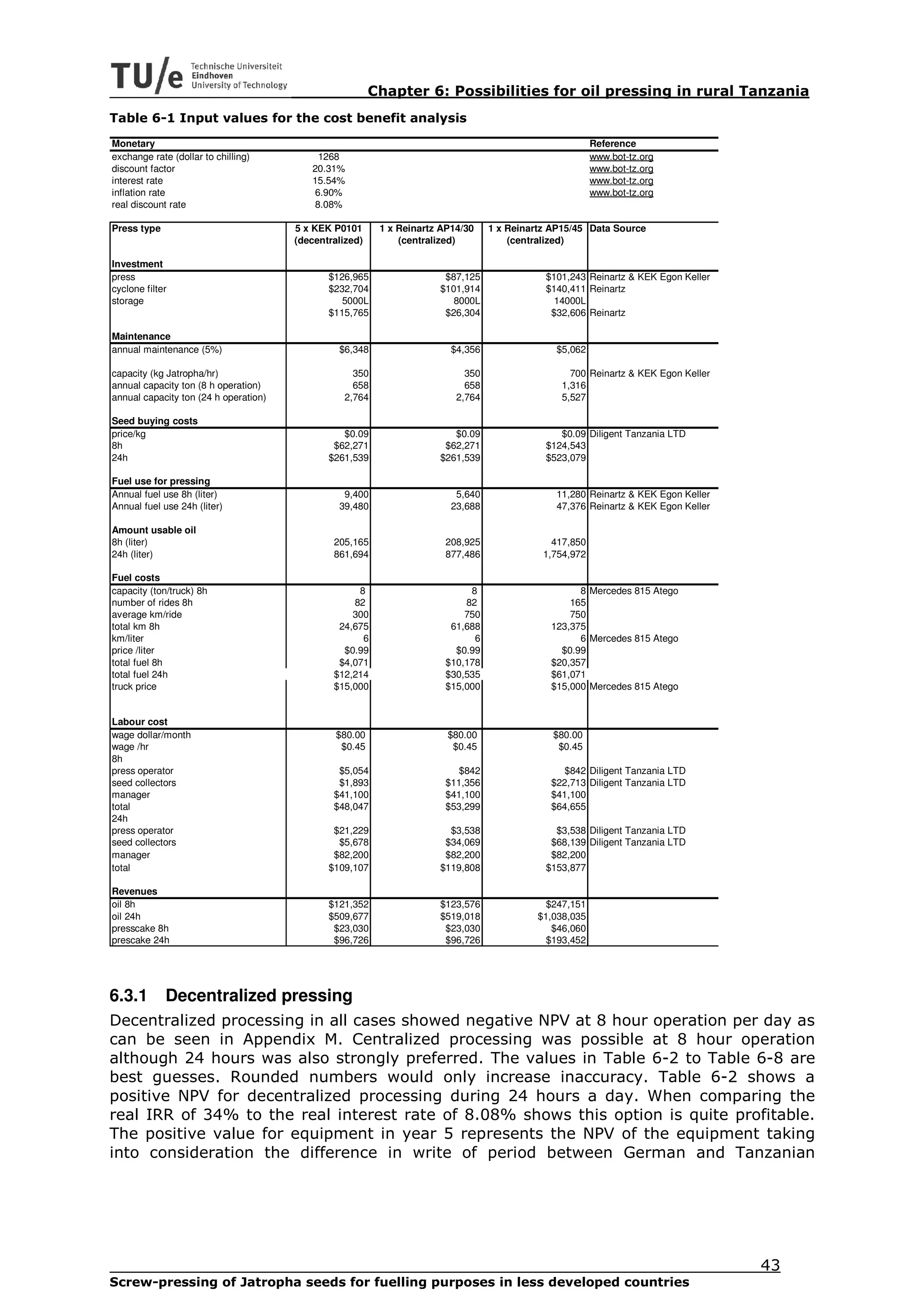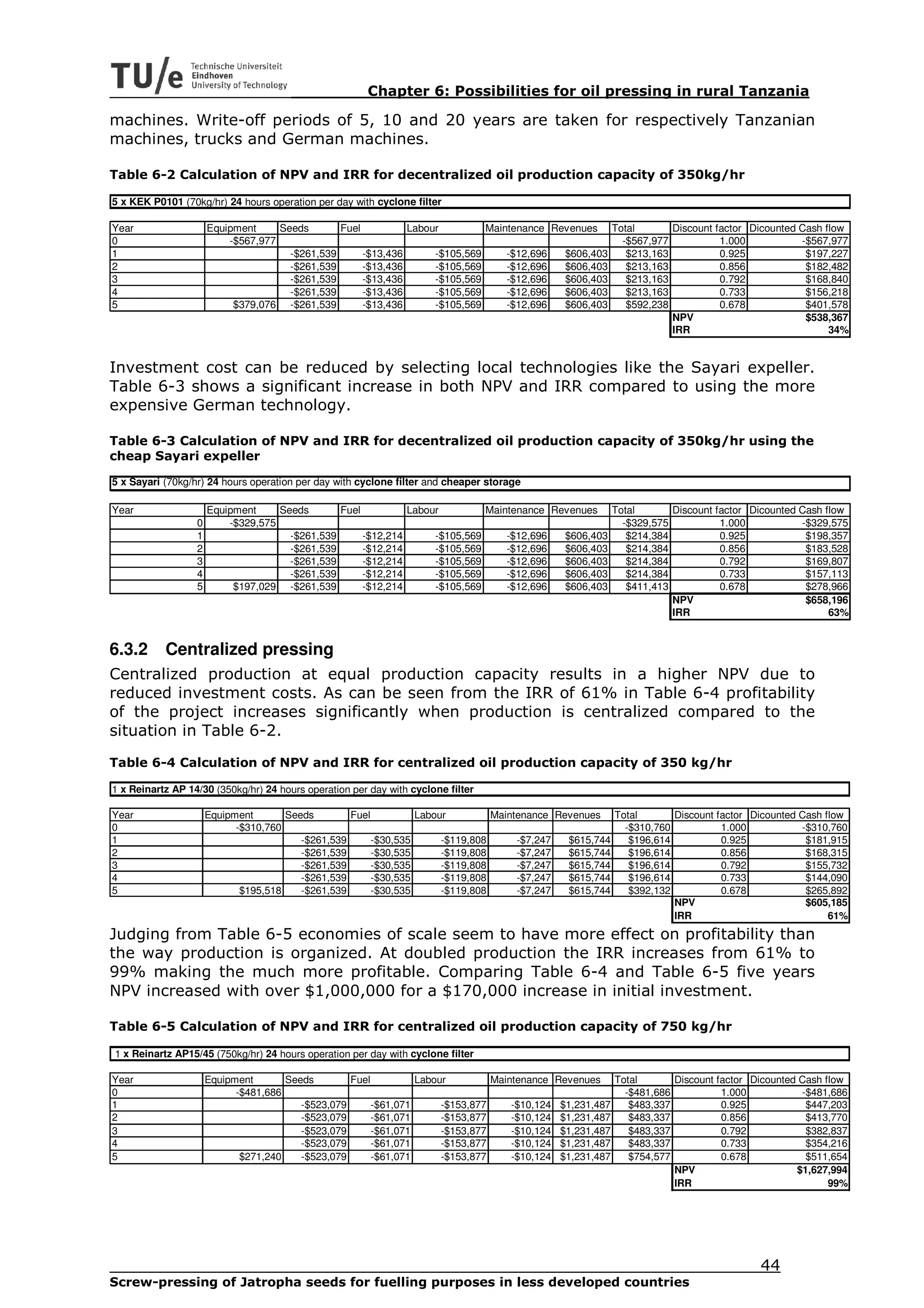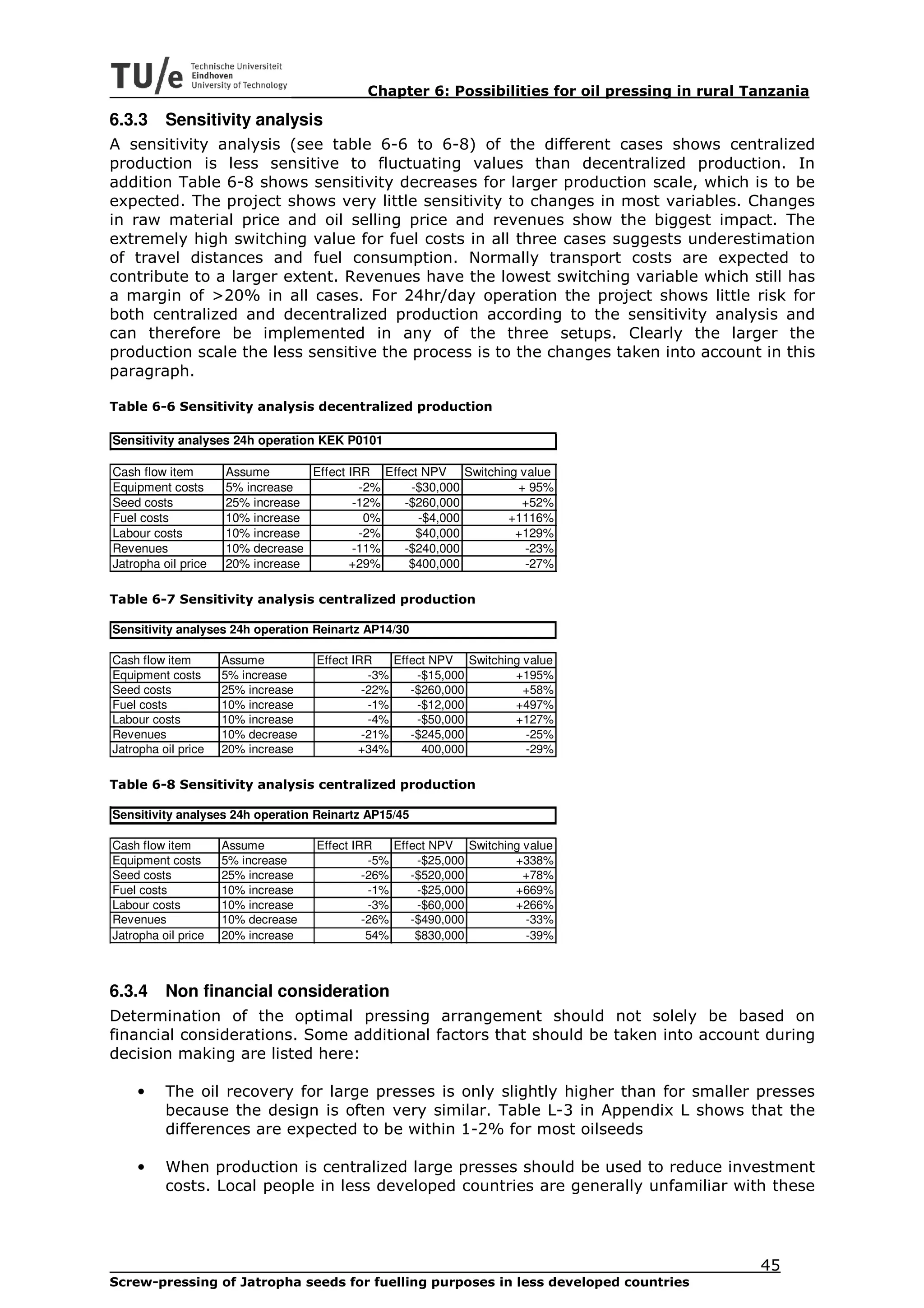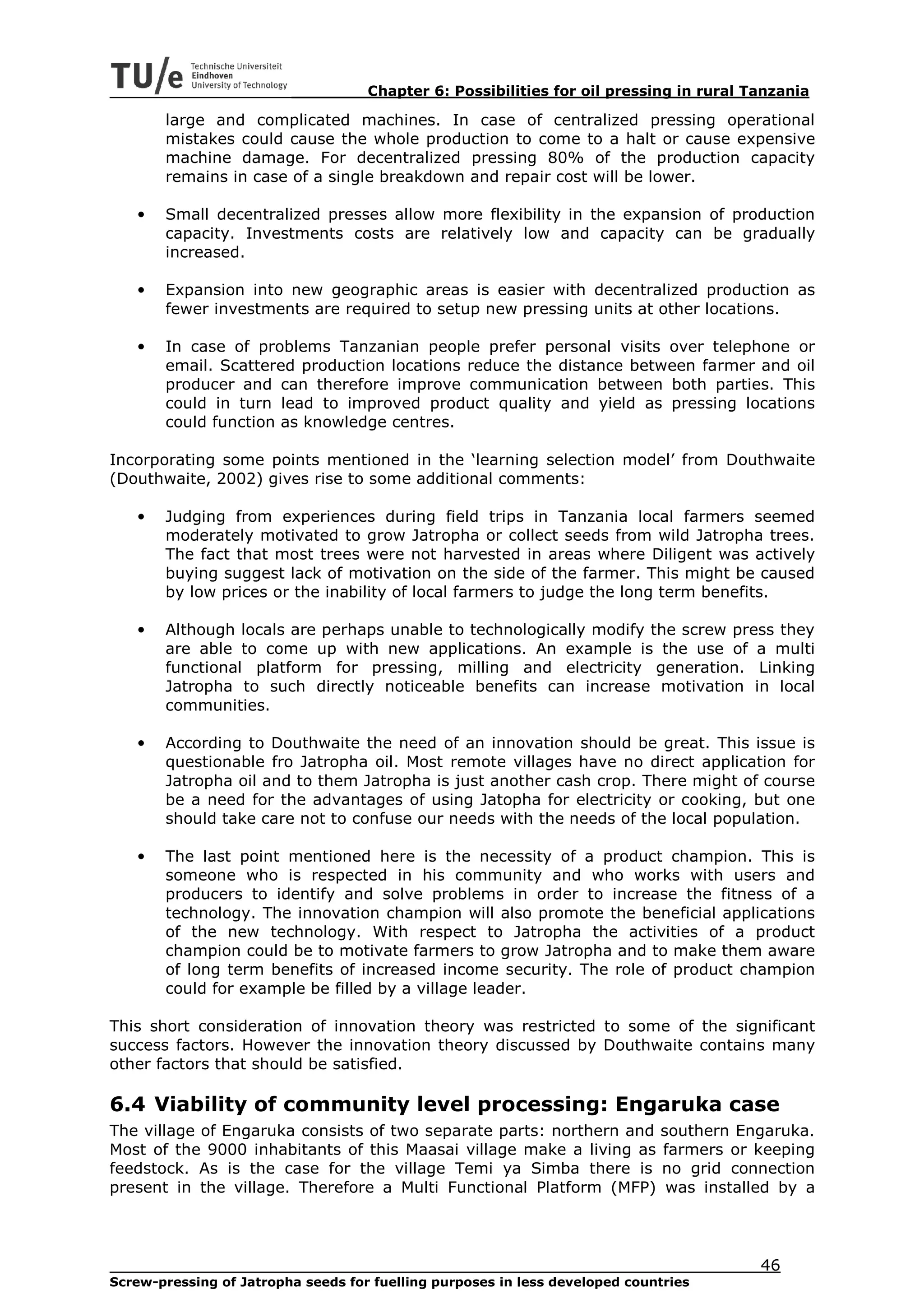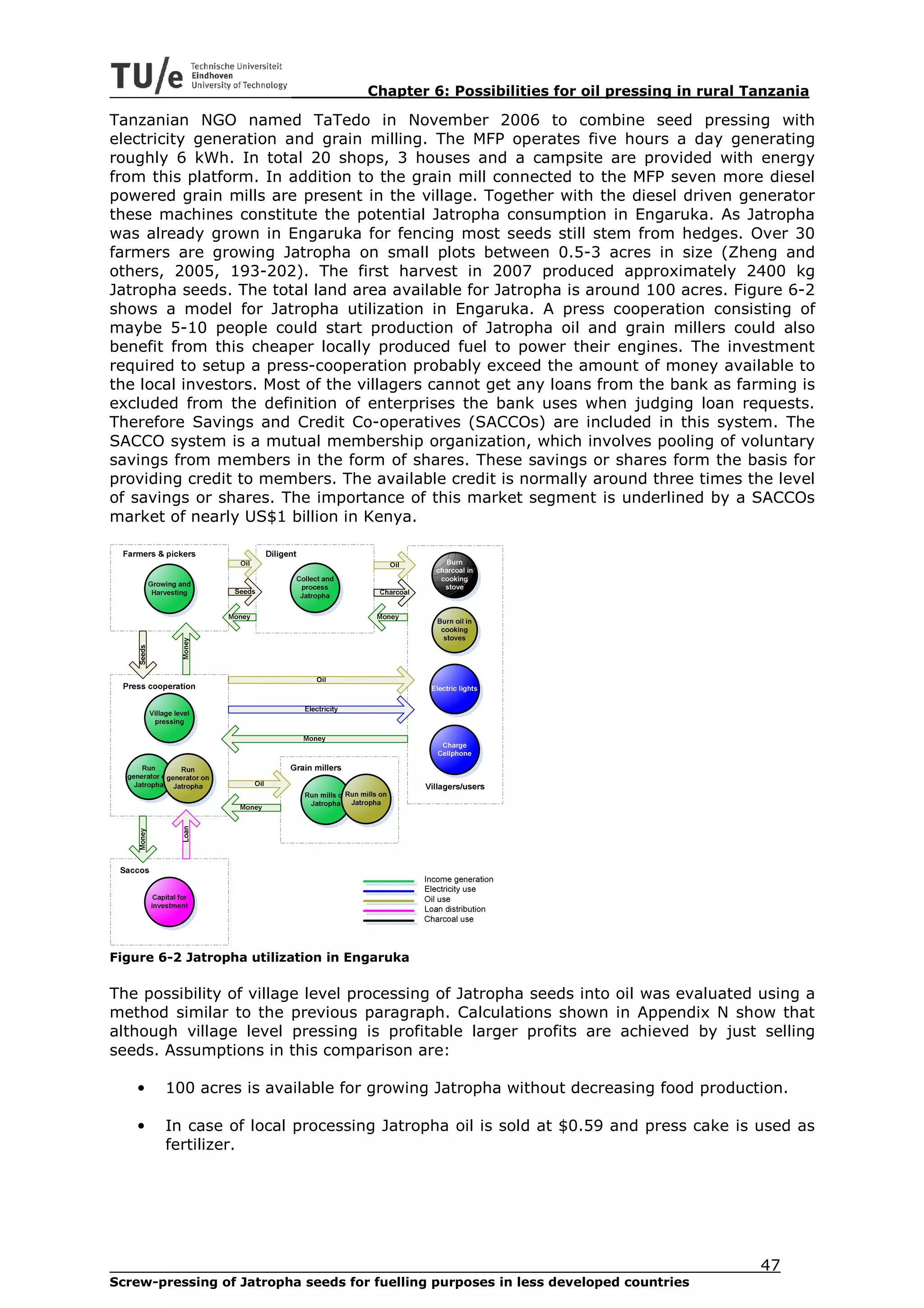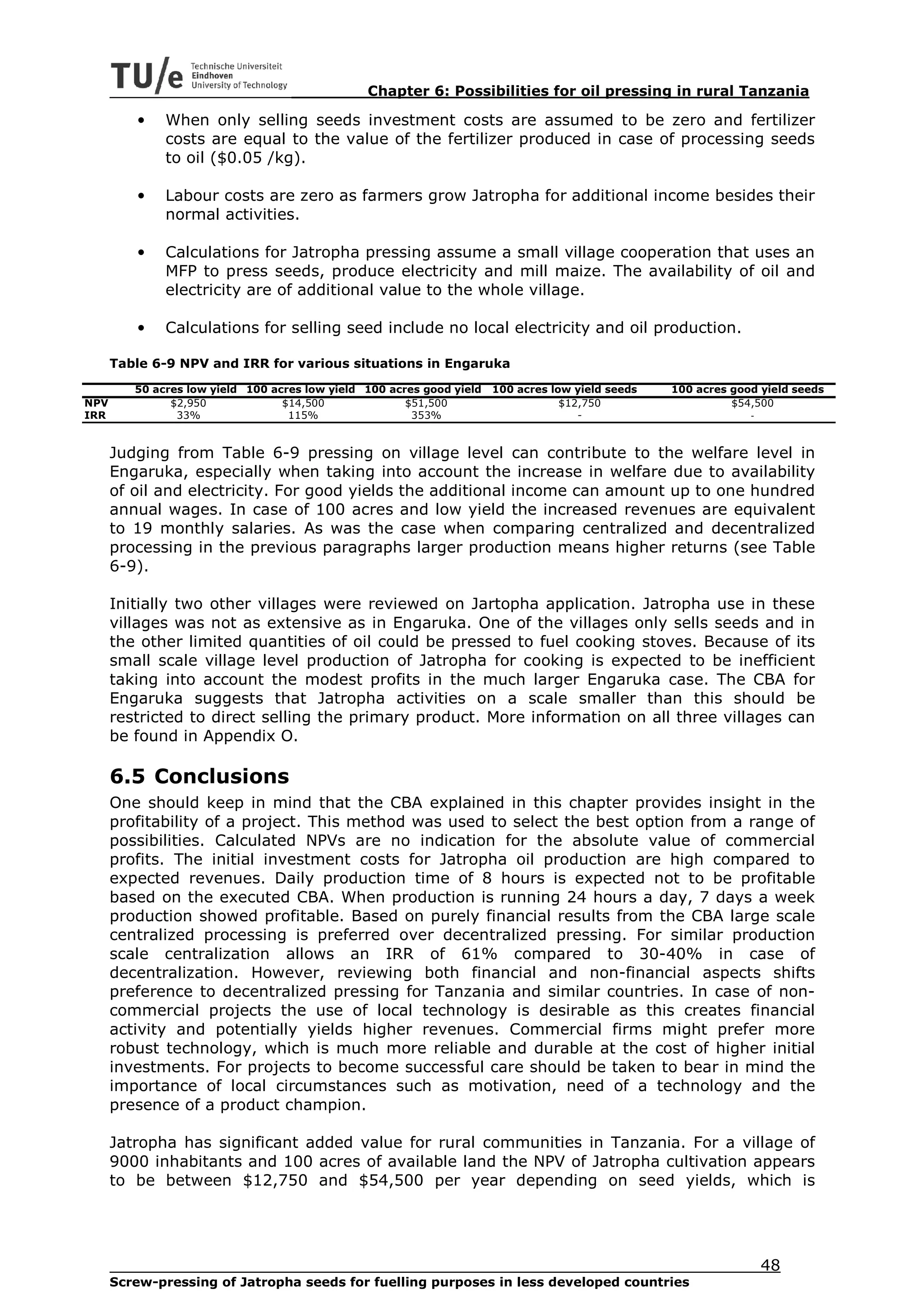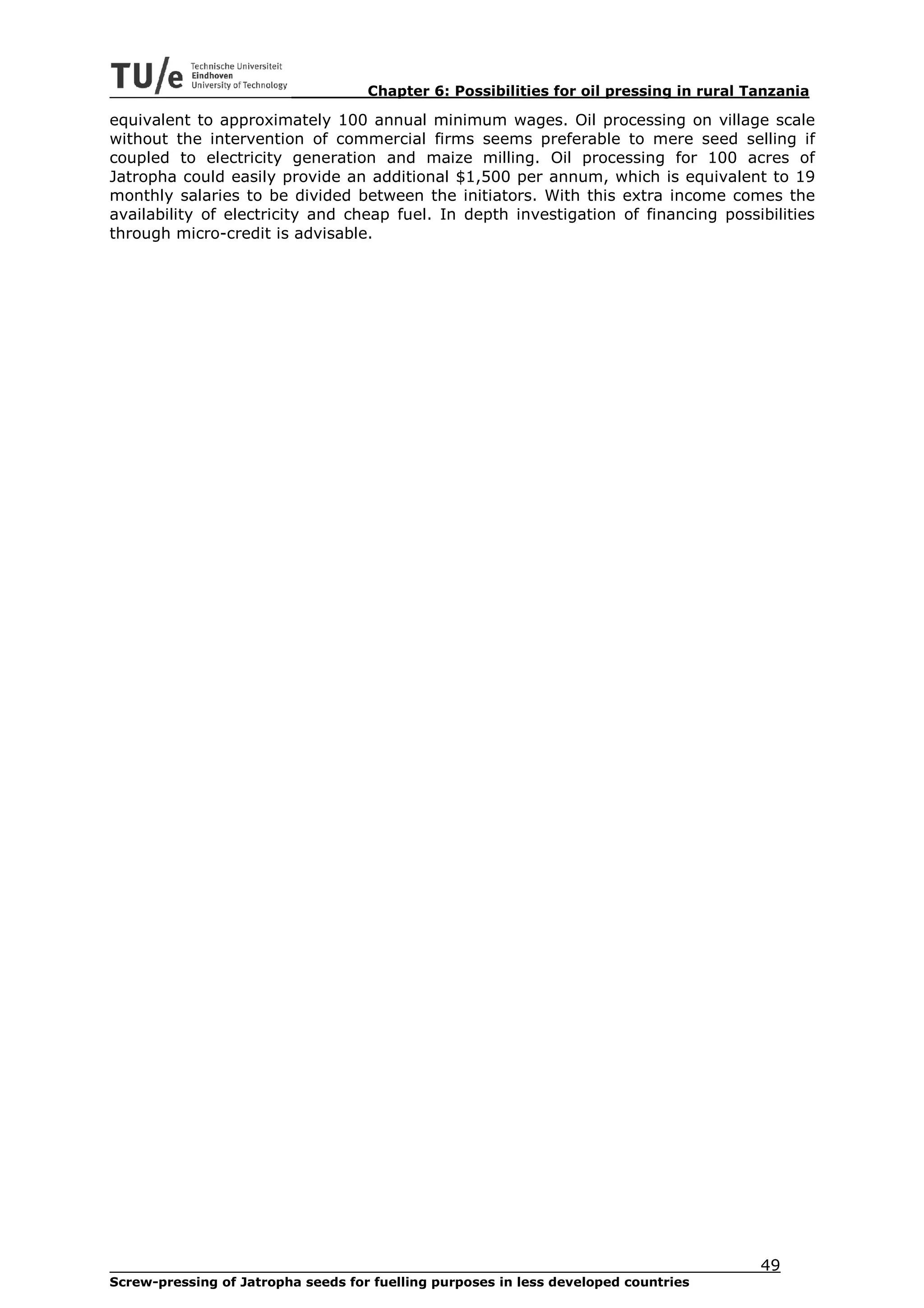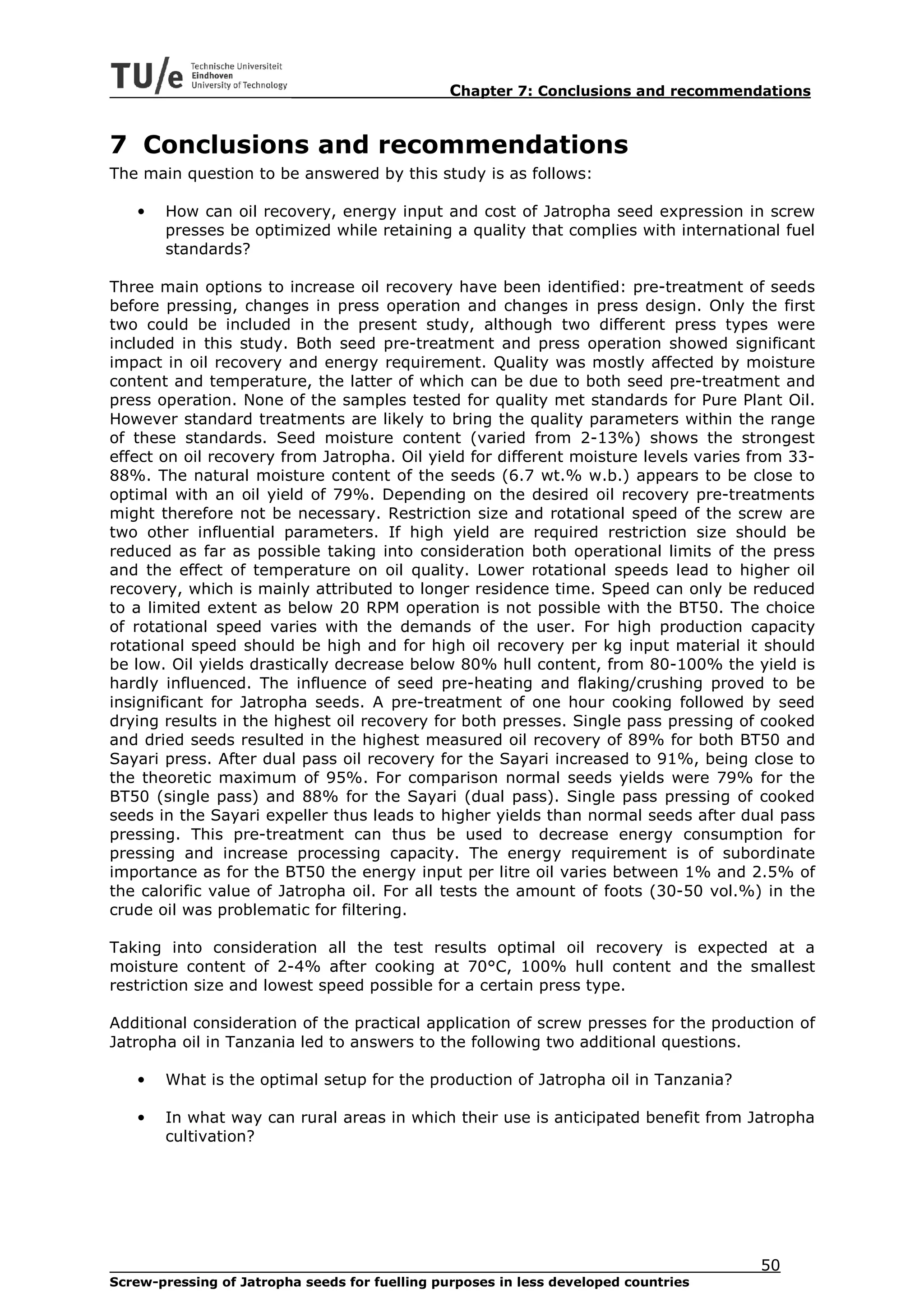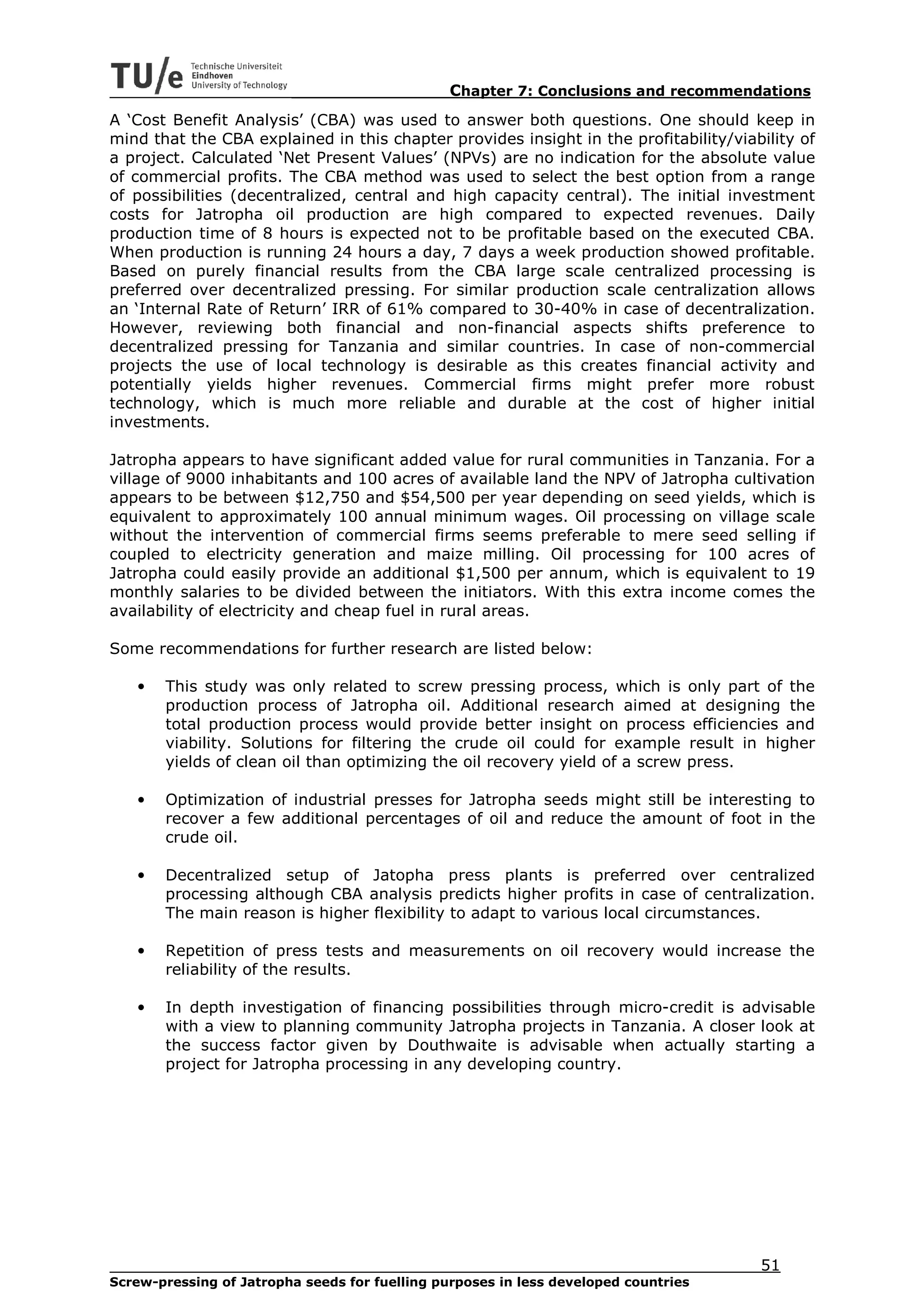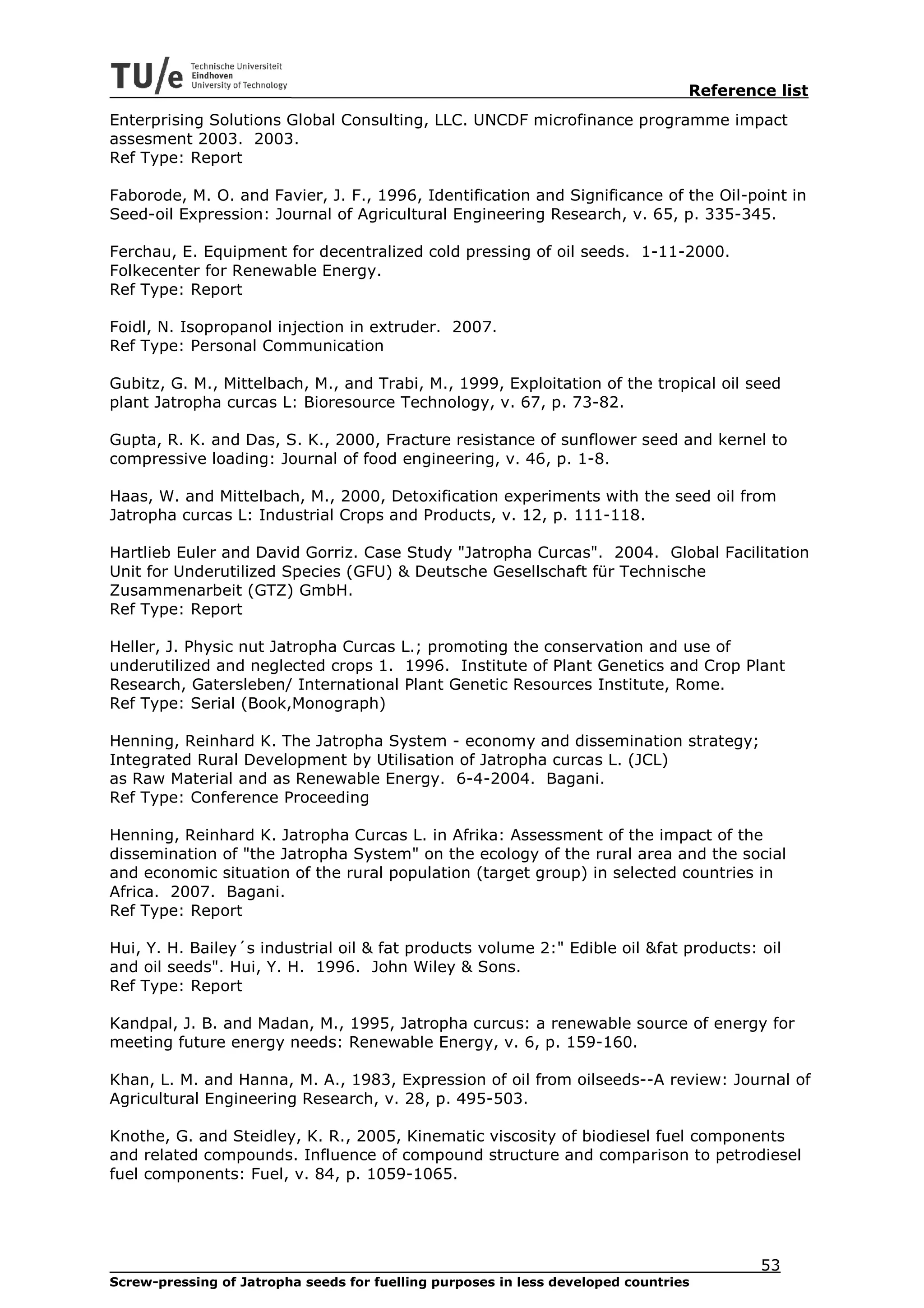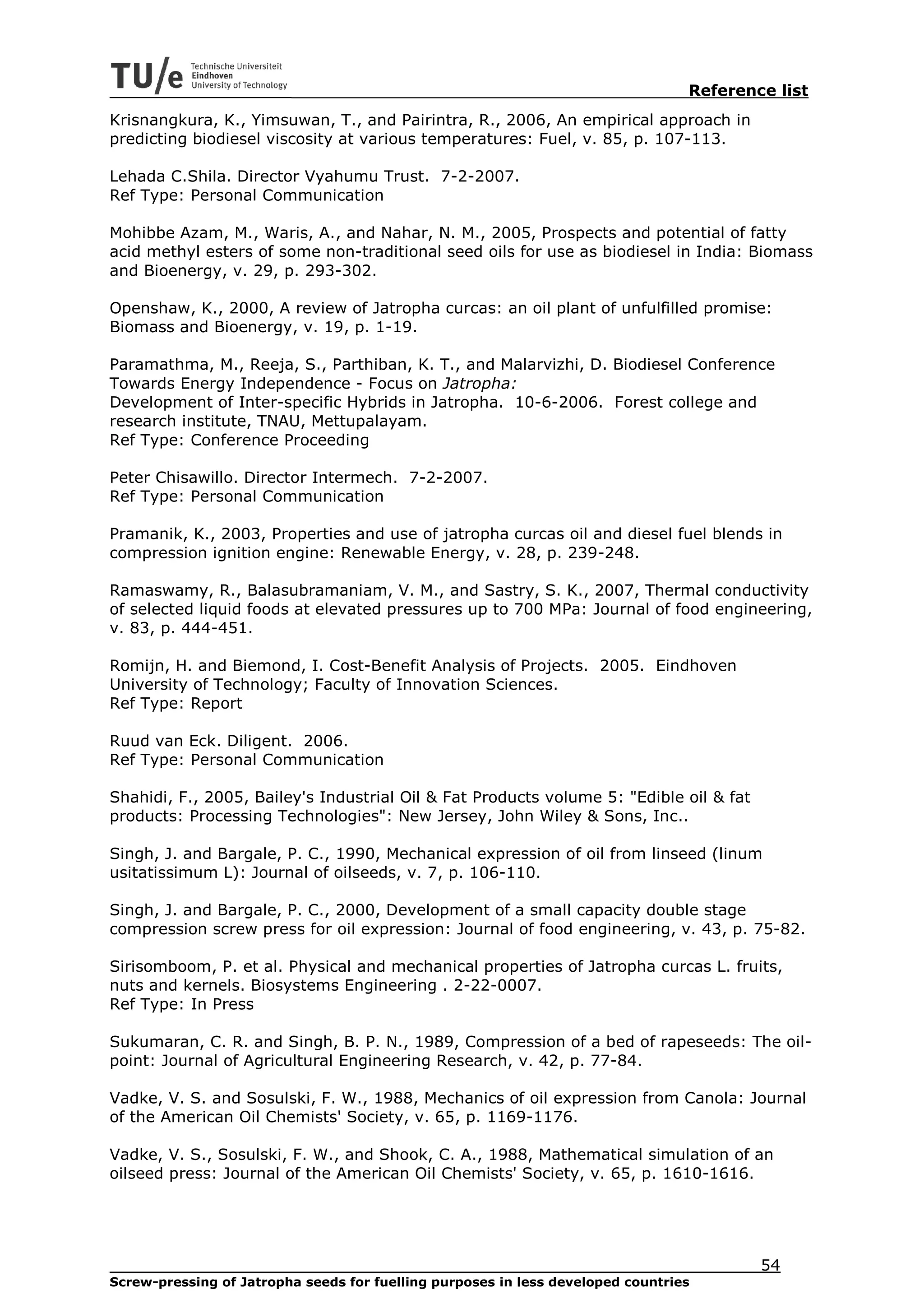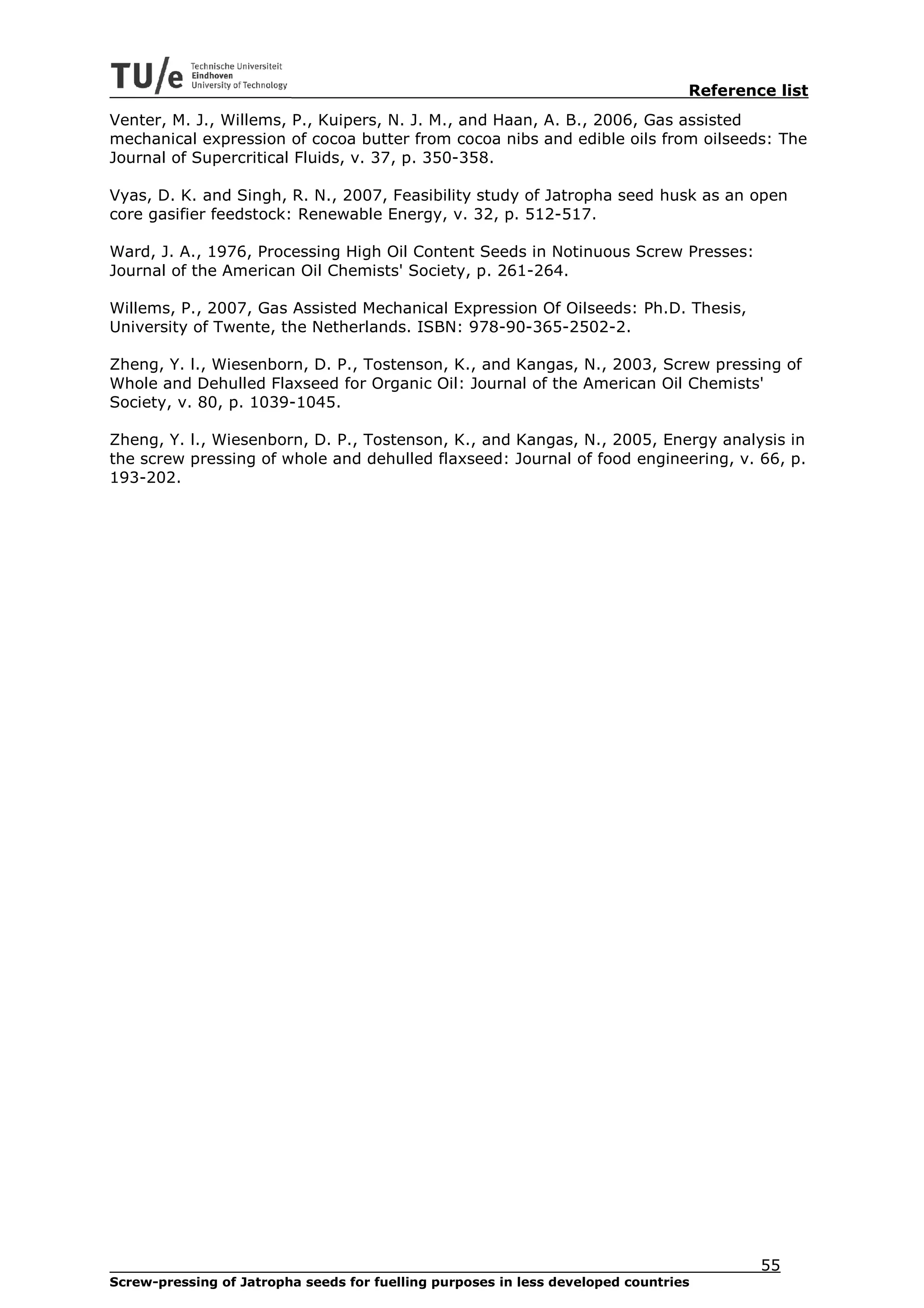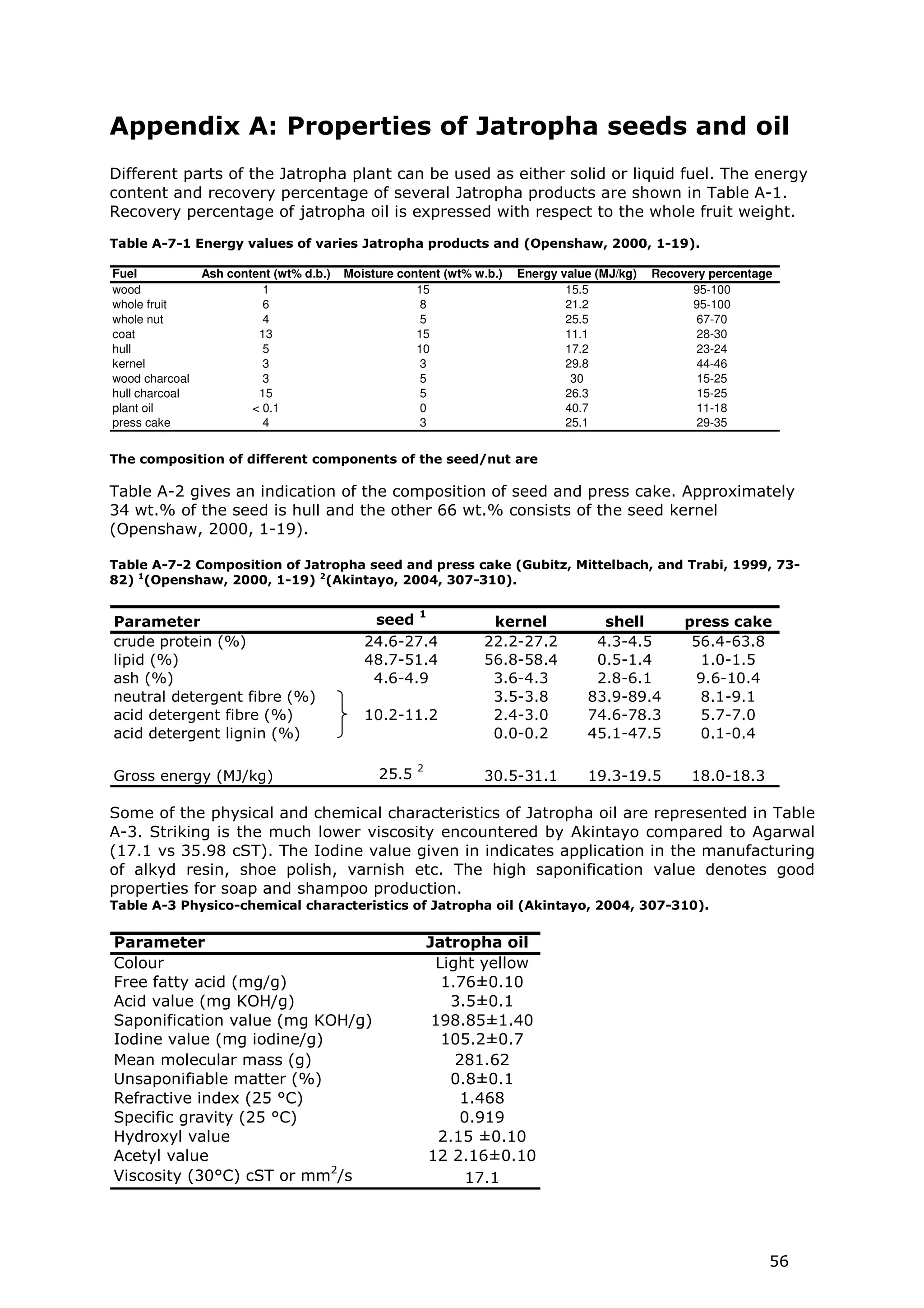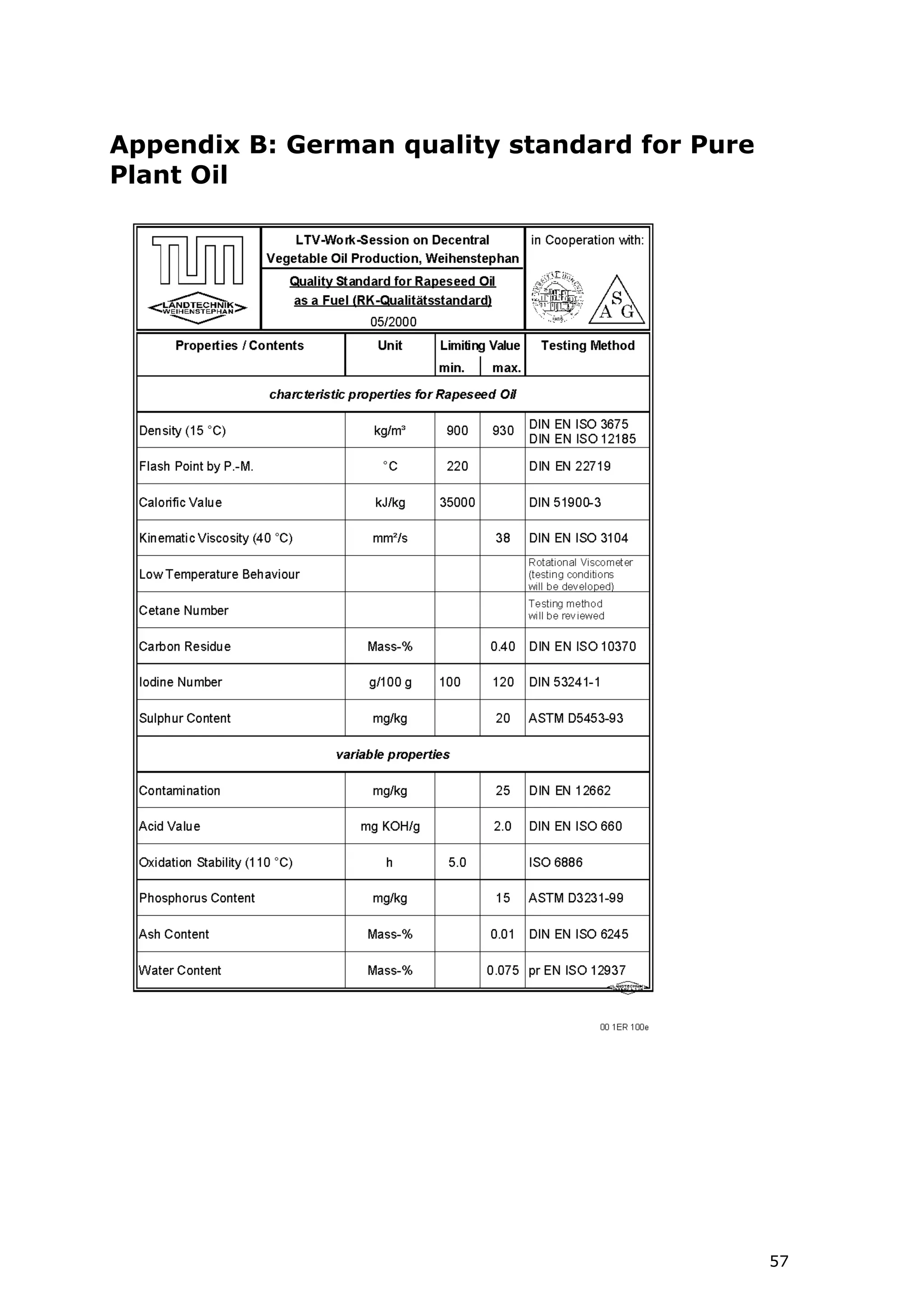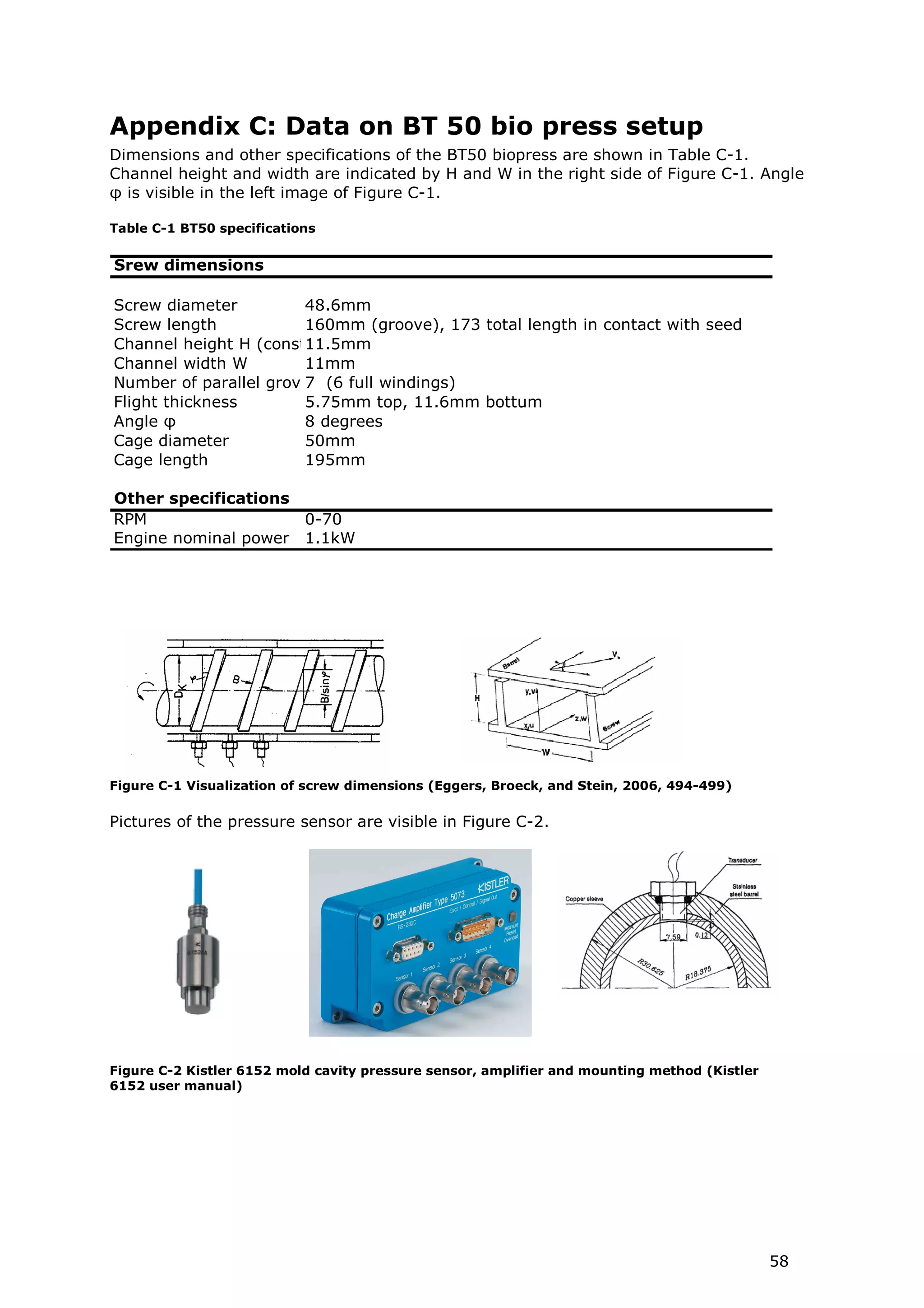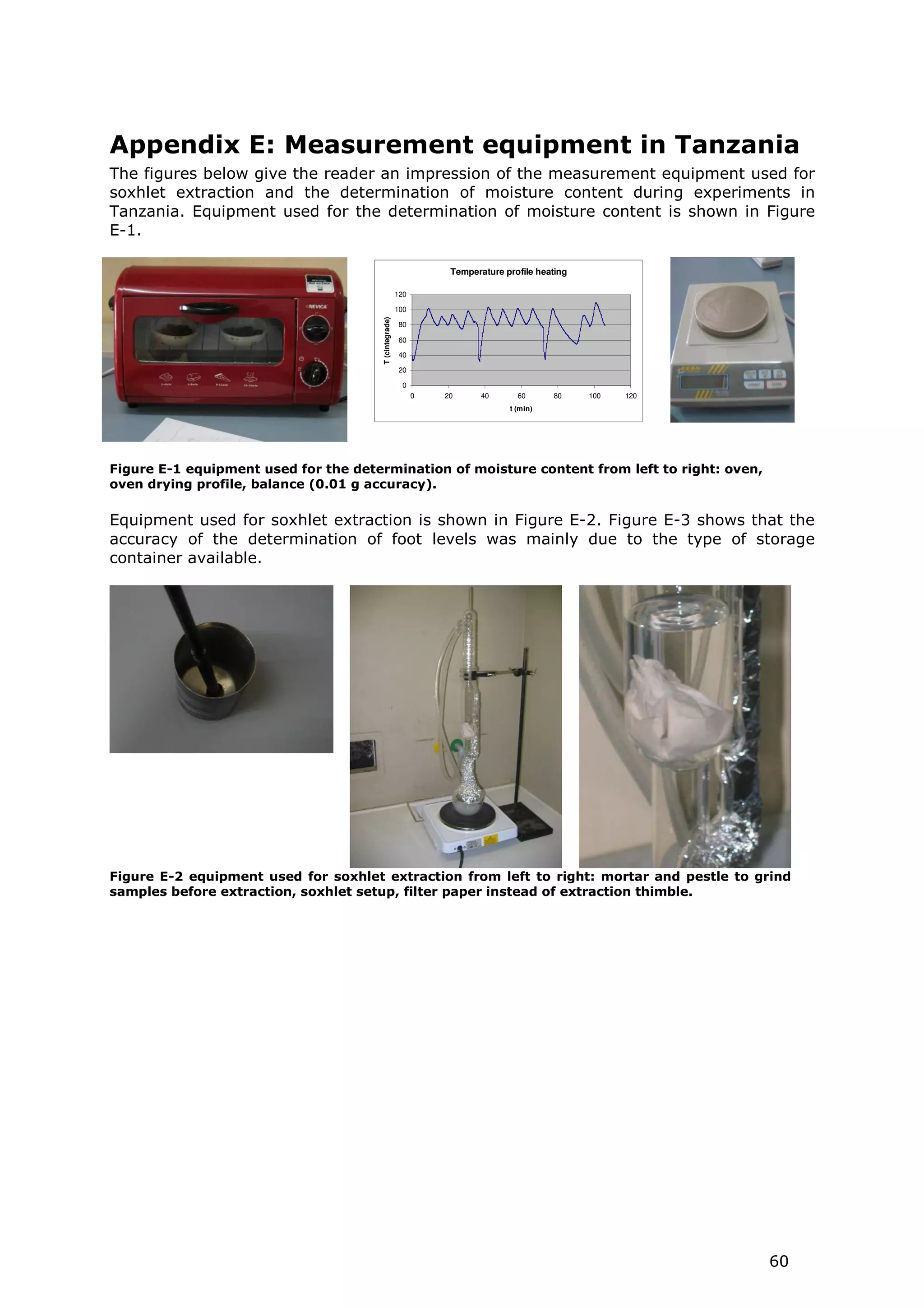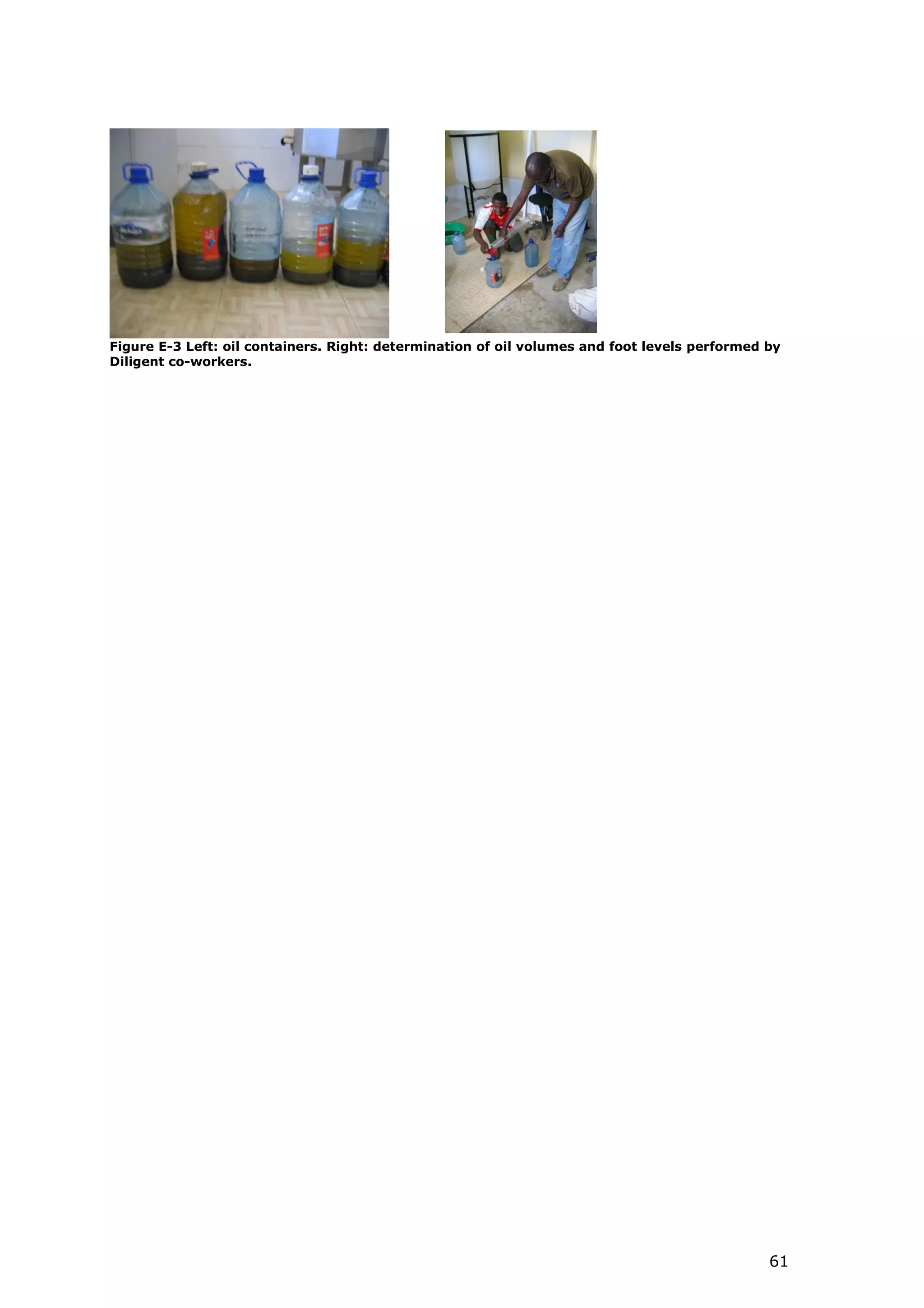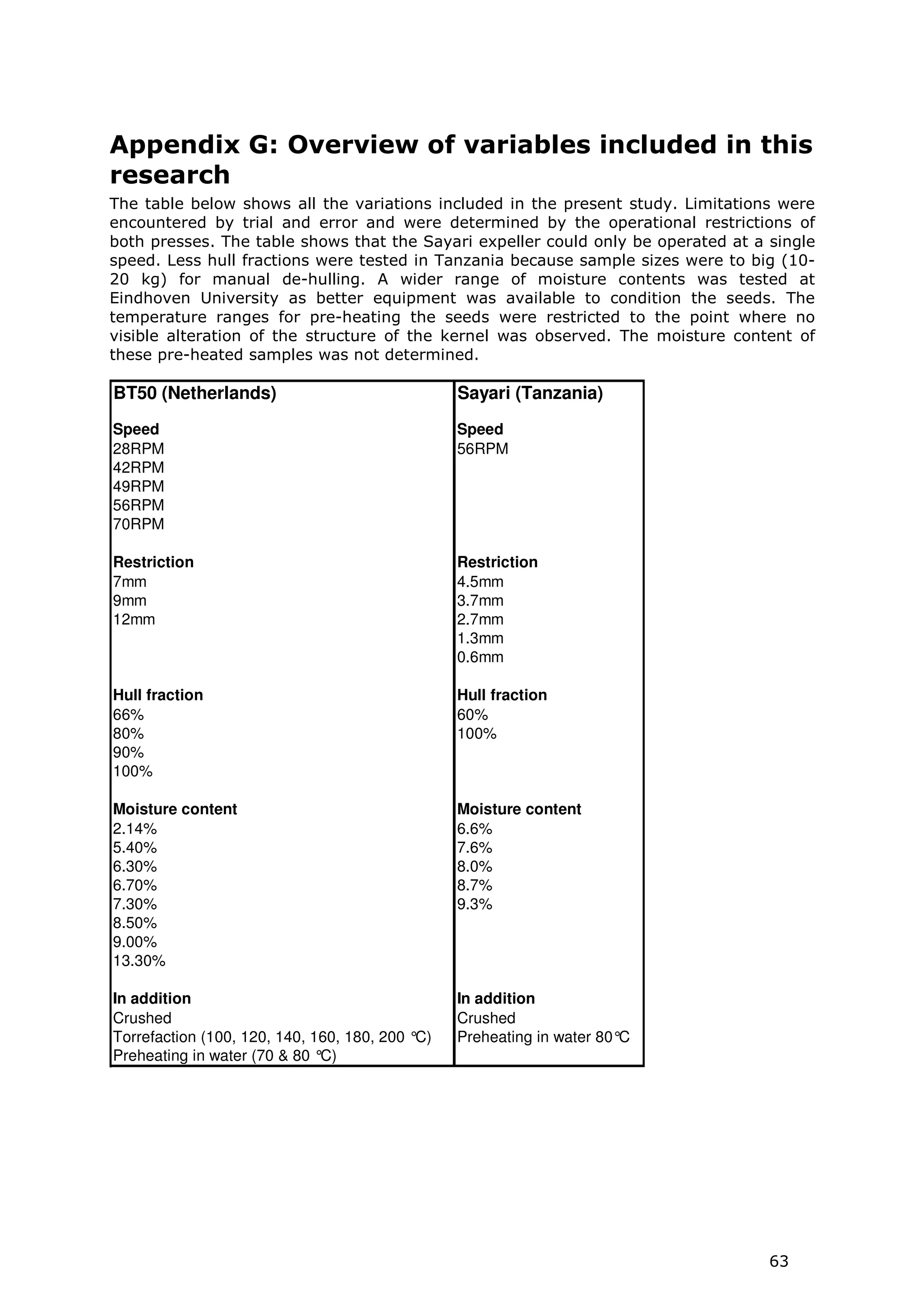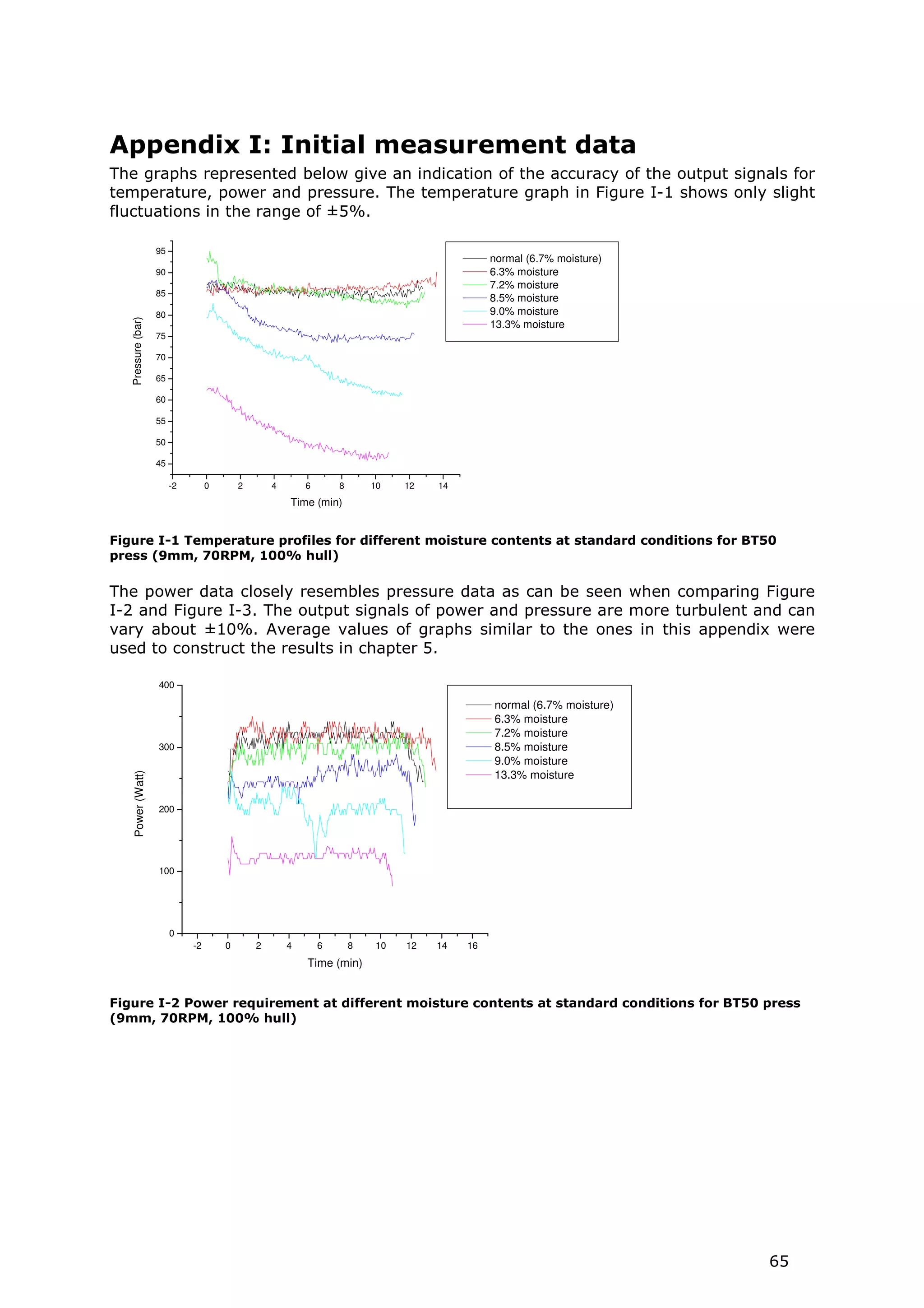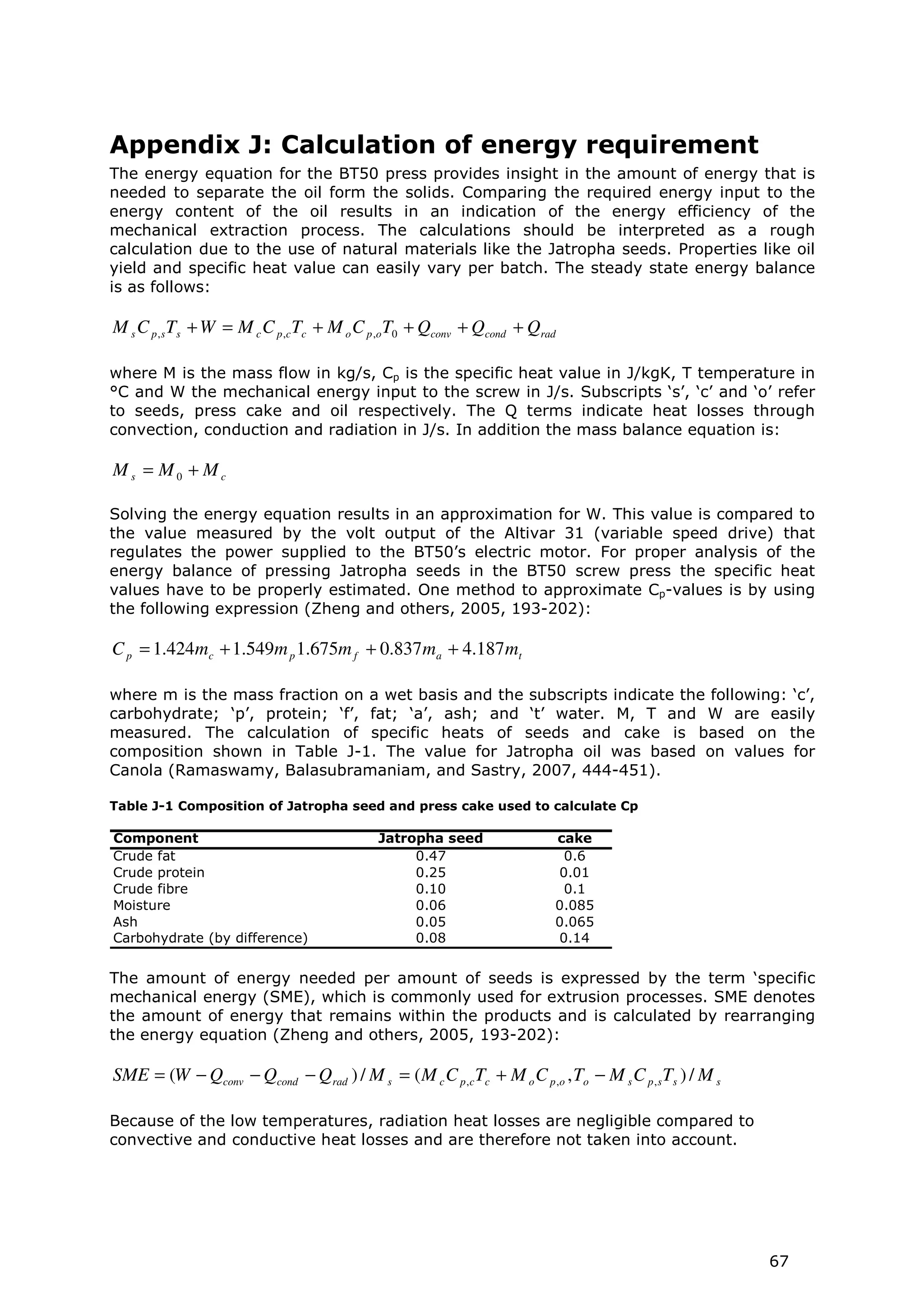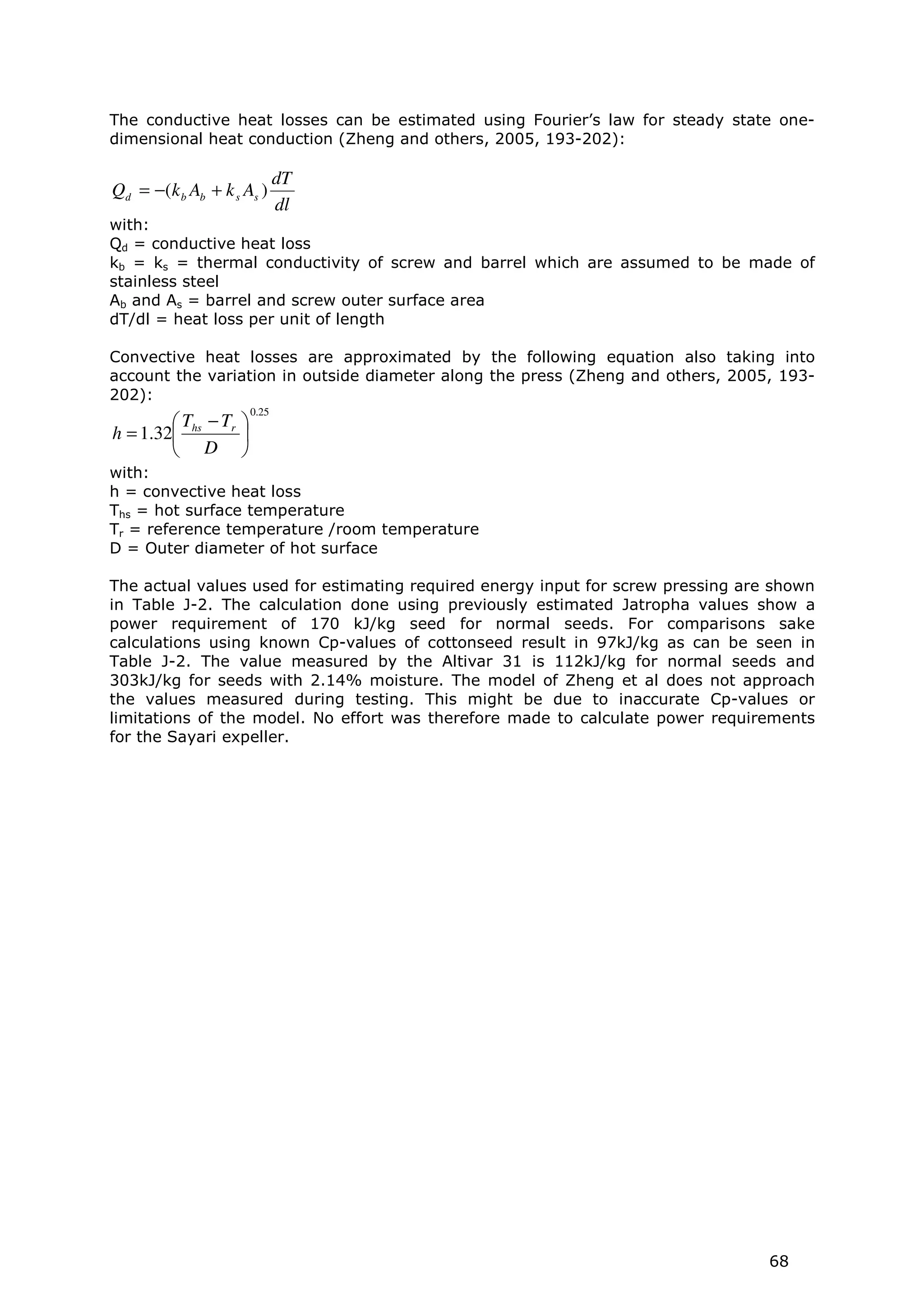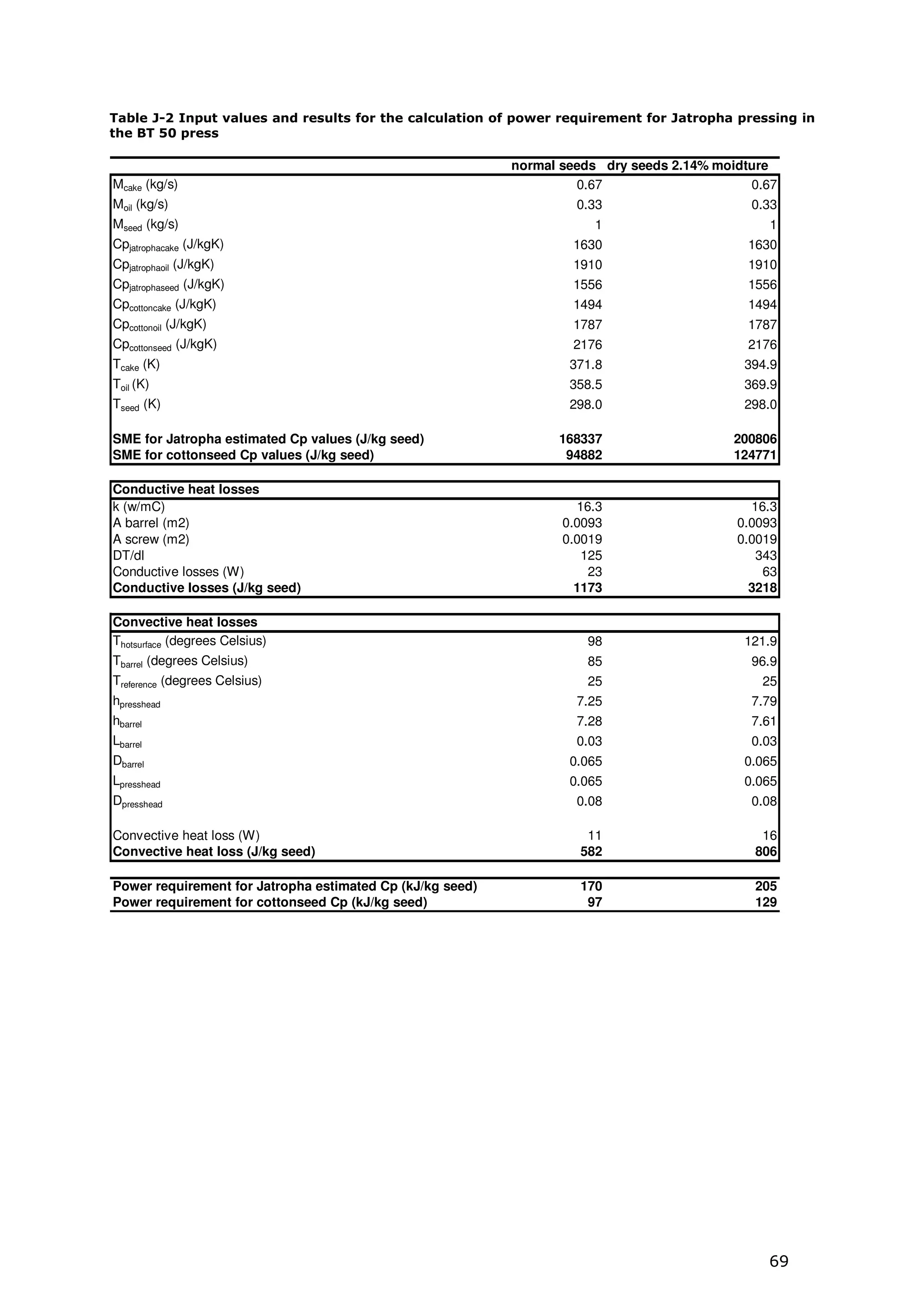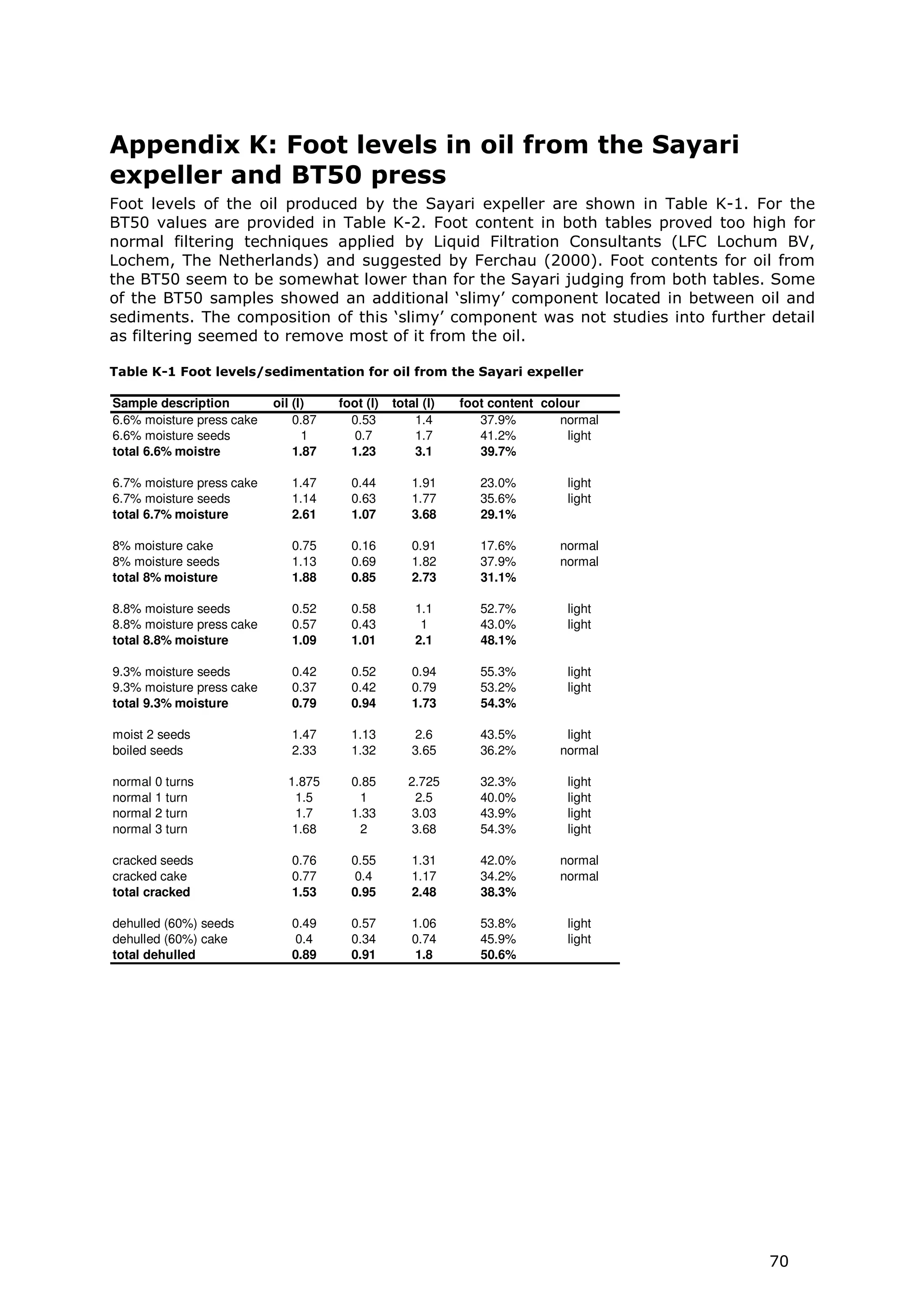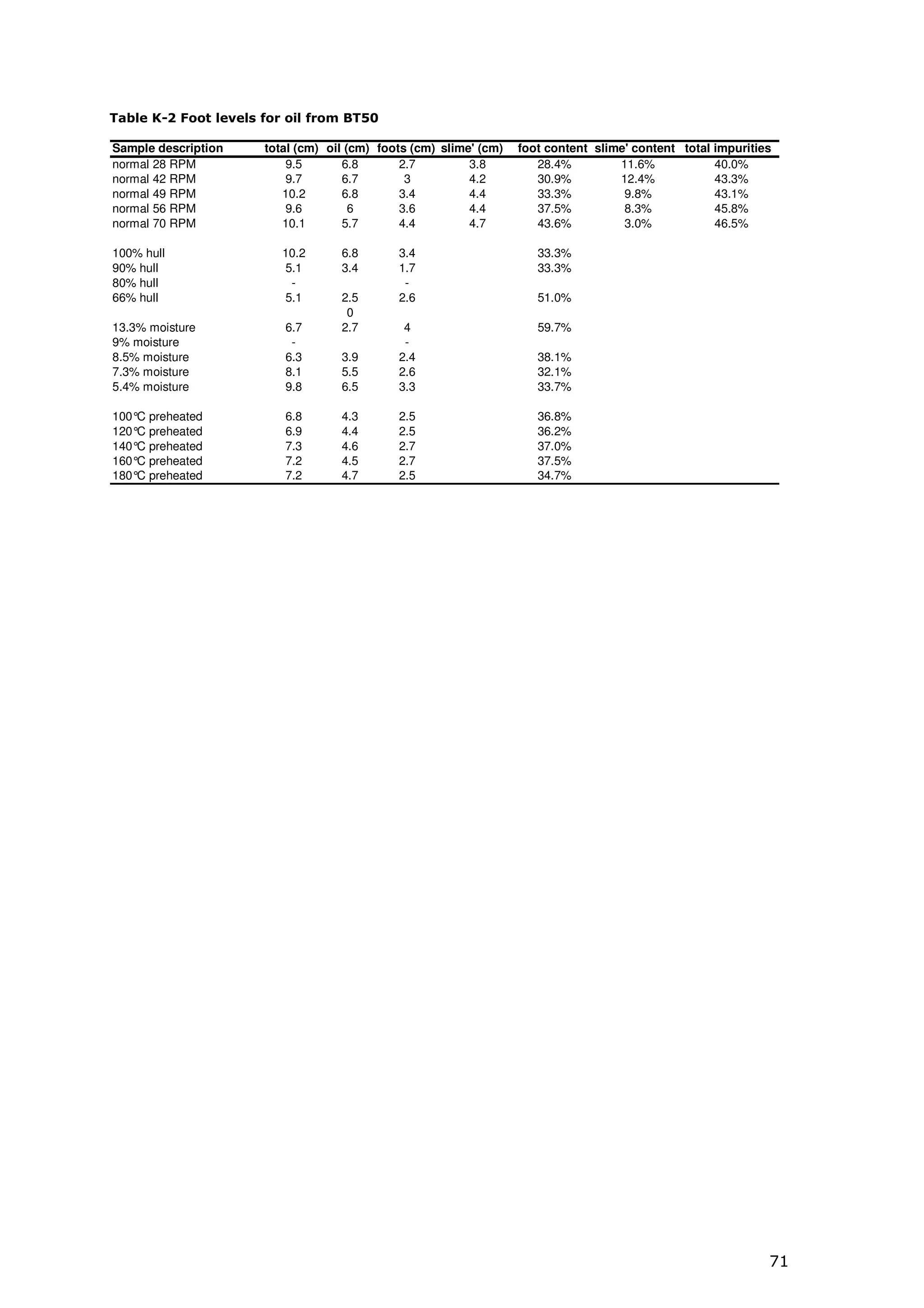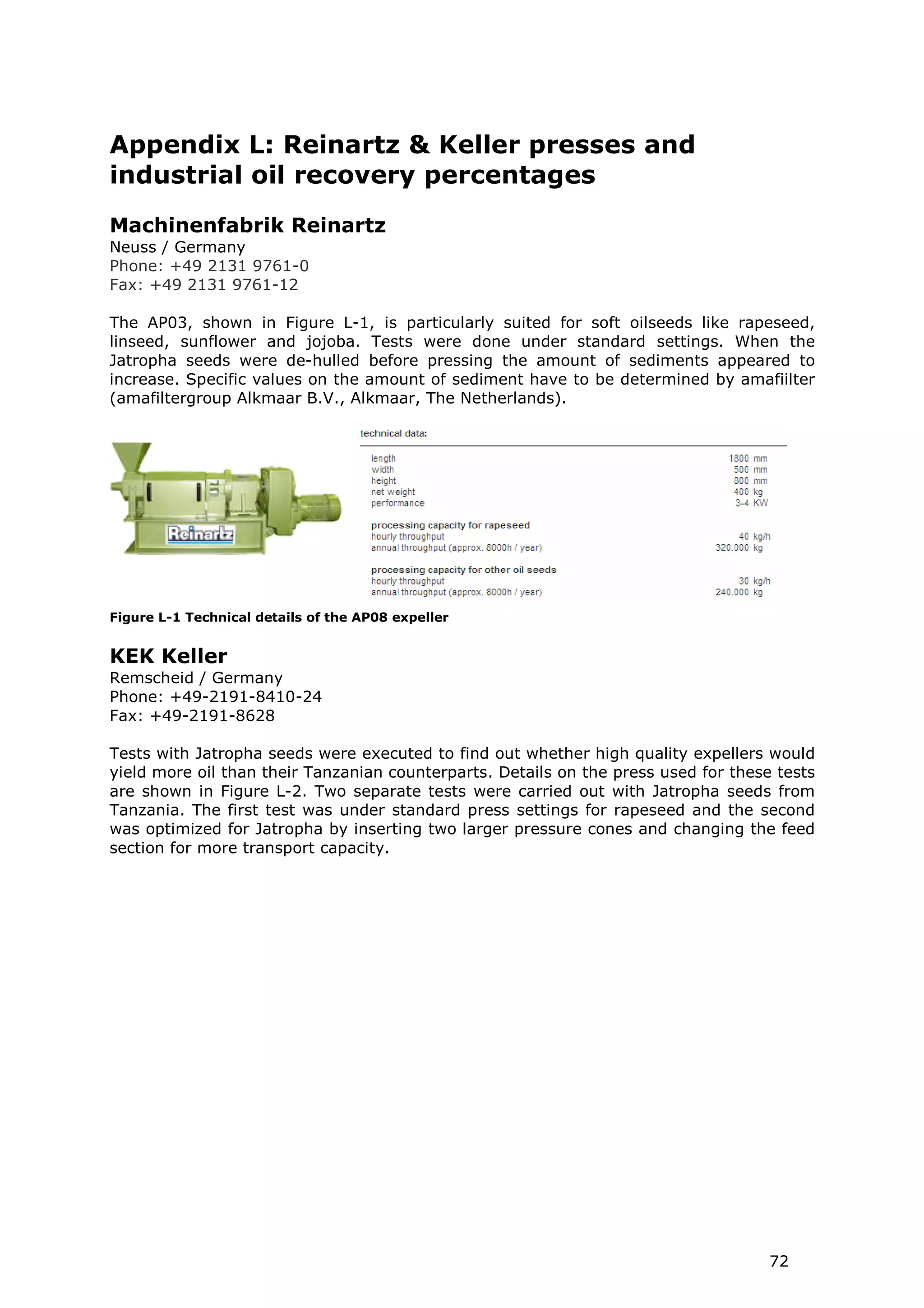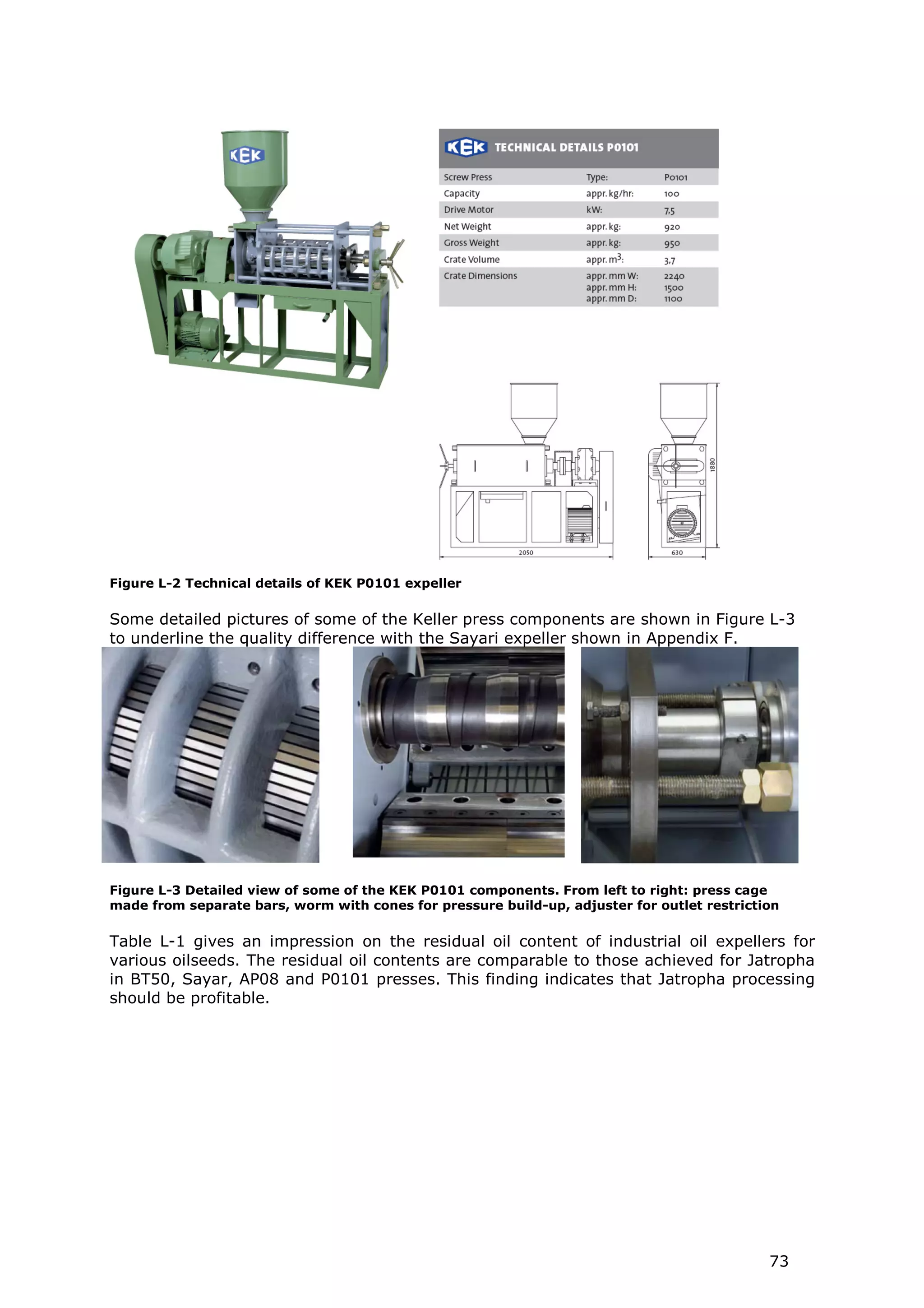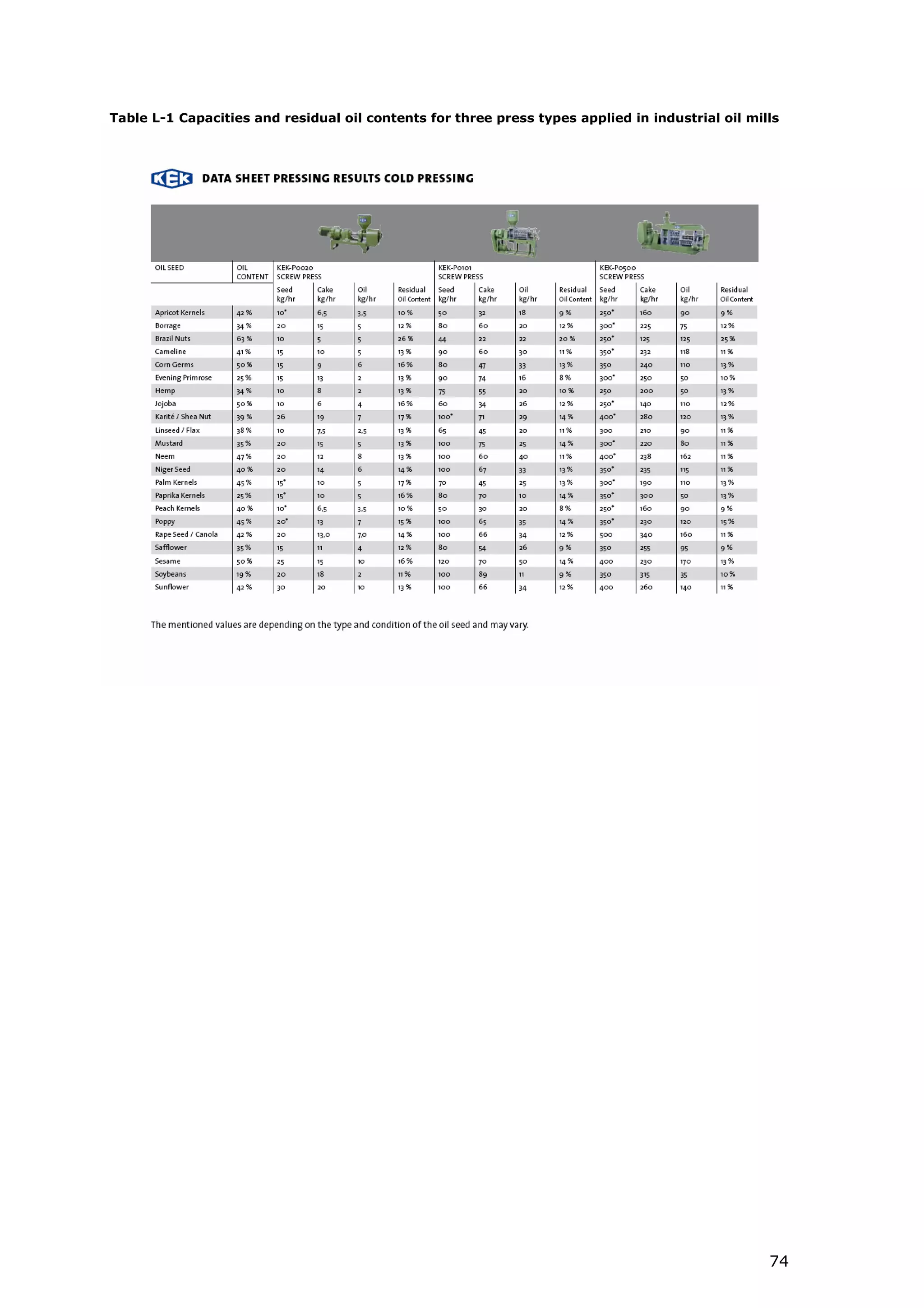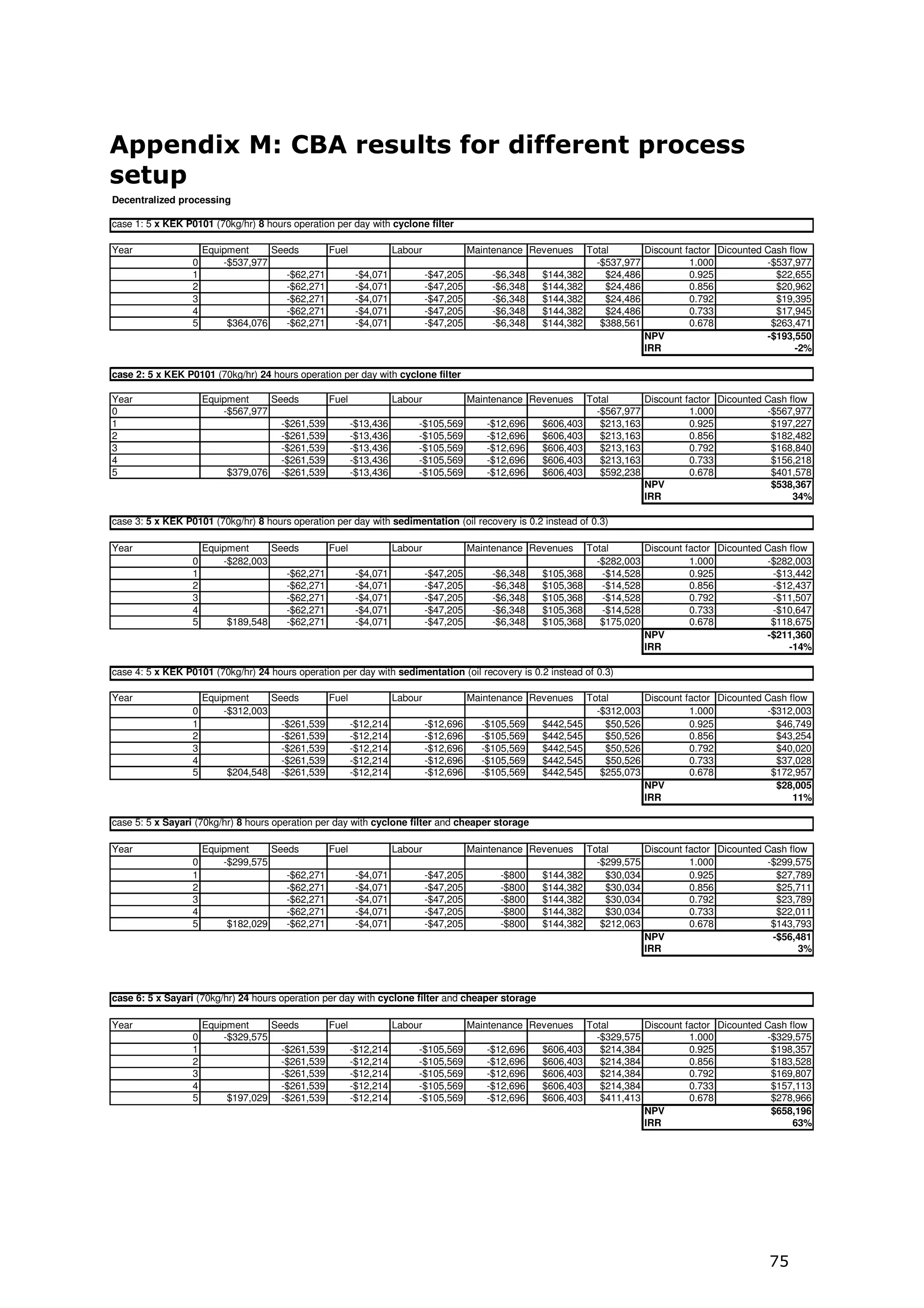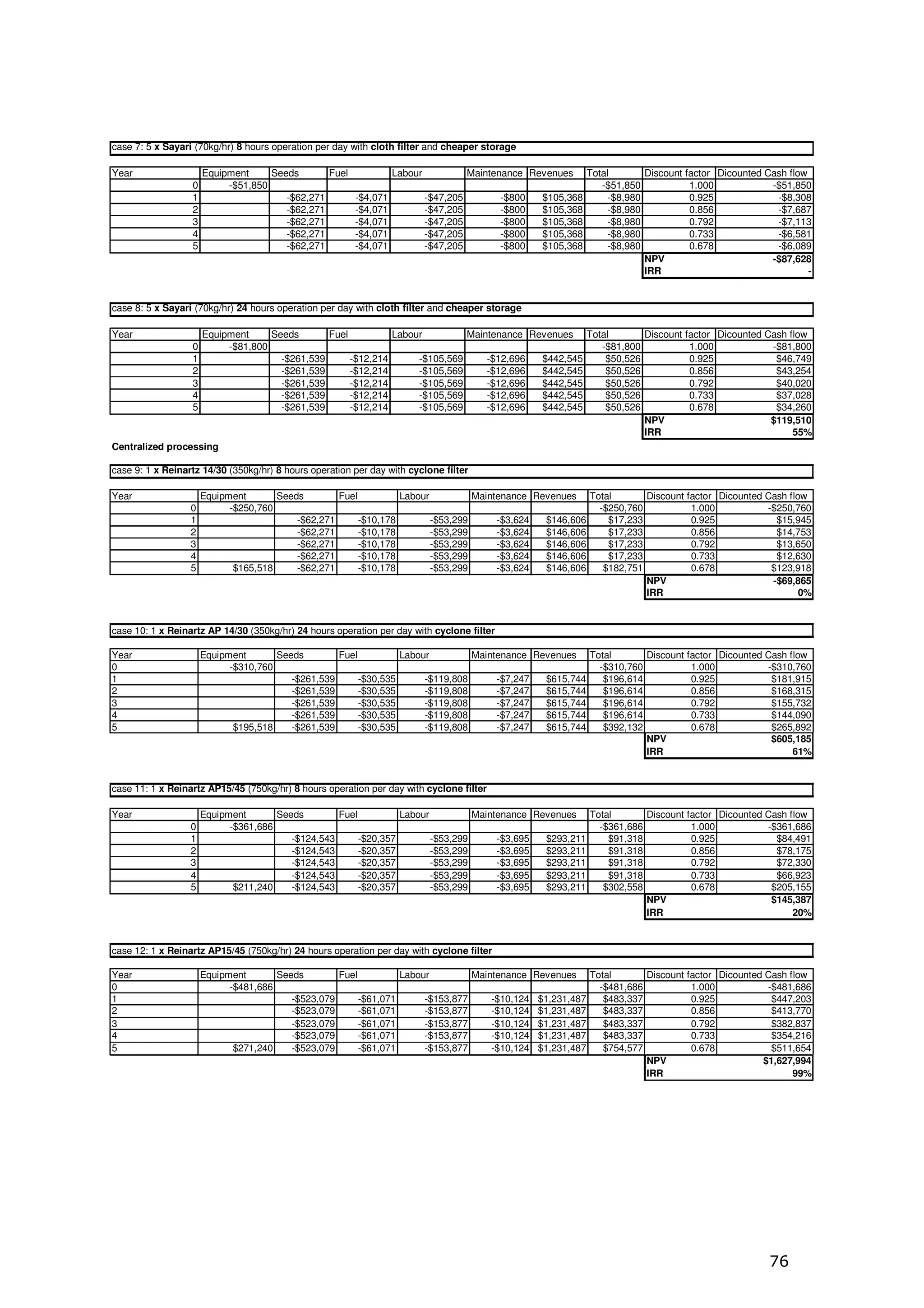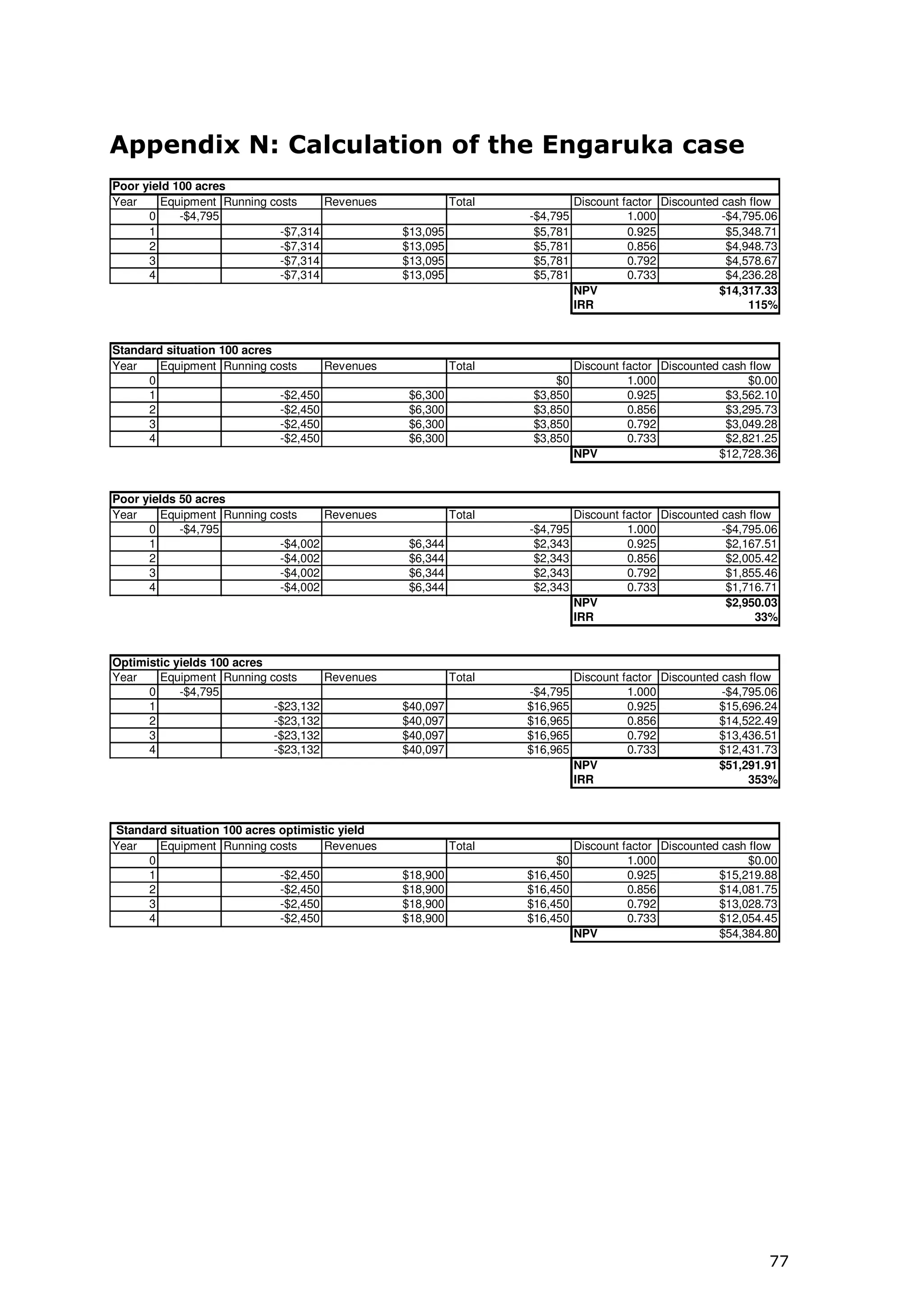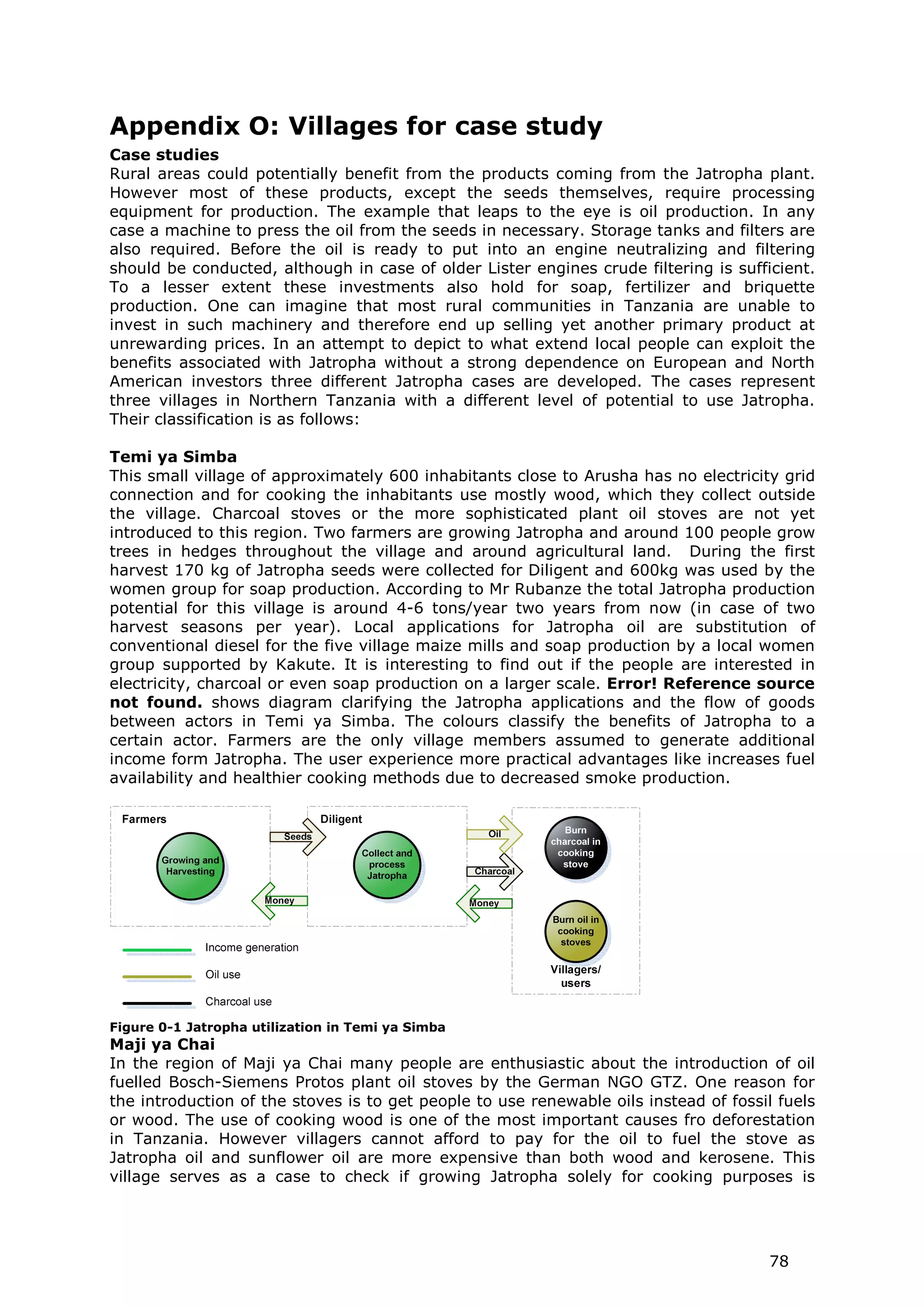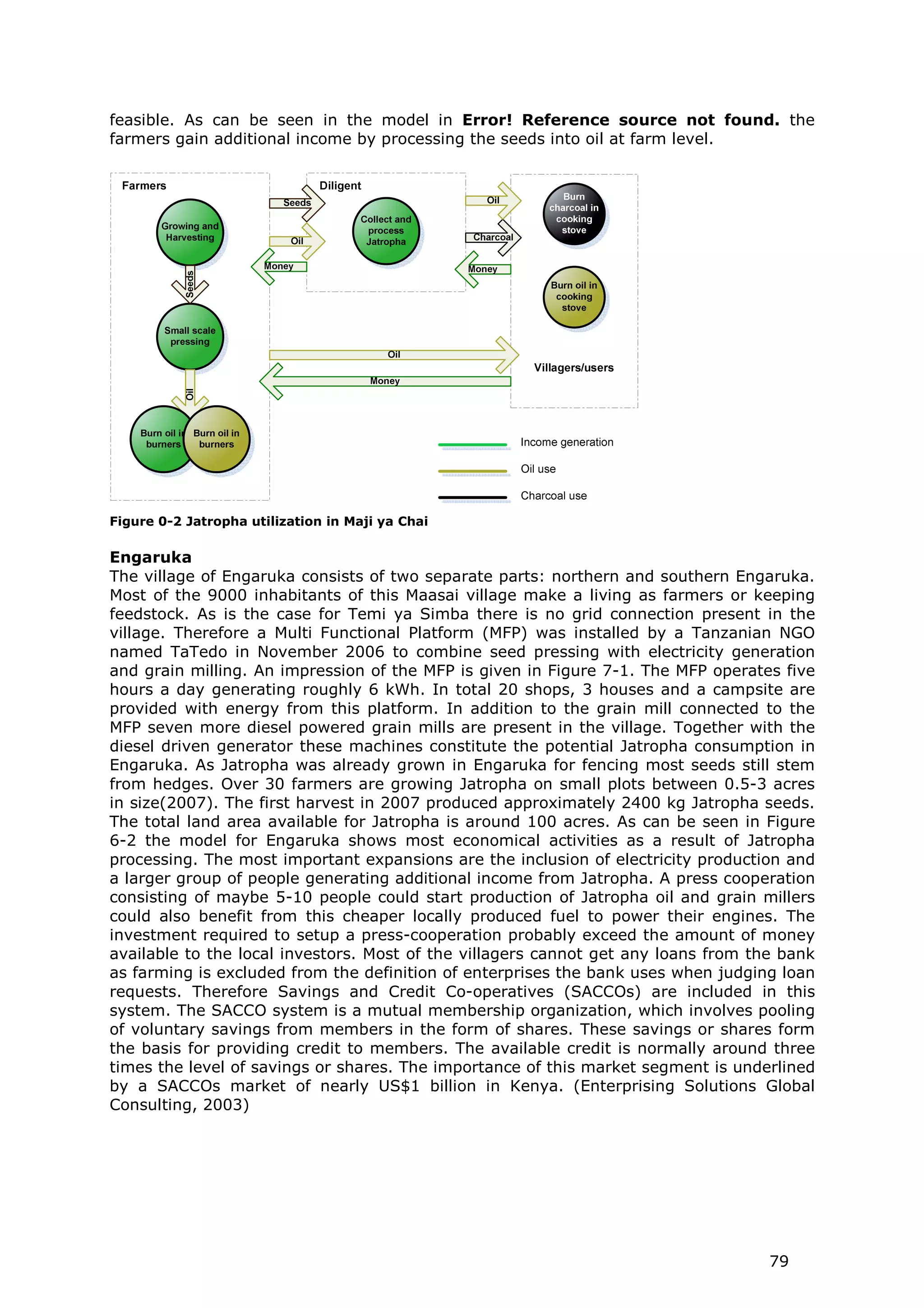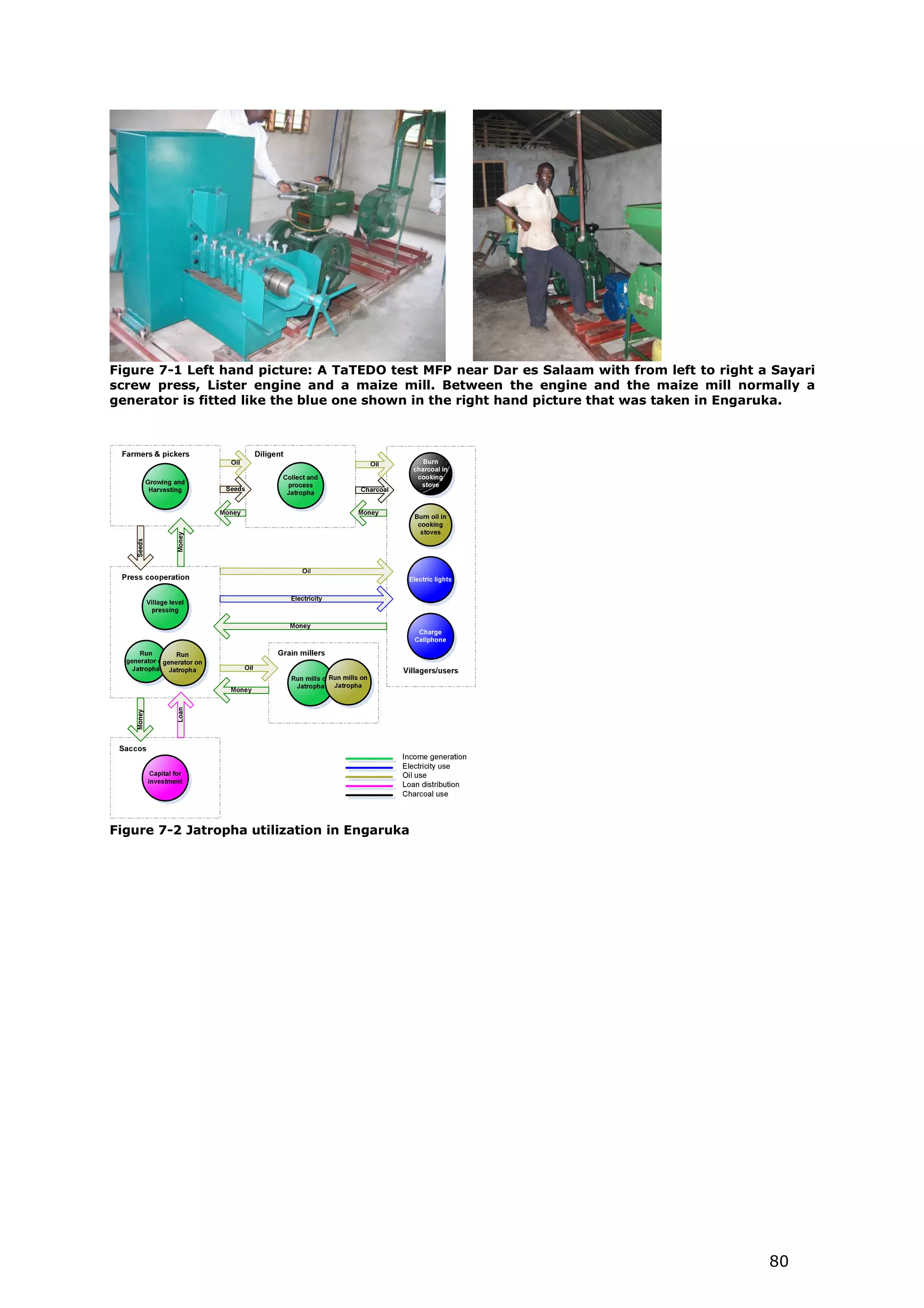This document summarizes a thesis that studied screw-pressing Jatropha seeds to optimize oil recovery for fuel production in less developed countries. The study evaluated how process parameters like moisture content, restriction size, rotational speed, and seed pre-treatment affect oil recovery, energy input, and cost. Tests were conducted on two screw presses in the Netherlands and Tanzania. The highest oil recoveries of 89% and 91% resulted from seeds cooked at 70°C for an hour before pressing. In general, higher moisture content, smaller restriction size, lower speed, and pre-heating improved recovery. Based on the results, optimal recovery is expected at 2-4% moisture after cooking, 100% hull content, and the lowest possible
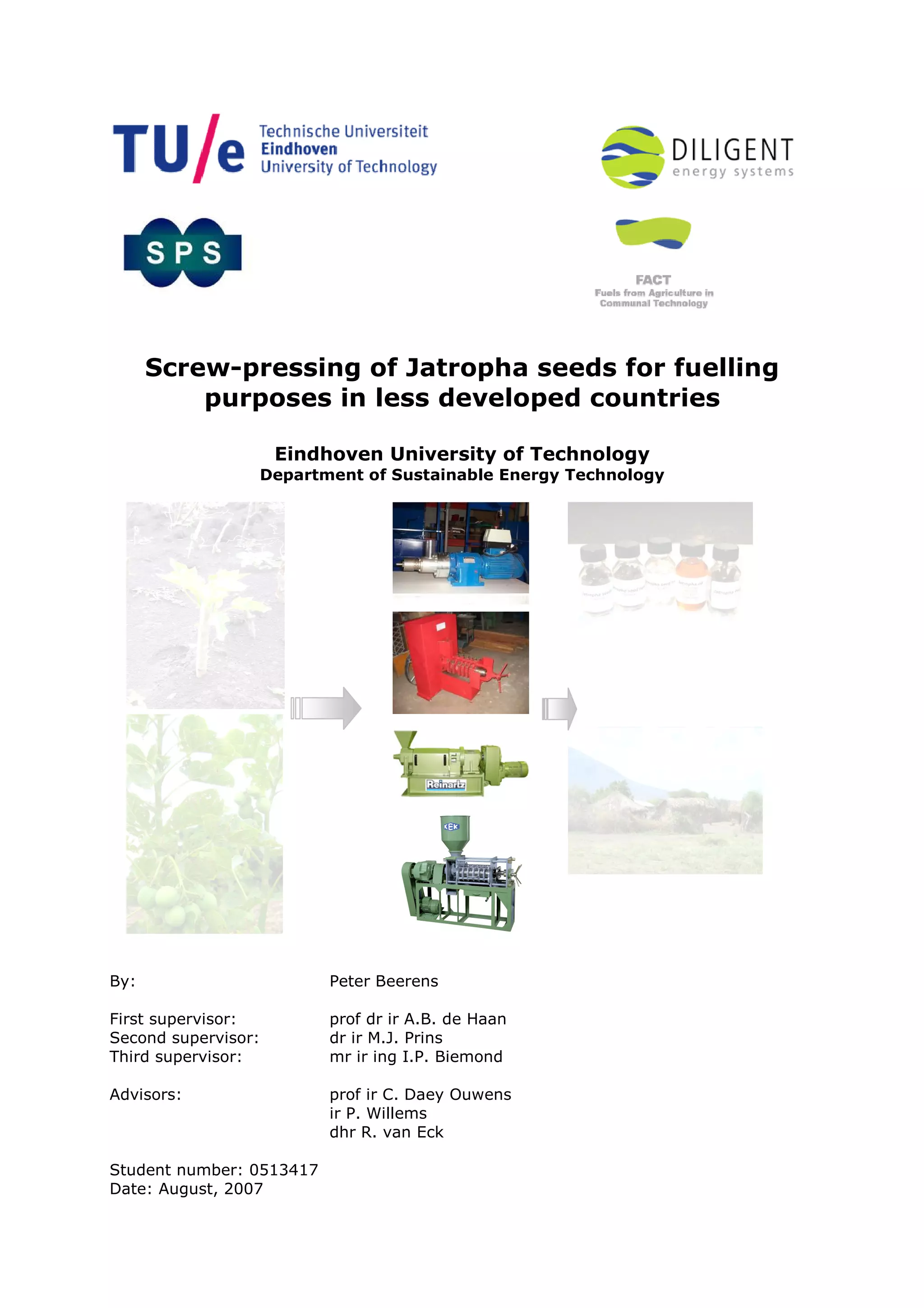
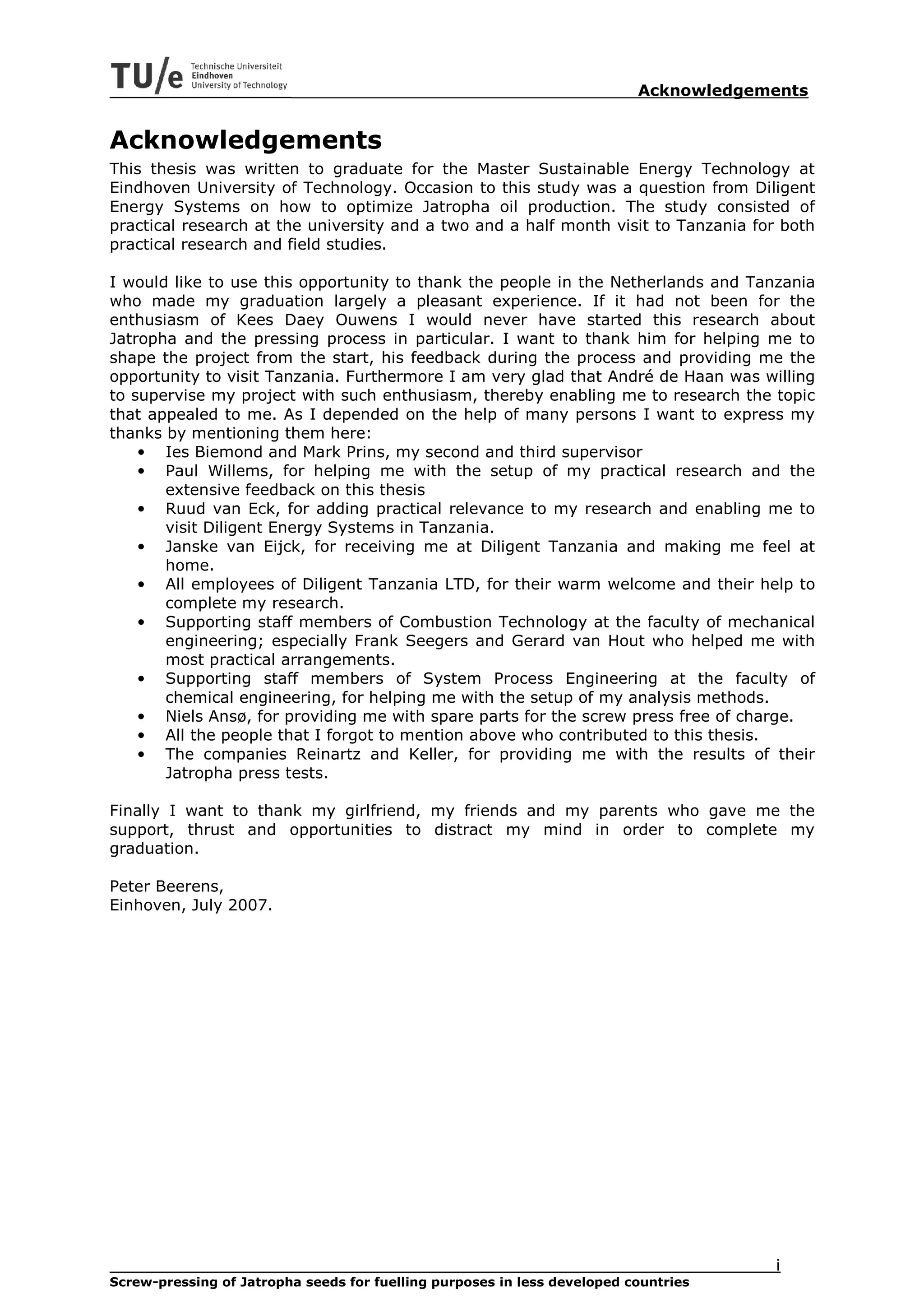

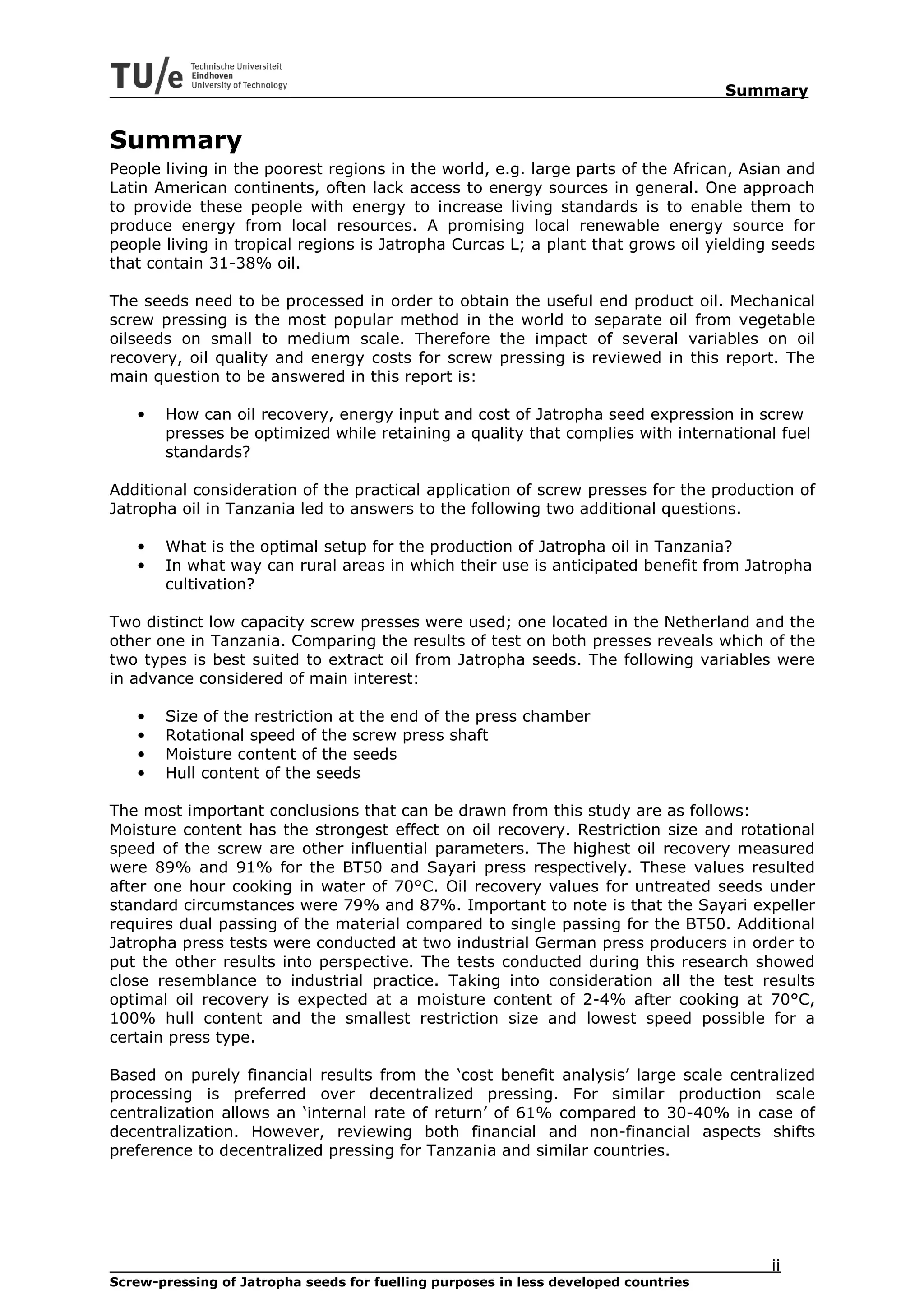

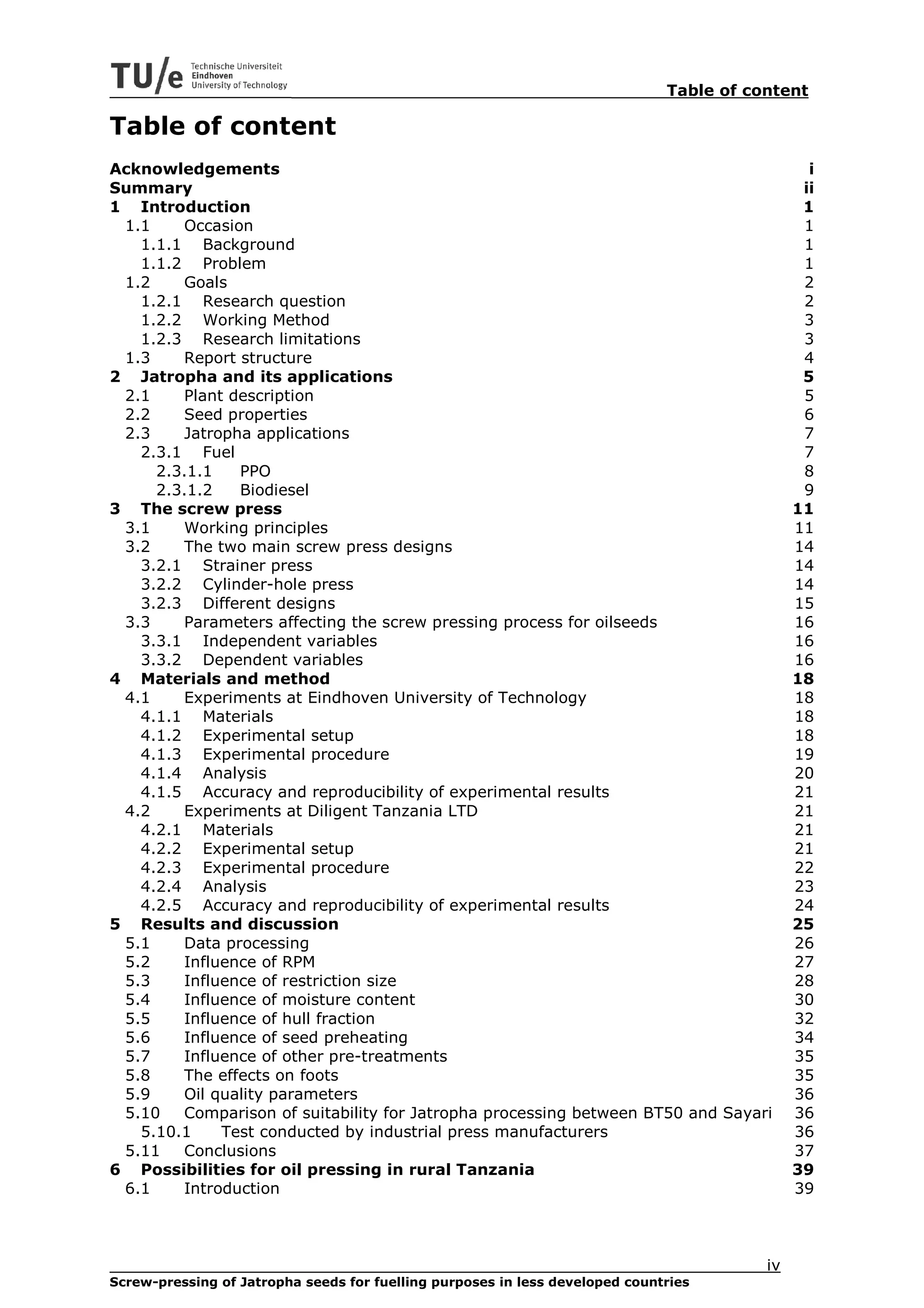
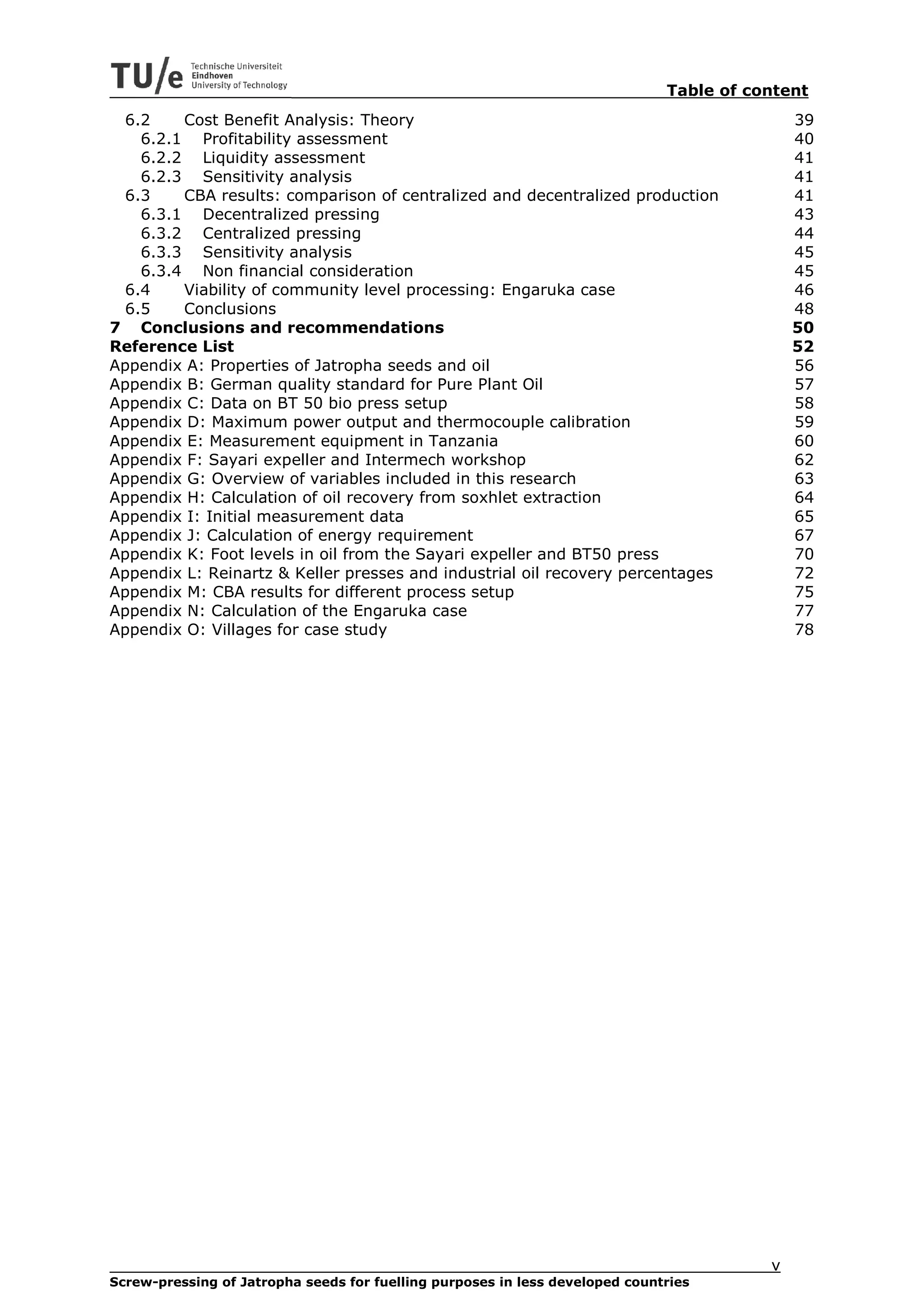
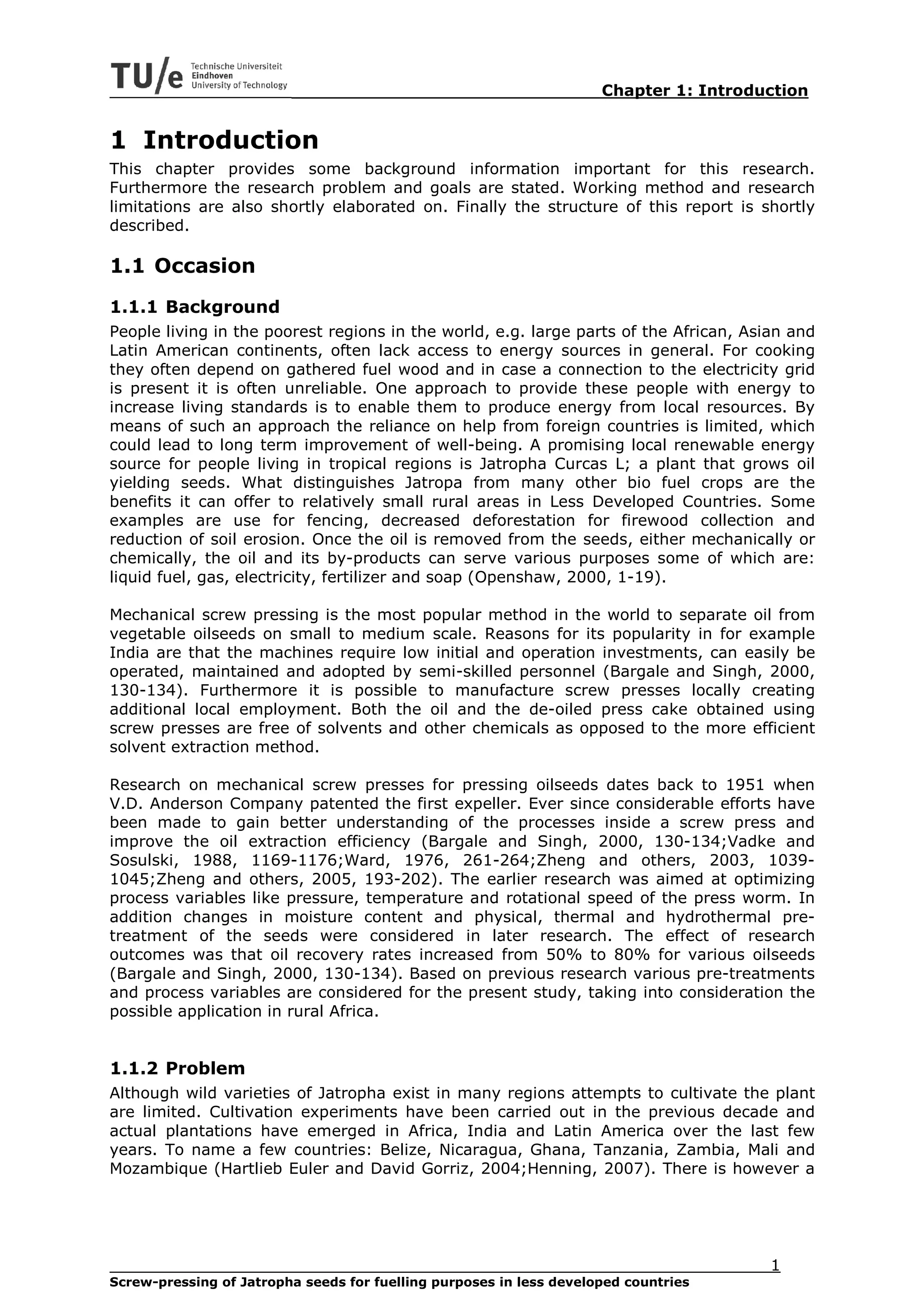
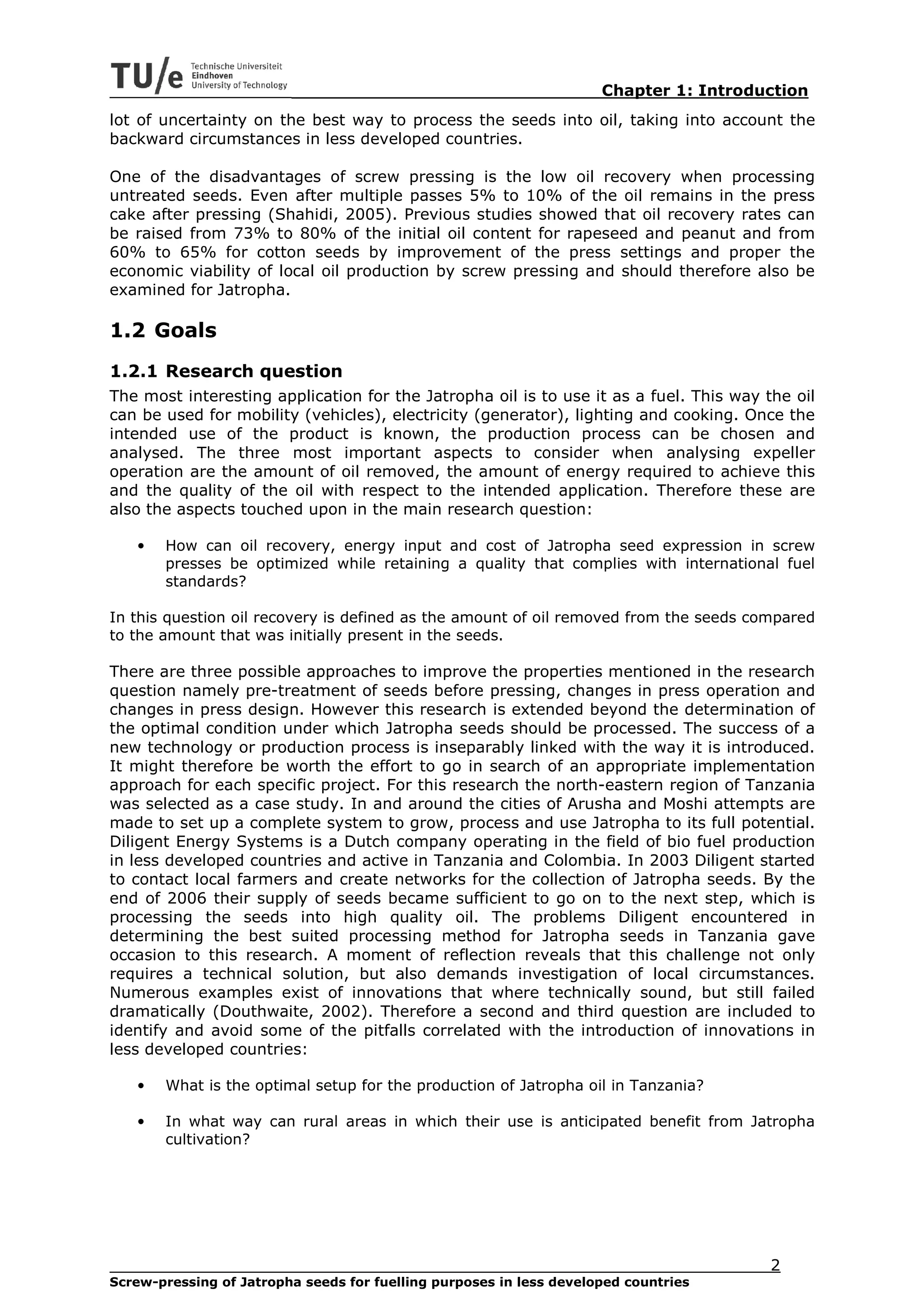
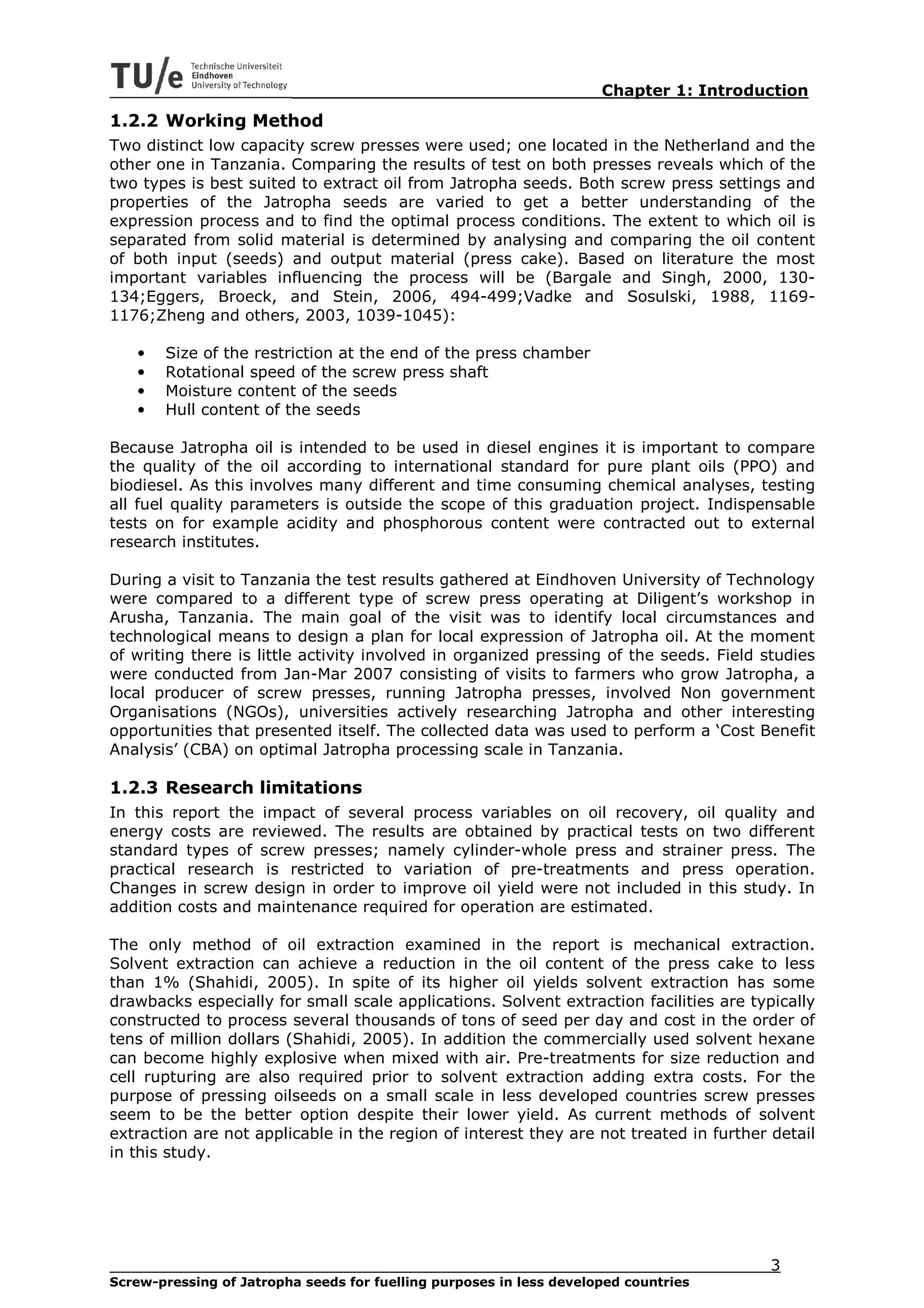
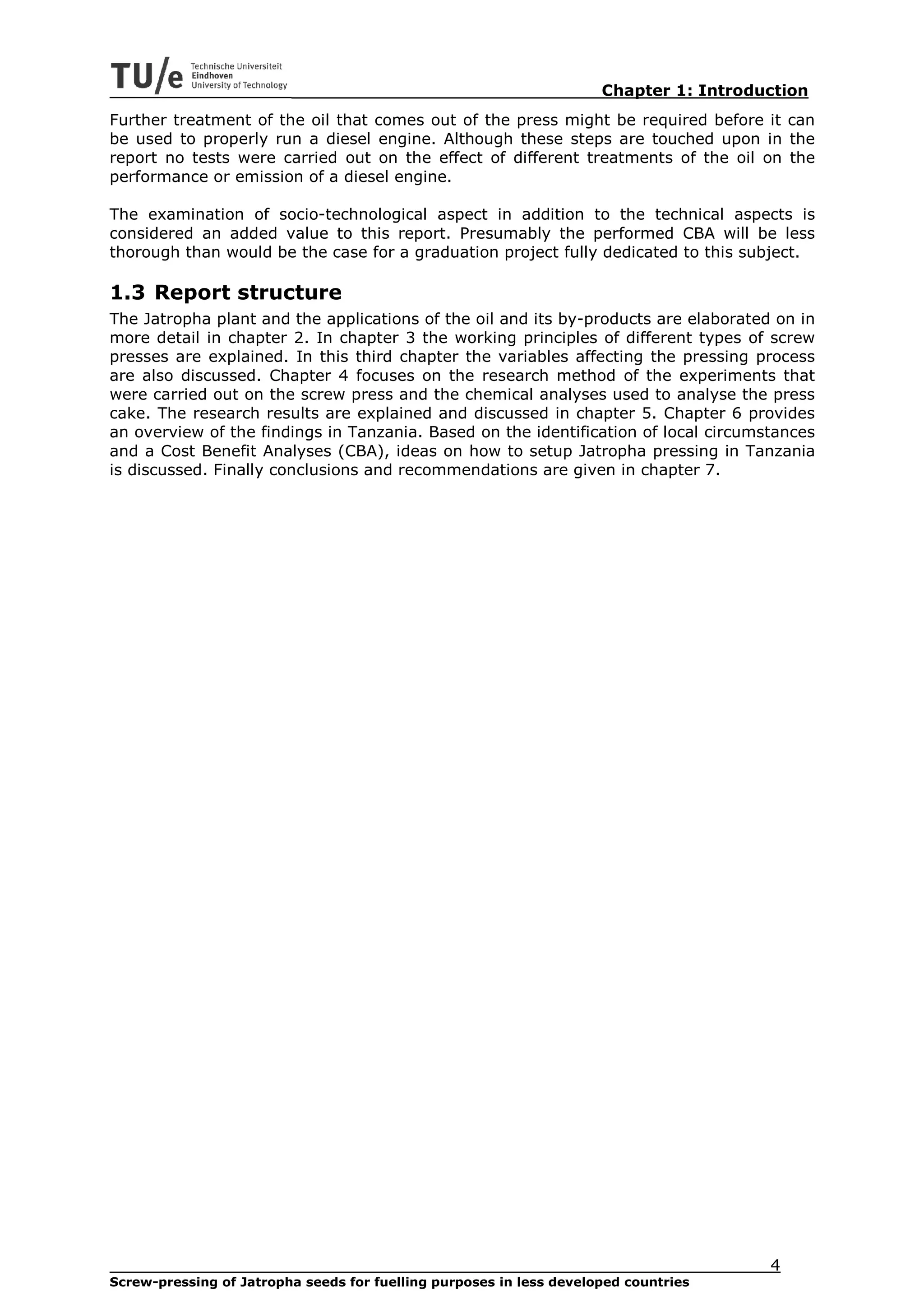
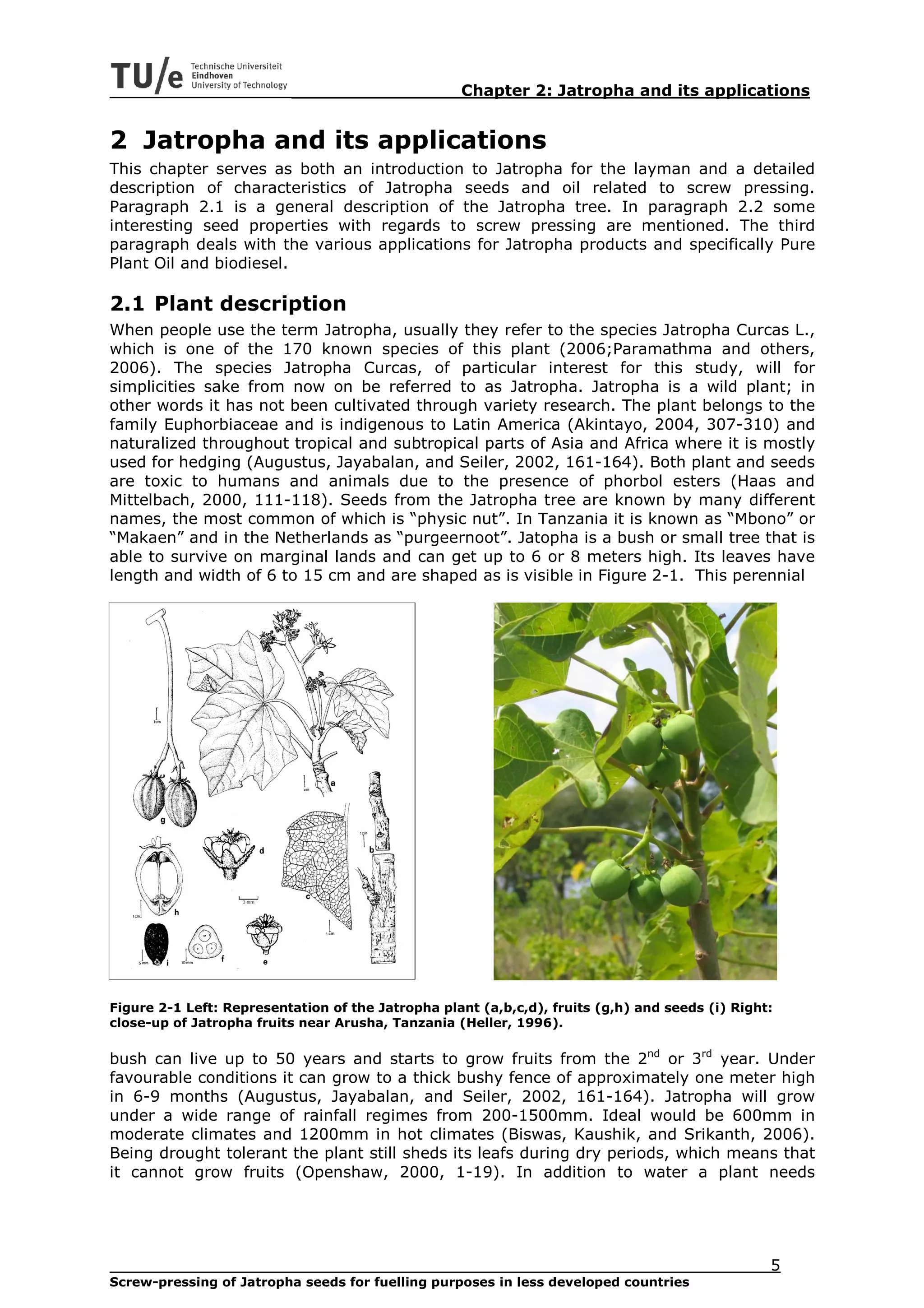
![Chapter 2: Jatropha and its applications
nutrients. In case of Jatropha deficiency of these nutrients leads to increased failure of
seed development as was encountered during my field studies in Tanzania in February
2007. The plants yield varies strongly and although it survives on marginal land, yields
will be significantly lower than for fertile lands. Claims on yields range from 0.4 to 12
ton/hectare/year (Openshaw, 2000, 1-19). The number of trees per hectare has been
reported to vary from 1100-3300, which equals 445-1335 per acre (Openshaw, 2000, 1-
19). The seed yield of Jatropha has been estimated to range from 0.75-2 kg/year per
plant after three to four years (Biswas, Kaushik, and Srikanth, 2006). In contrast to the
overoptimistic claims of 12 tons/hectare (4.8 tons/acre) calculation using the above
values predict yield between 0.8-6.6 tons/hectare (0.33-2.7 tons/acre). This seems a
reasonable when compared to claims in the comparative studies by Benge (Benge,
2006).
2.2 Seed properties
Much research has been conducted on the composition and properties of Jatropha seeds
by others ((Openshaw, 2000, 1-19), (Heller, 1996), (Henning, 2004) and (Sirisomboom,
7 A.D.)). These studies also provide insight in the possibilities of using Jatropha oil for
fuel purposes. Knowledge of the physical and mechanical properties of Jatropha is
required for adequate design of machines for de-hulling, drying and pressing of the
seeds. Restrictions on how to store the seeds are linked to these properties. Mechanical
properties such as rupture force and energy required for rupturing fruit, nut and kernel
provide insights on how to adapt the pressing process to Jatropha seeds.
Table 2-1 Physical and mechanical properties of Jatropha (Sirisomboom, 7 A.D.). Note that the data
concerns fresh seeds and that under normal conditions the density is less than that of water.
Physical properties Nut Kernel
Length [mm] 21.02 ± 1.03 15.45 ± 0.54
Equatorial width perpendicular to length [mm] 9.58 ± 0.28 7.42 ± 0.33
Breadth perpendicular to length and width [mm] 11.97 ± 0.30 10.25 ± 0.36
Solid density [kg/m3] 1040 1020
Bulk density [kg/m3] 450 420
Mechanical properties Nut Kernel
Rupture force [N] 146.63 ± 14.82 67.72 ± 19.03
Hardness [N/mm] 69.98 ± 6.22 38.52 ± 5.59
Energy used for rupture [Nmm] 124.44 ± 19.95 51.61 ± 26.84
Jatropha fruits are slightly elliptical in shape with length approximately 35 mm and
contain 3 seeds on average (Sirisomboom, 7 A.D.). The fruits and seeds are shown in
Figure 2-1. The size of the seeds varies between 11-30 mm (average 21mm) in length
and 7-12 mm (average 11mm) in width (2006;Sirisomboom, 7 A.D.). More detailed
information on the physical and mechanical properties of Jatropha seeds is given in Table
2-1. Hardness values in Table 2-1 indicate that Jatropha seeds are relatively soft
compared to for example rapeseed (>52.6 N/mm) (Faborode and Favier, 1996, 335-345)
and sunflower (35.3-65.3 depending on seed orientation) (Gupta and Das, 2000, 1-8).
The seeds weigh about 1 ton/m3. The oil content of the seeds varies with origin and
growing conditions and is between 30-40 wt.%, which makes it a high oil content seed.
Variations of oil content with origin are shown in Table 2-2. For Tanzanian varieties this is
approximately 38%. The influence of seed quality on oil content could not be checked as
the samples were provided by various parties.
6
Screw-pressing of Jatropha seeds for fuelling purposes in less developed countries](https://image.slidesharecdn.com/afstudeerverslagpeterbeerens26-08-07120jatropha20tanzania-120502110635-phpapp01/75/Screw-Pressing-of-Jatropha-Seeds-for-Fuelling-Purposes-in-Less-Developed-Countries-13-2048.jpg)
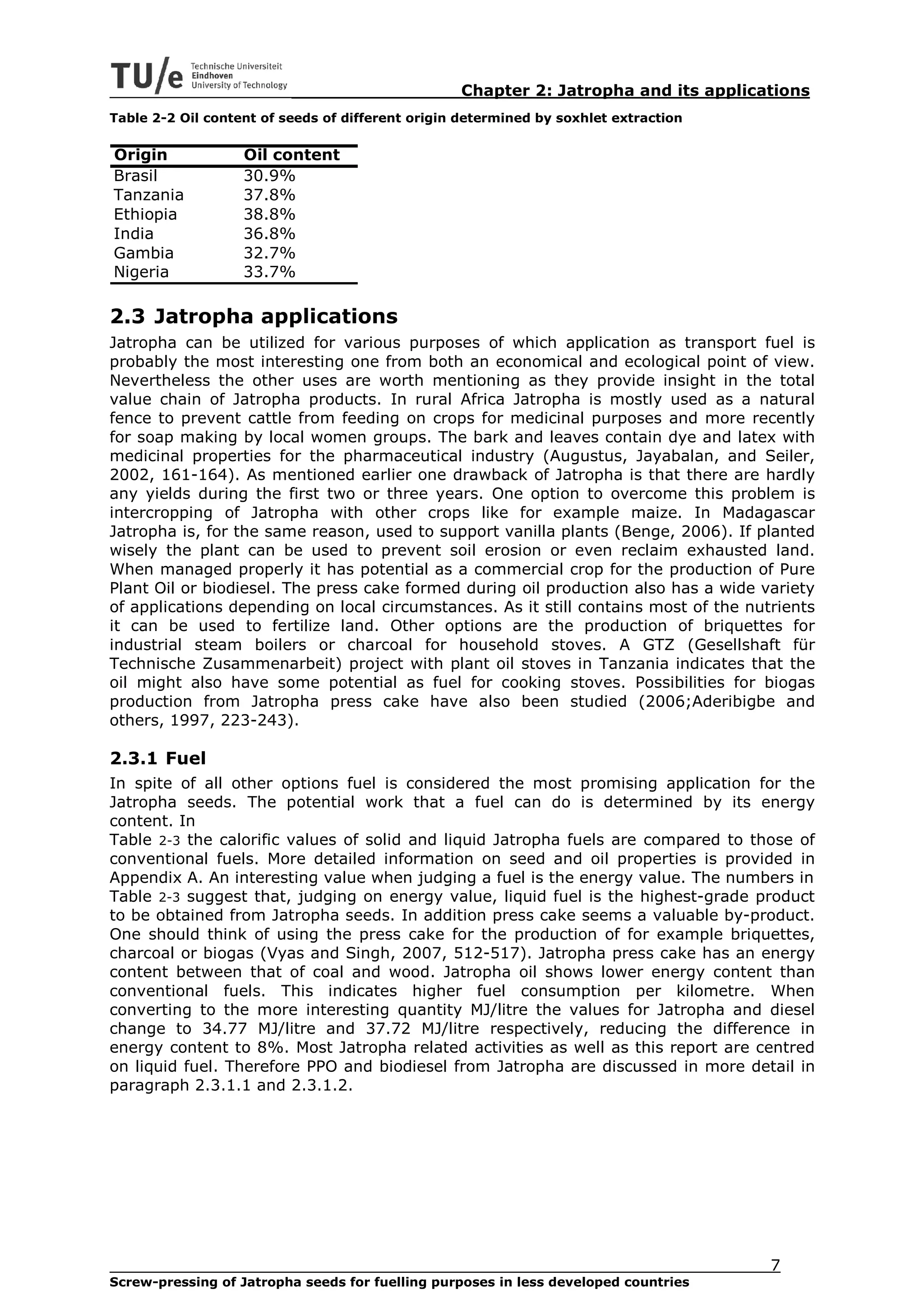
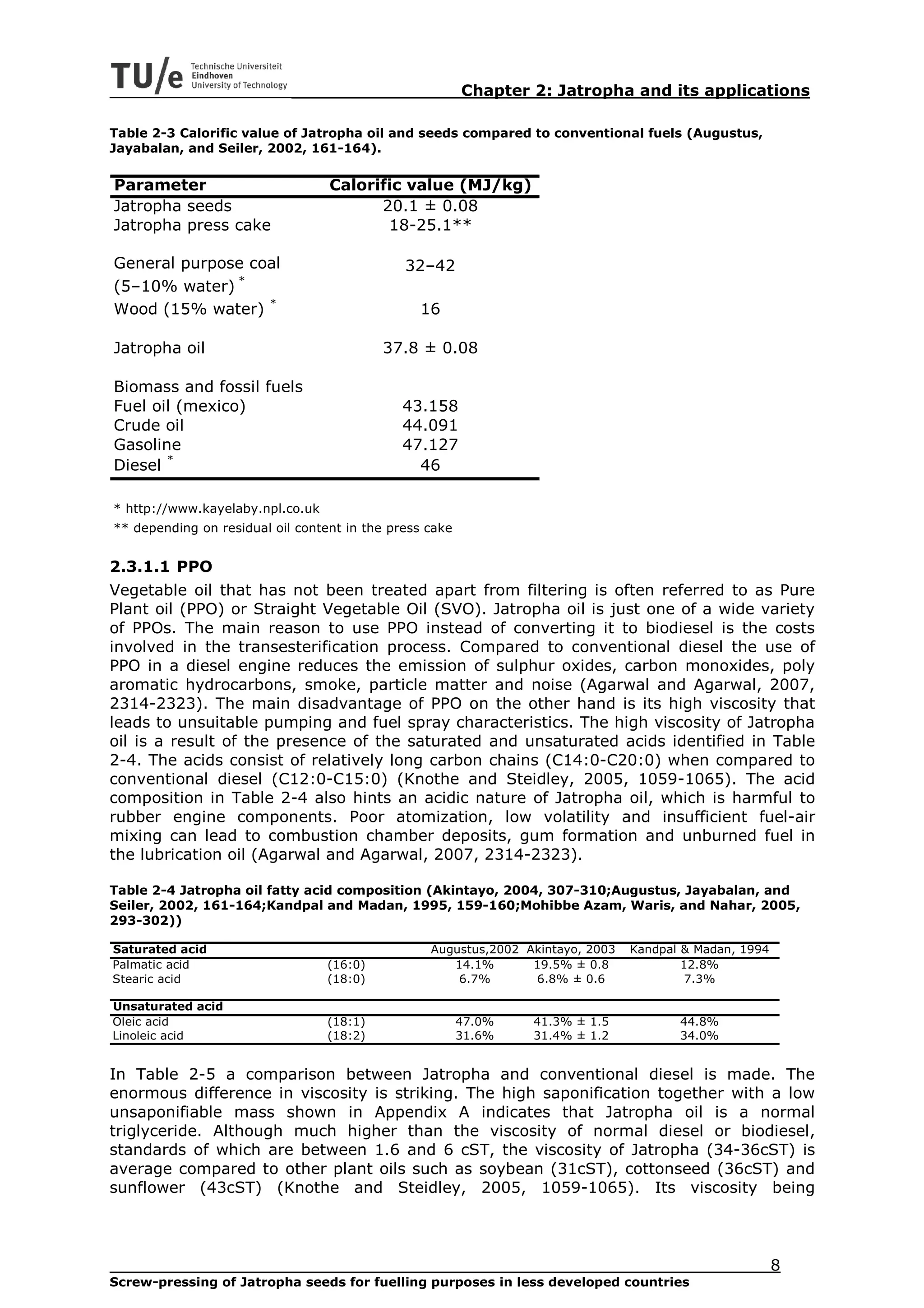
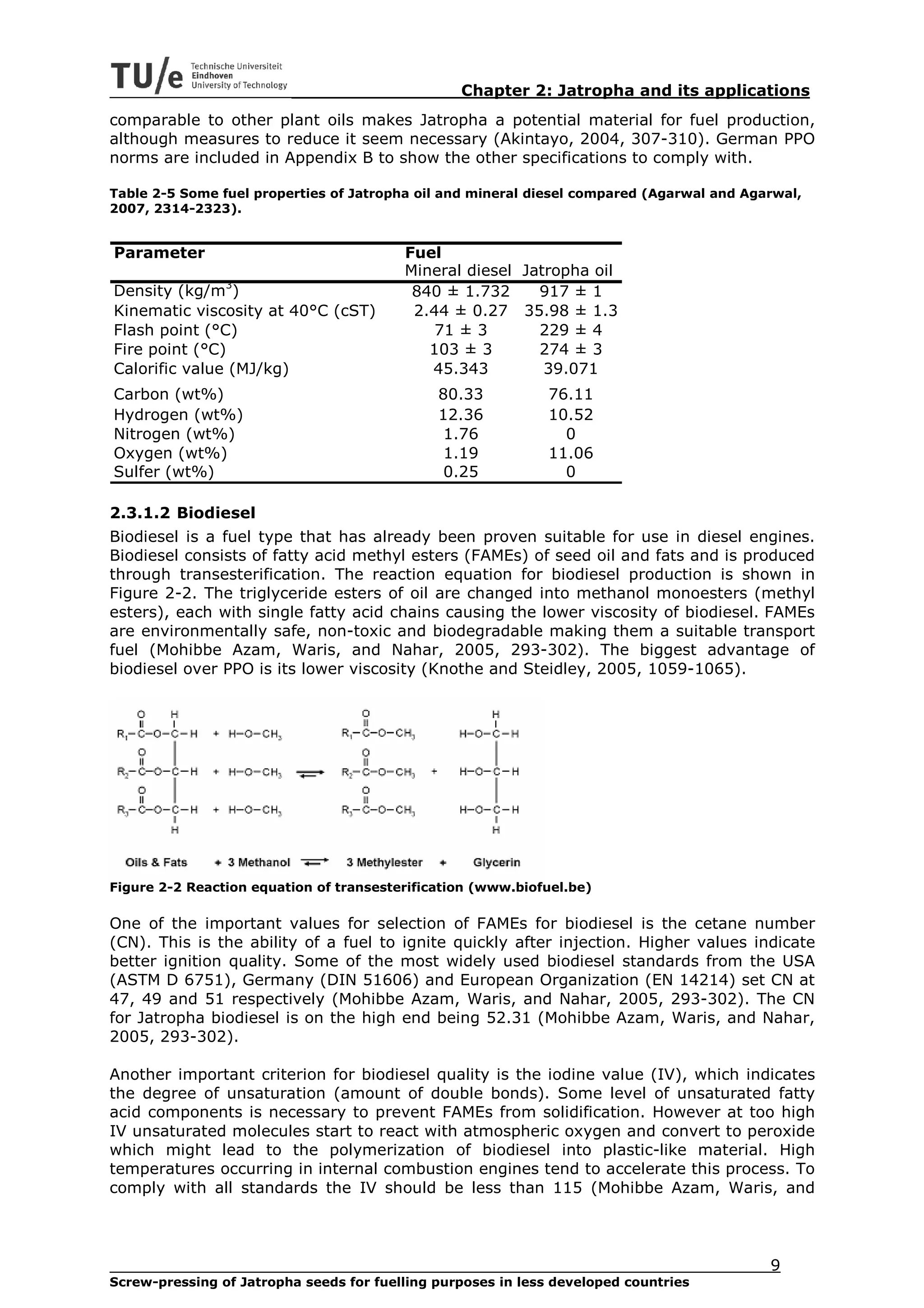
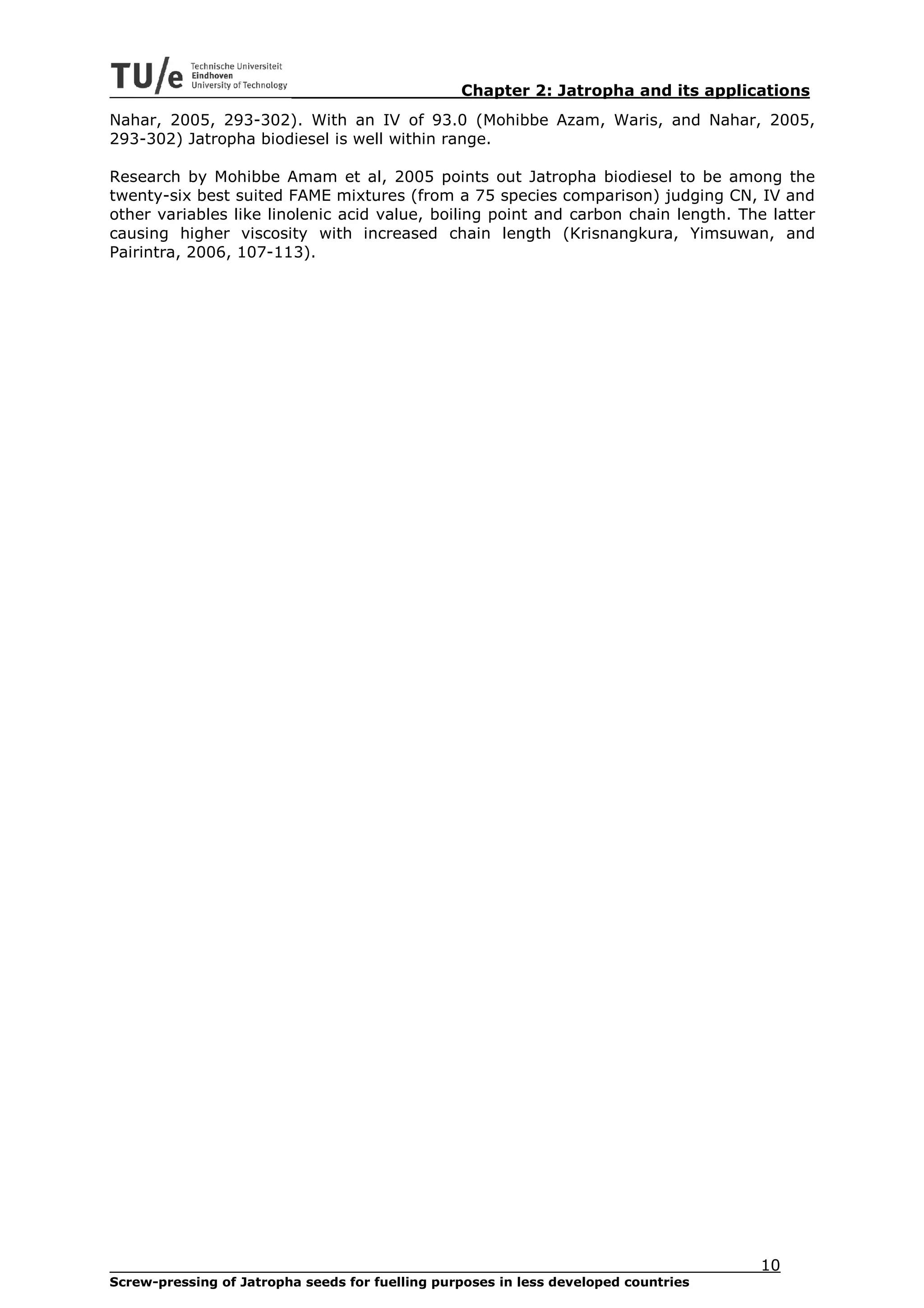
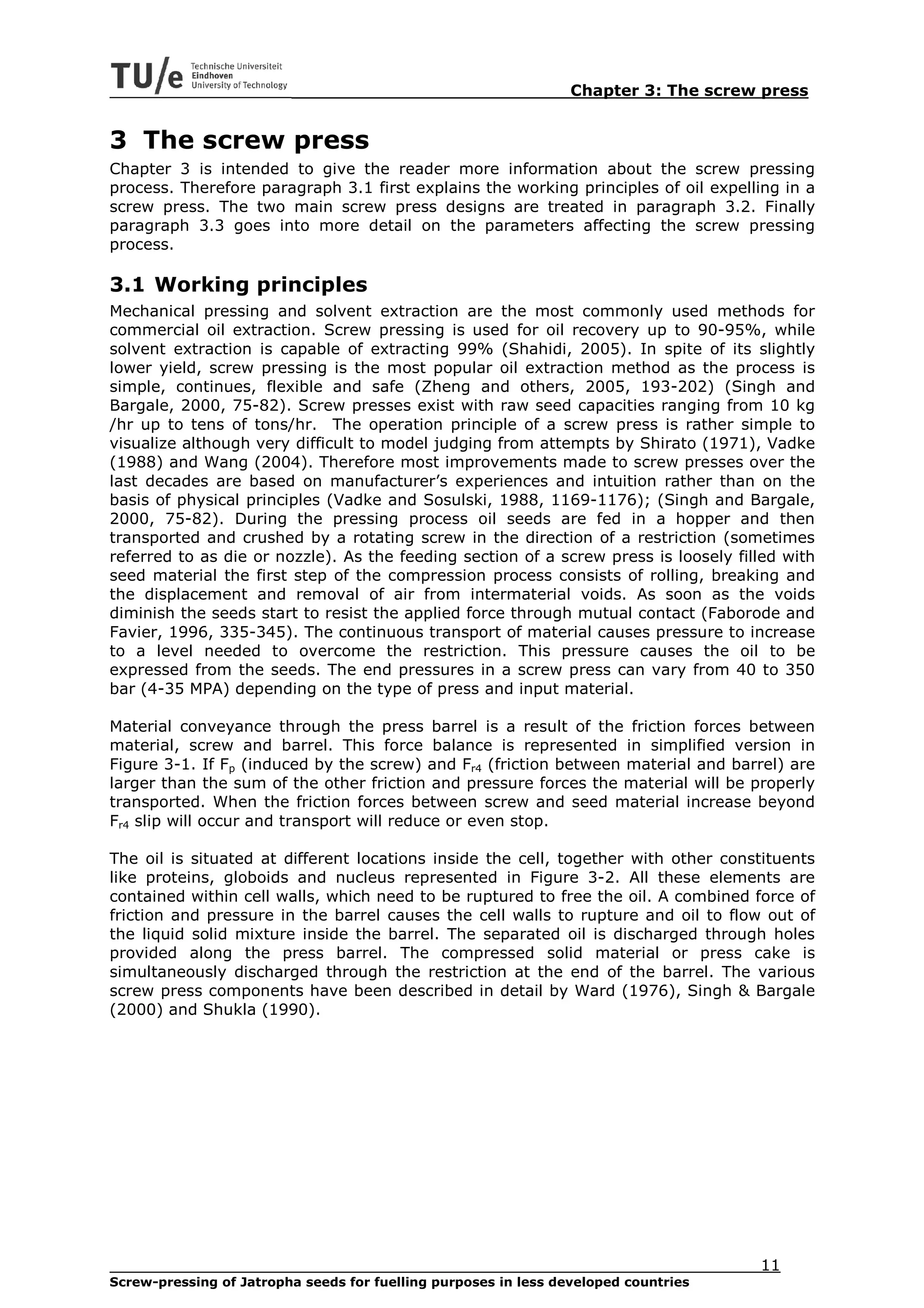
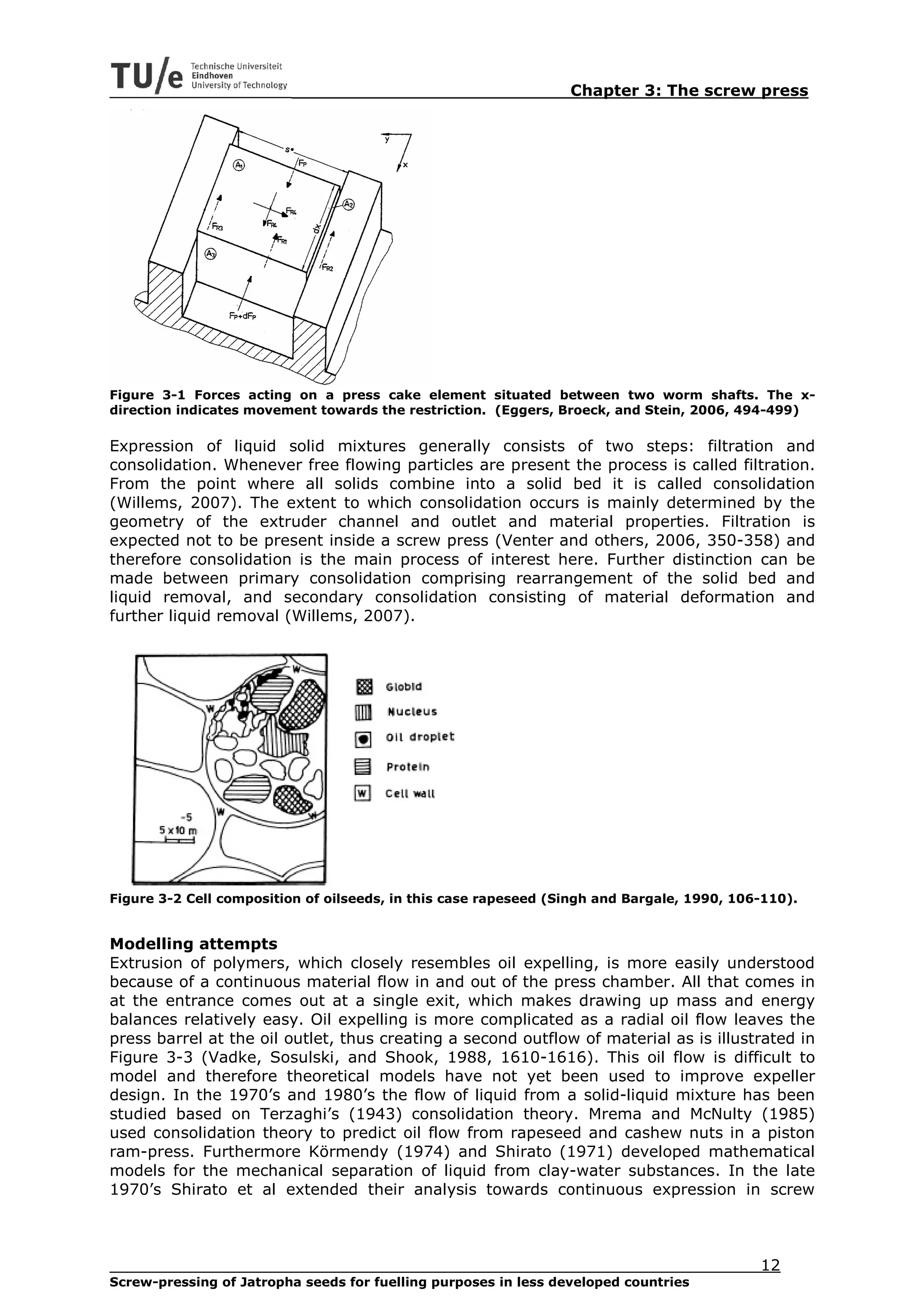

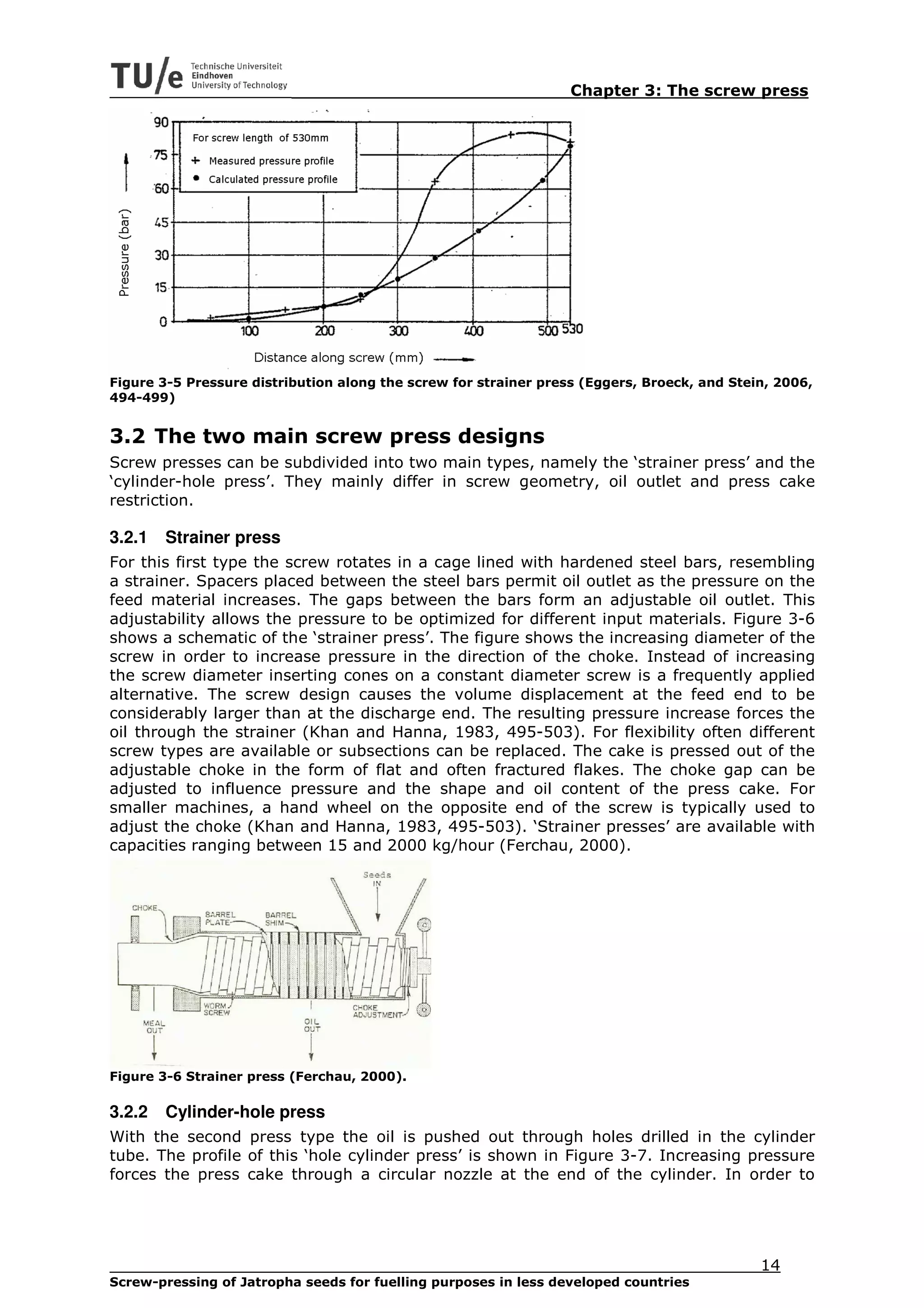
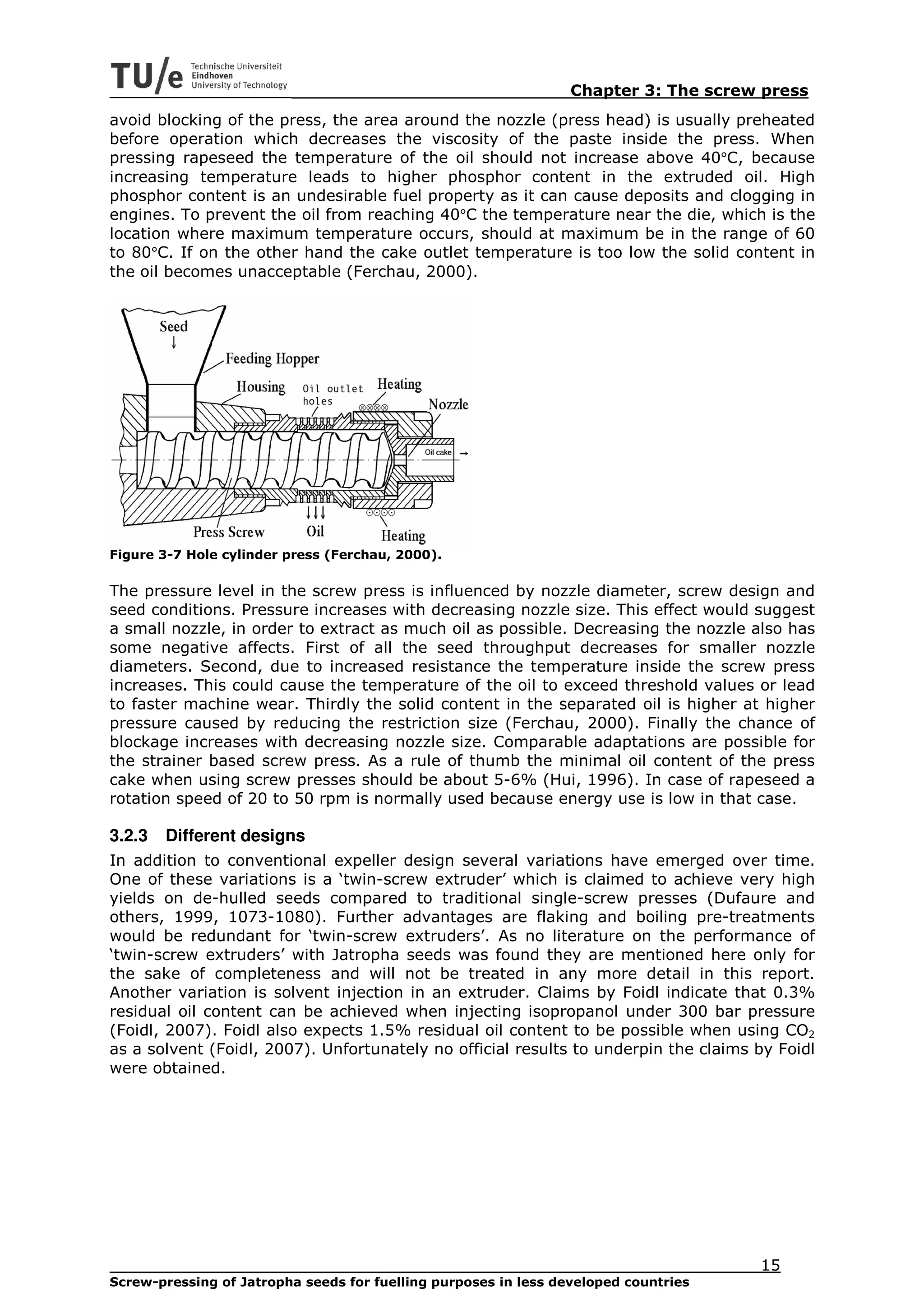
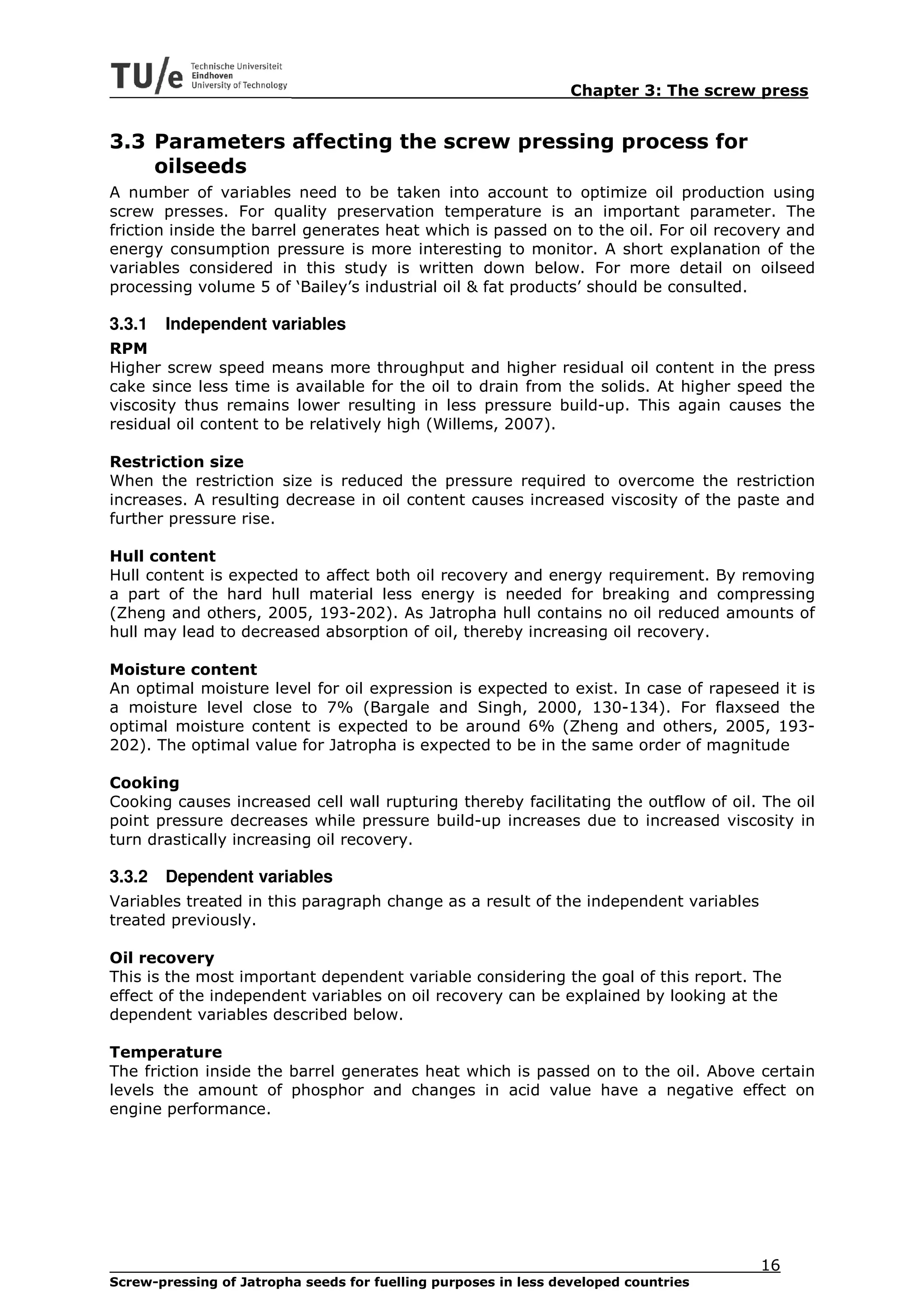
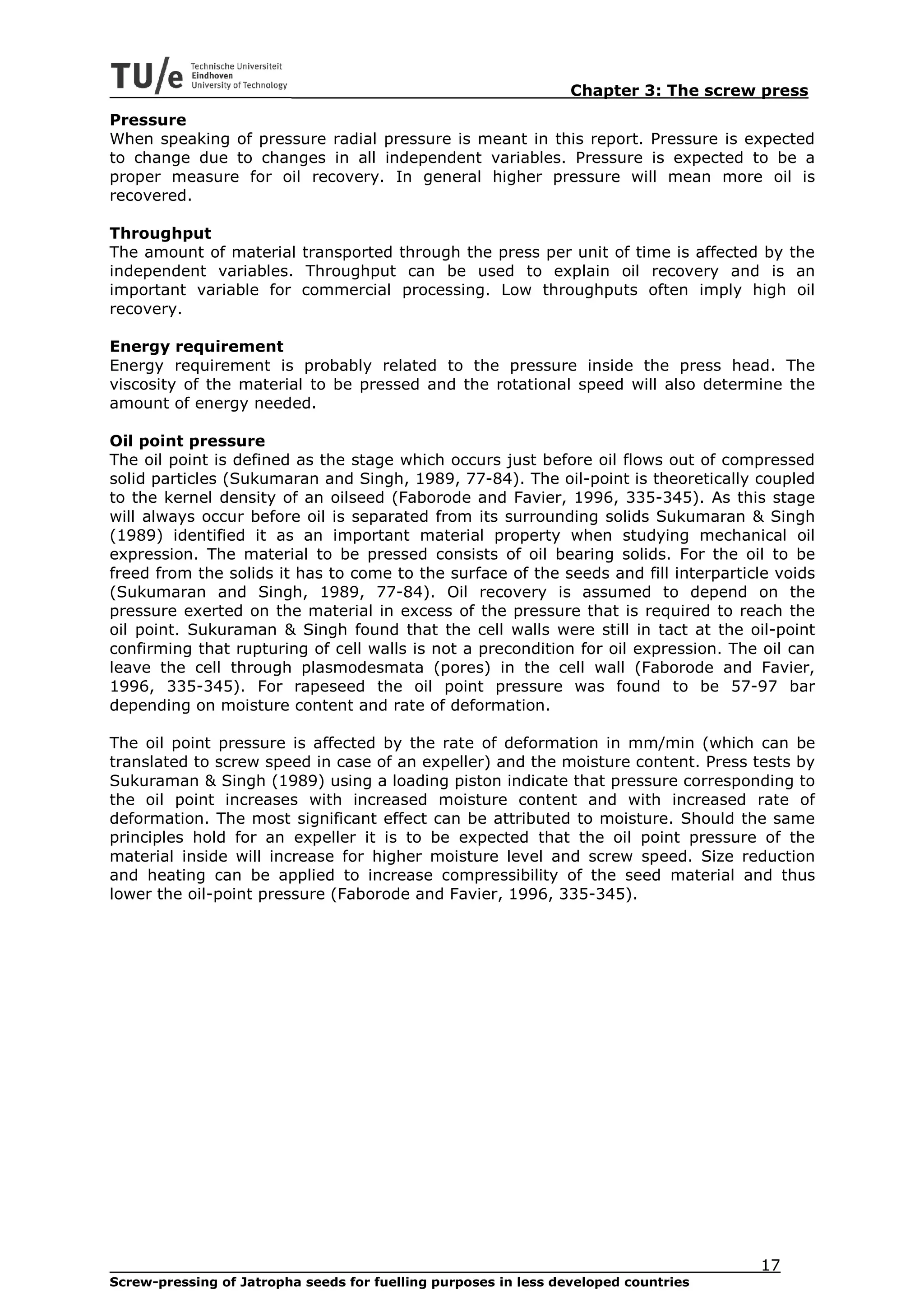
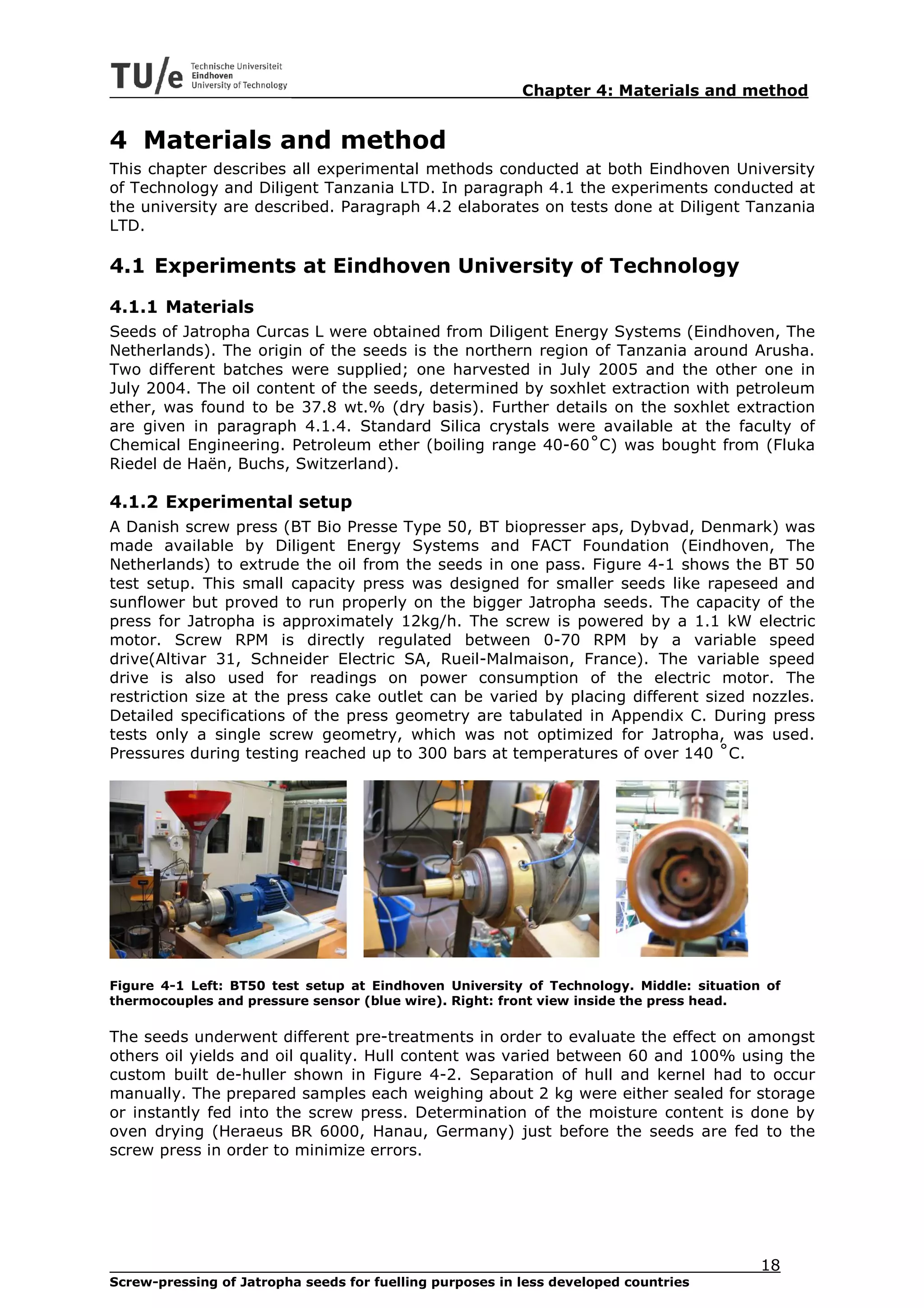
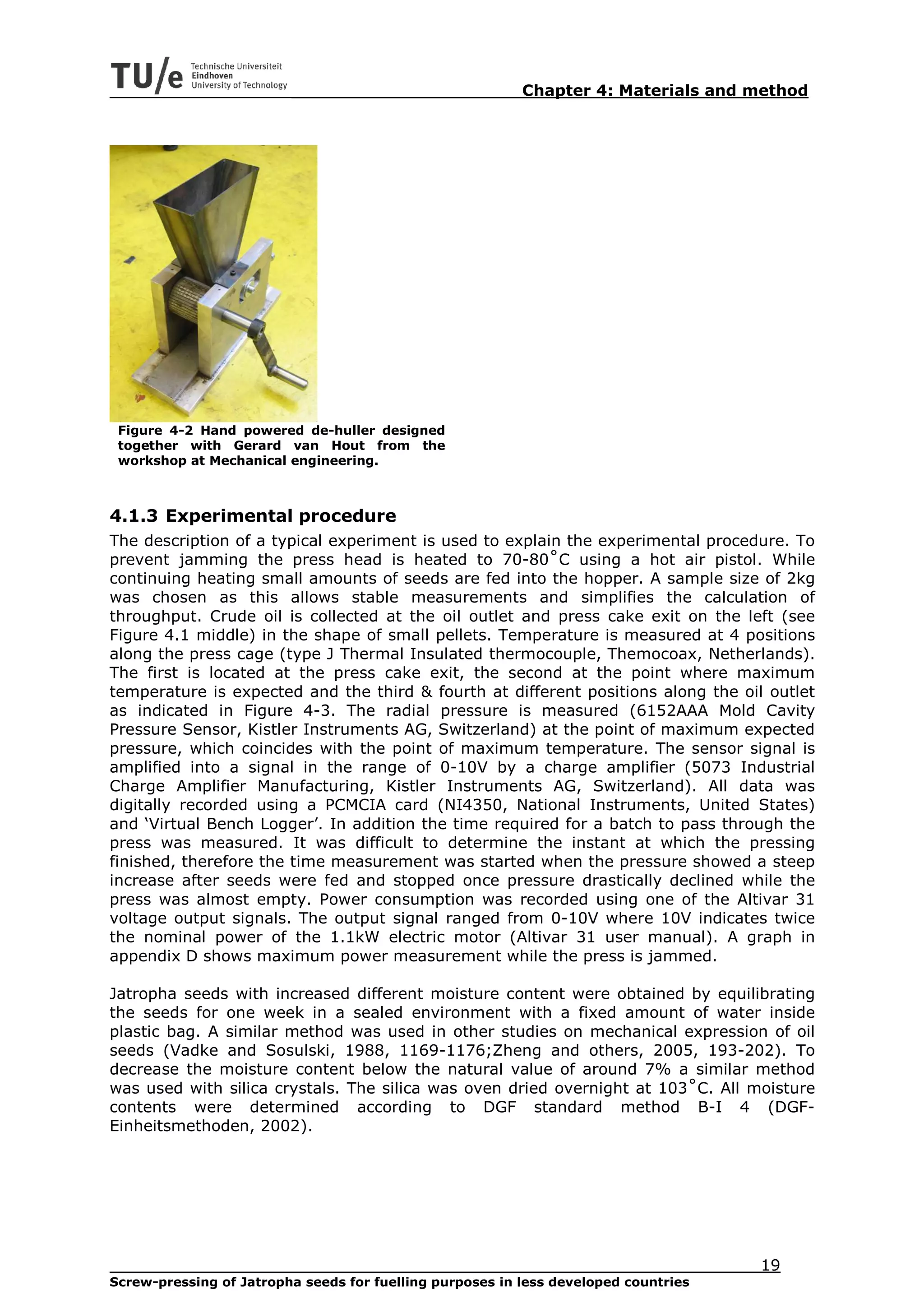

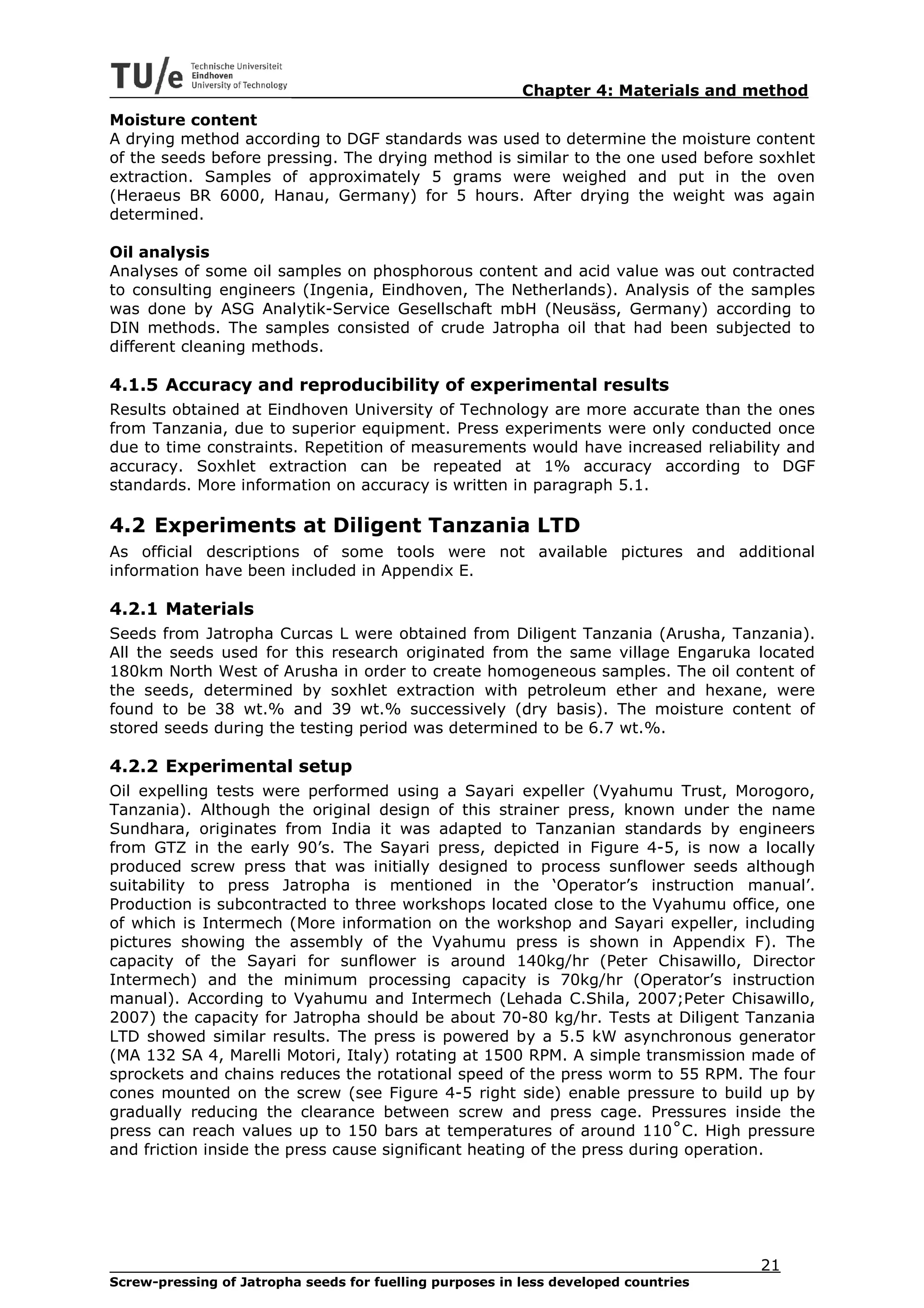
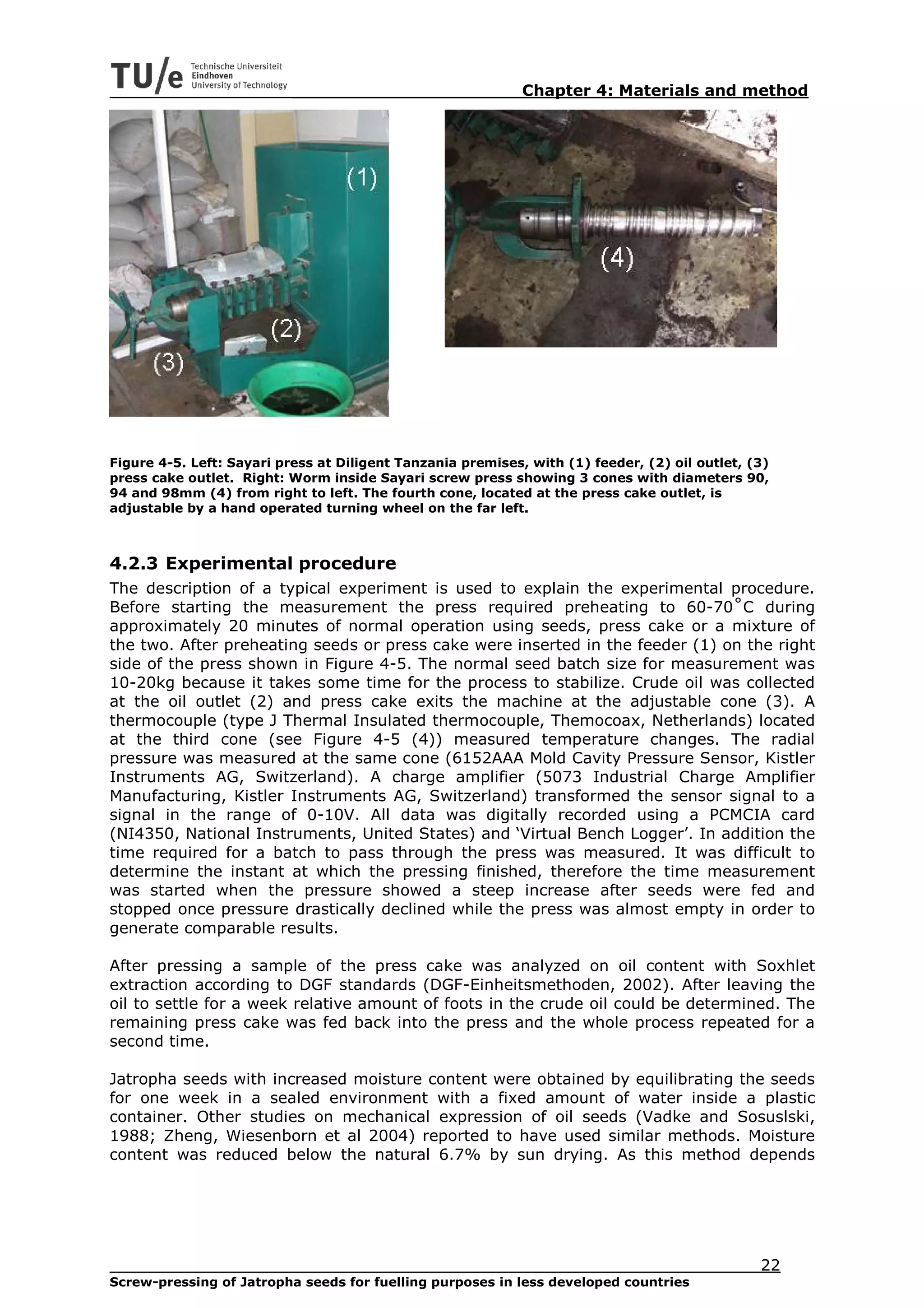
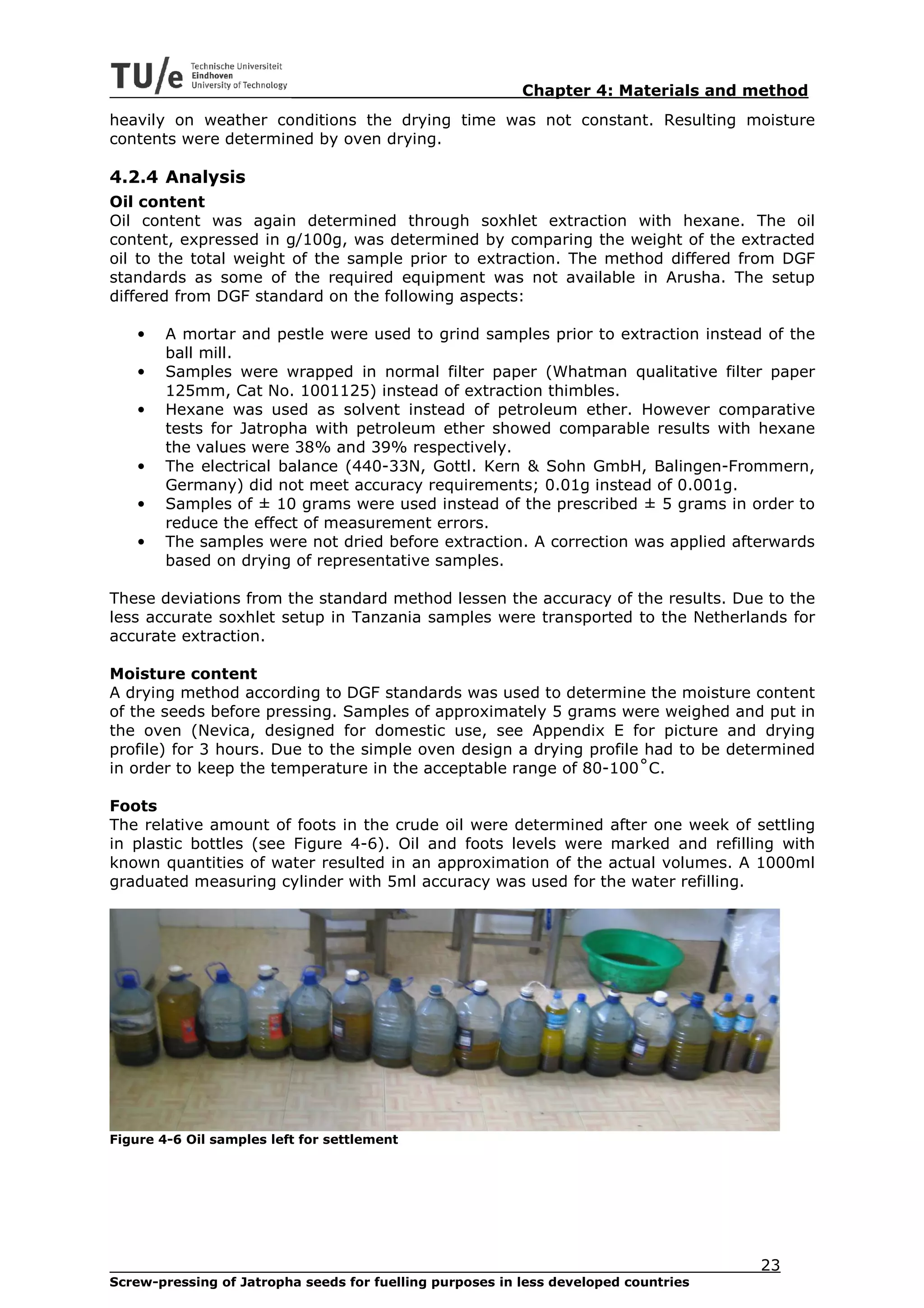
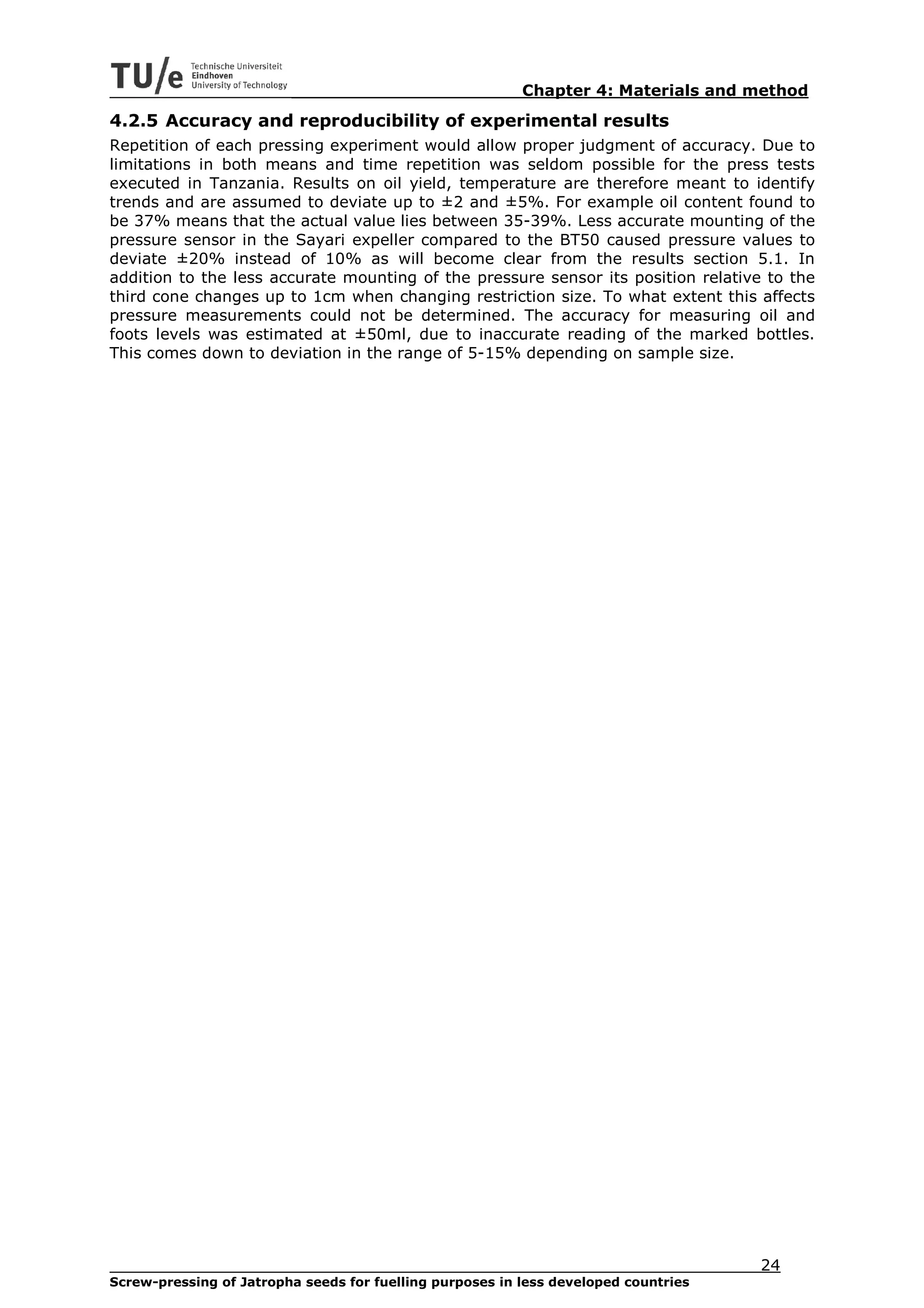
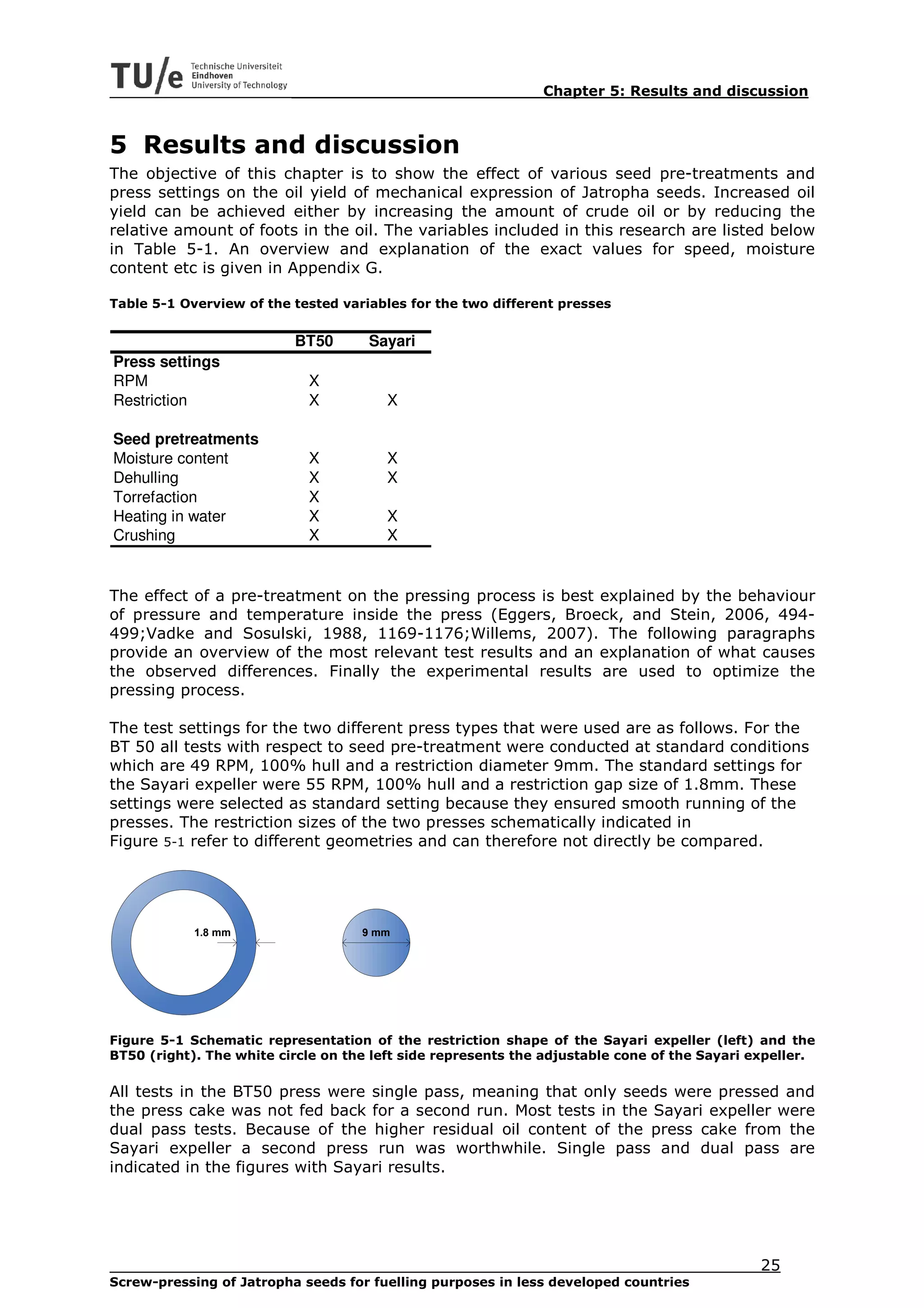
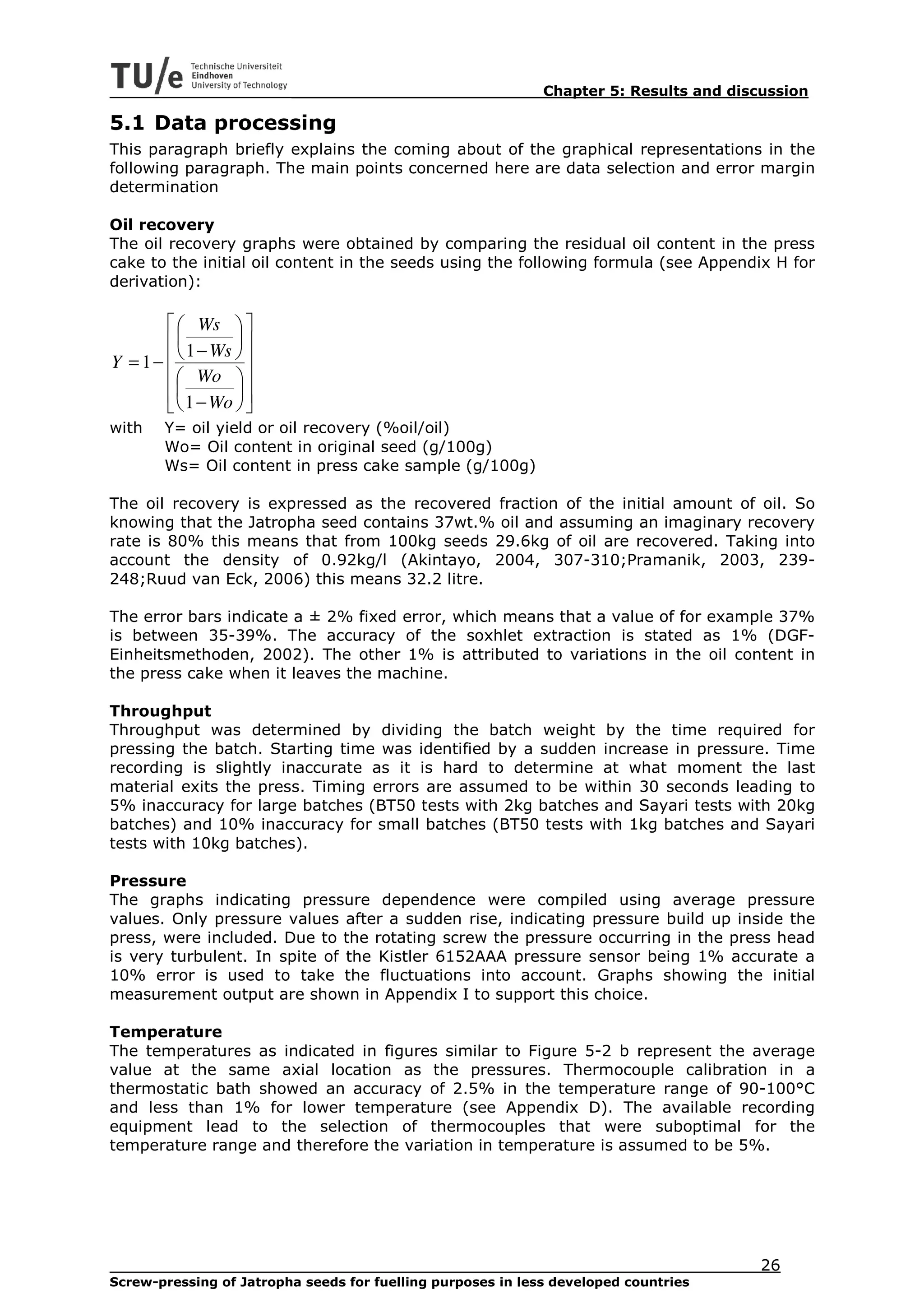

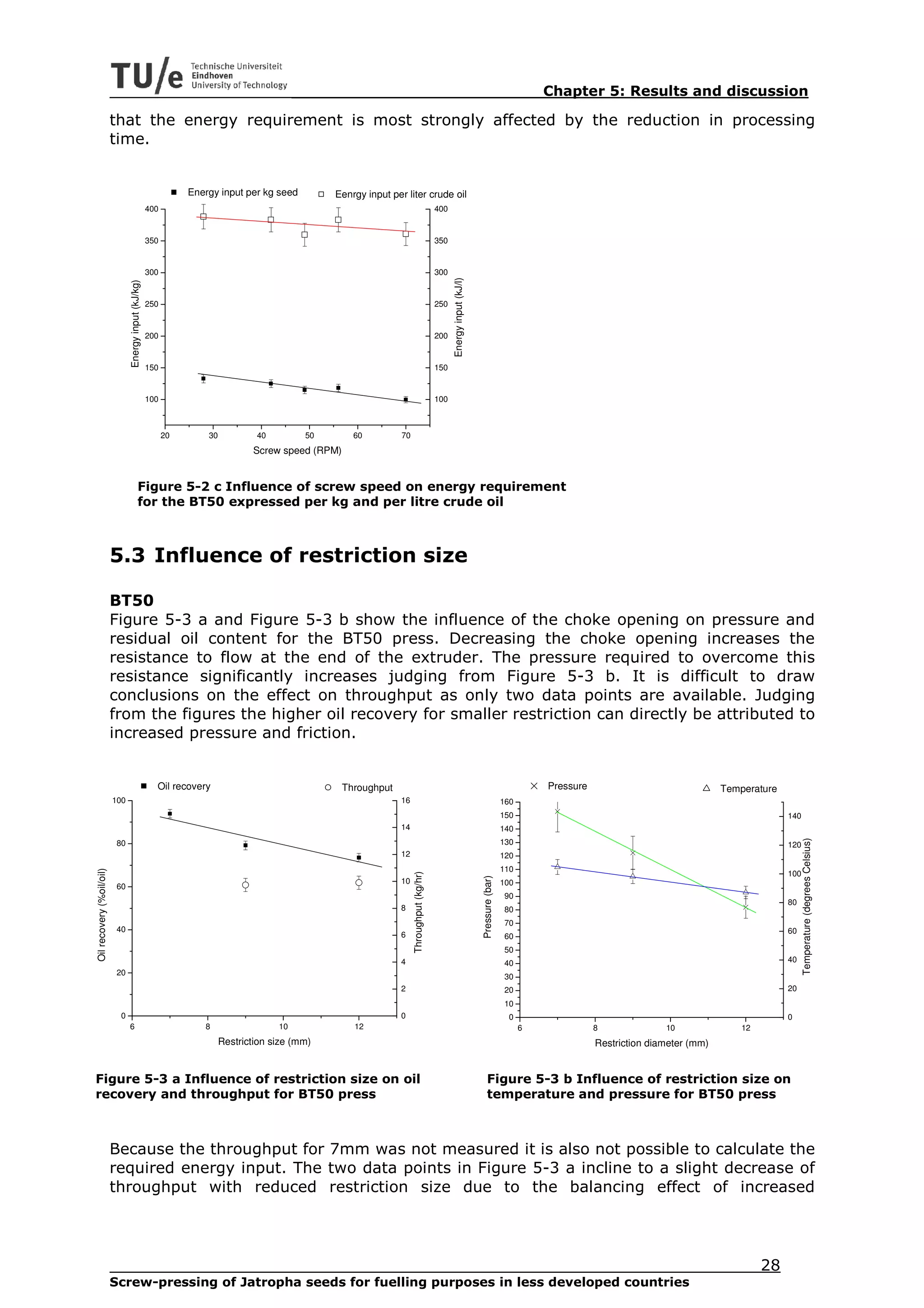
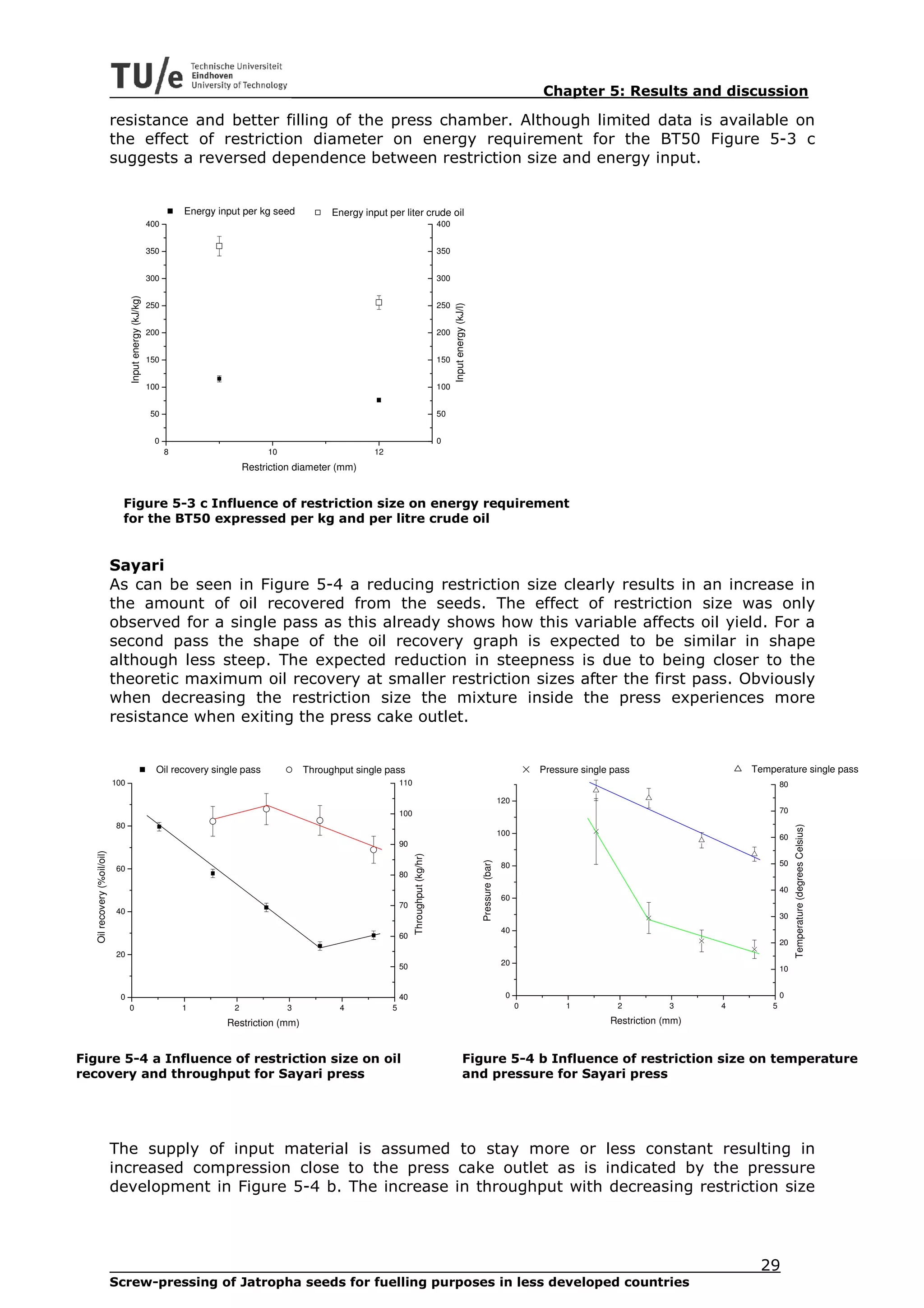
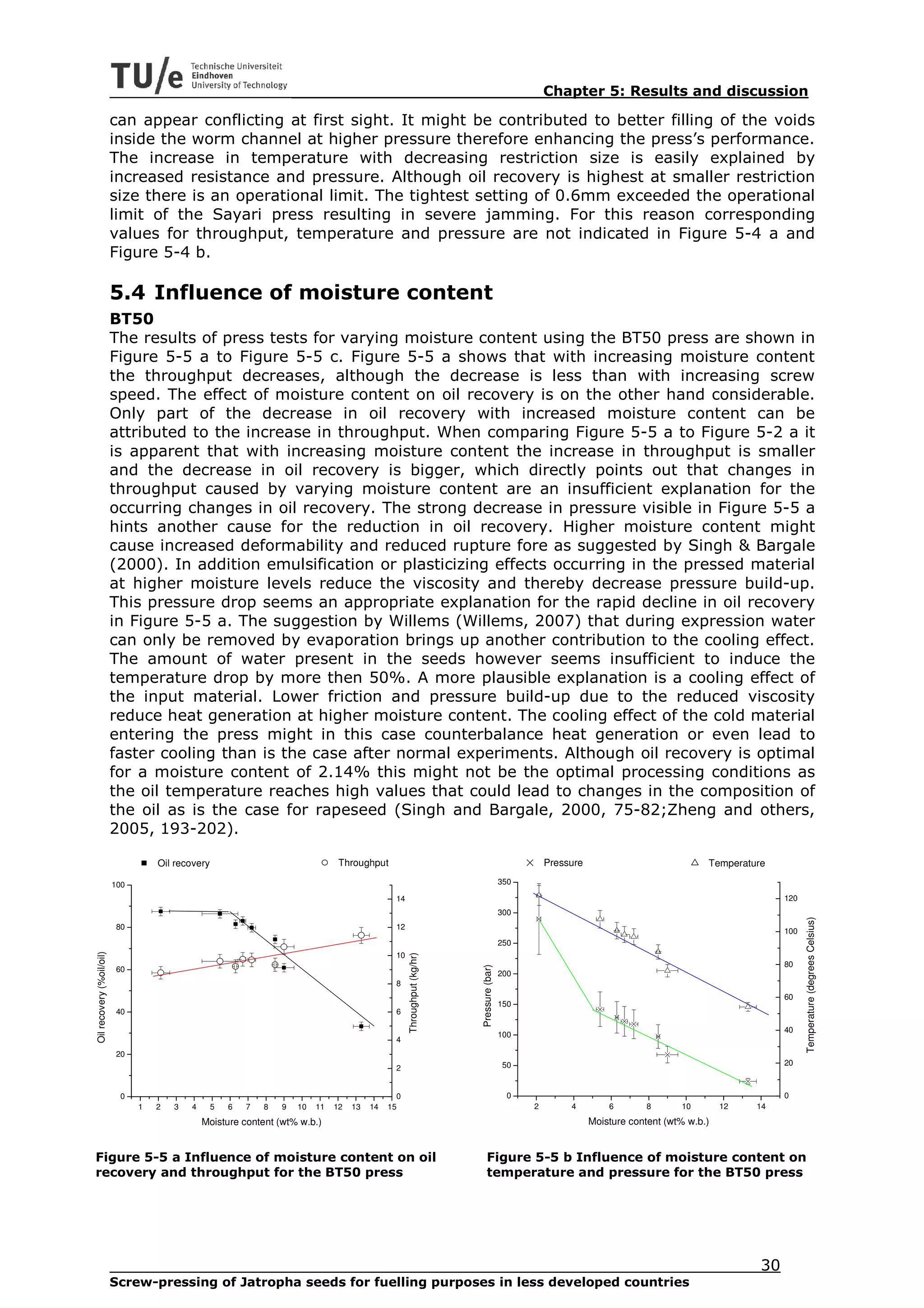
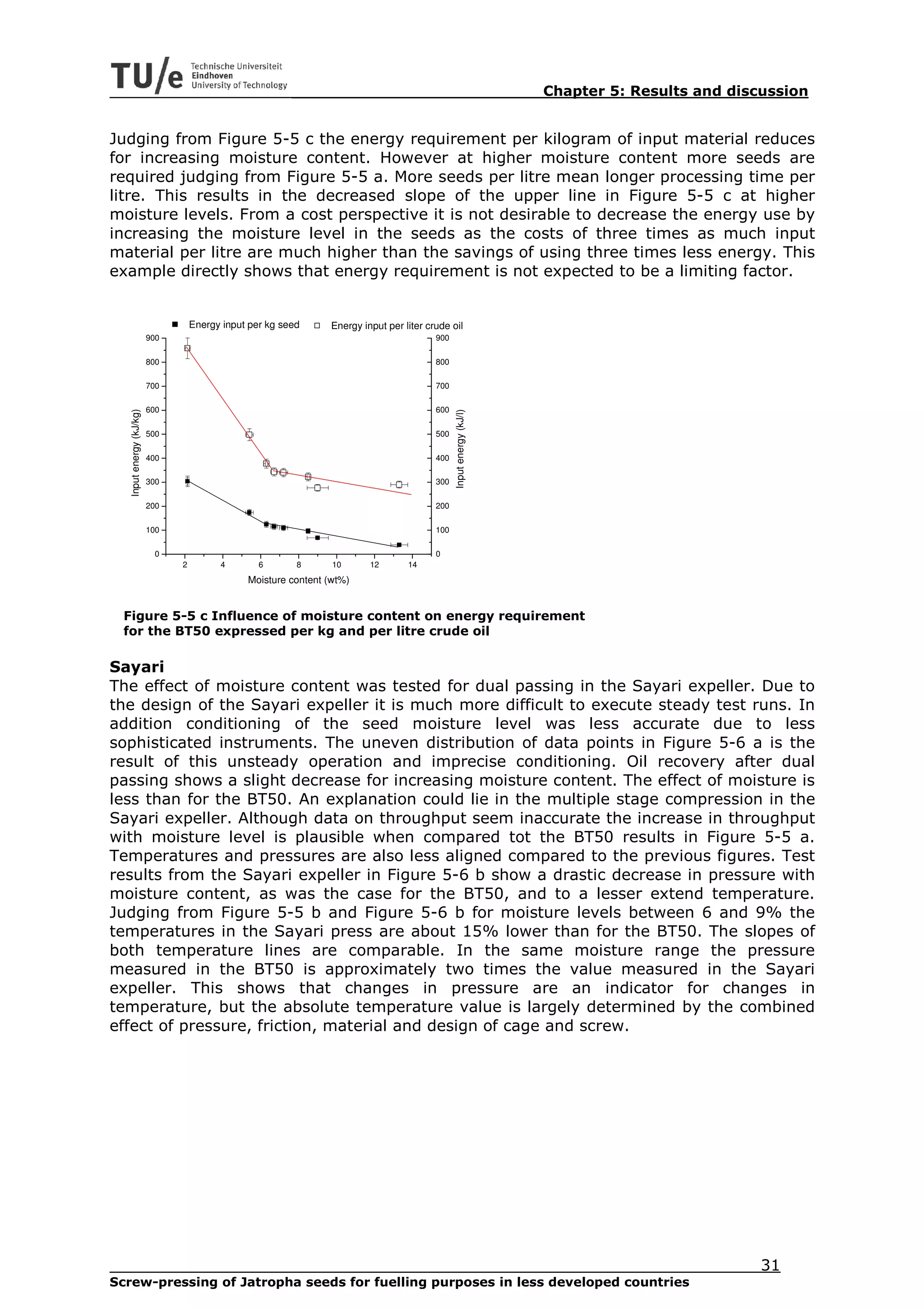
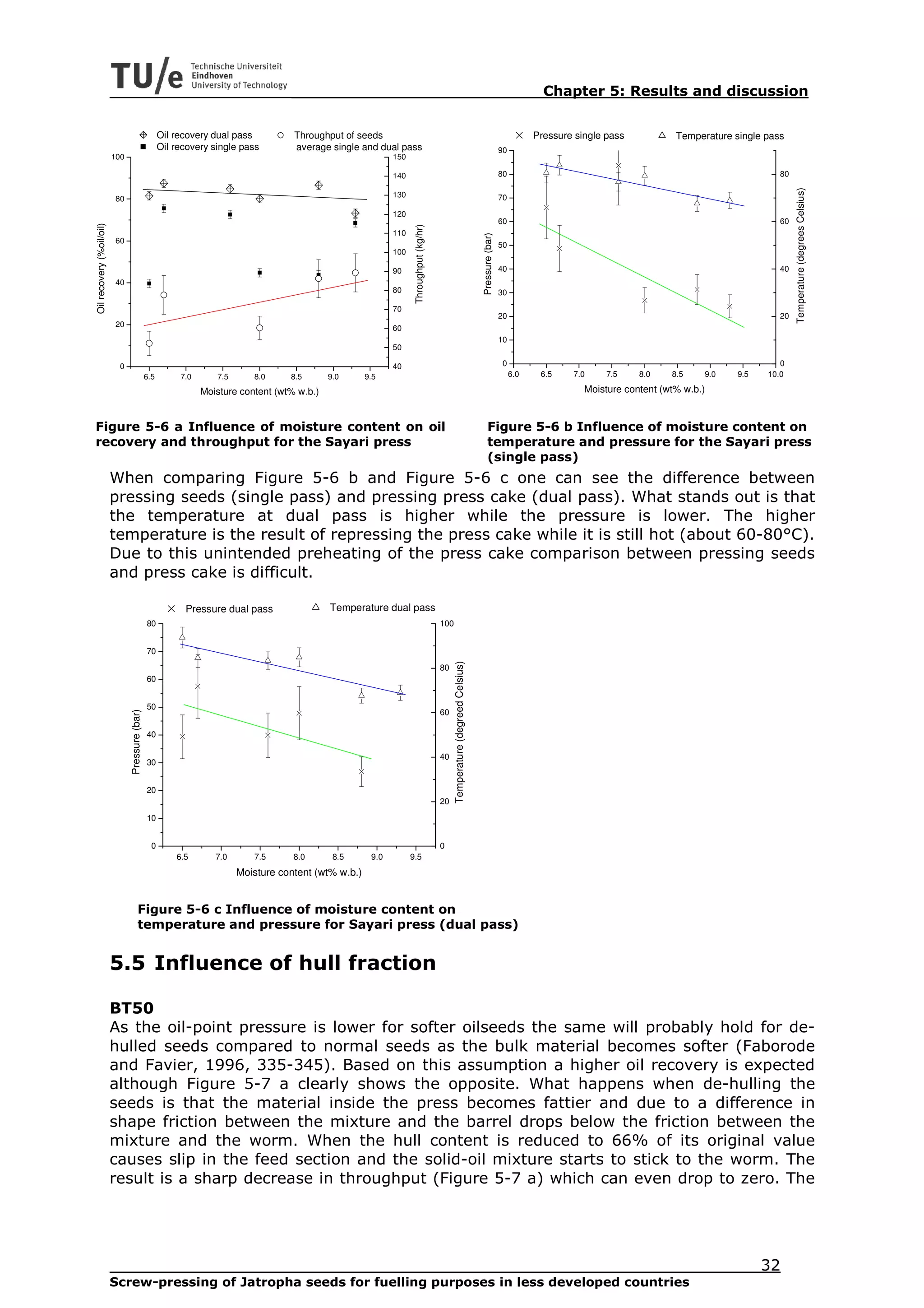

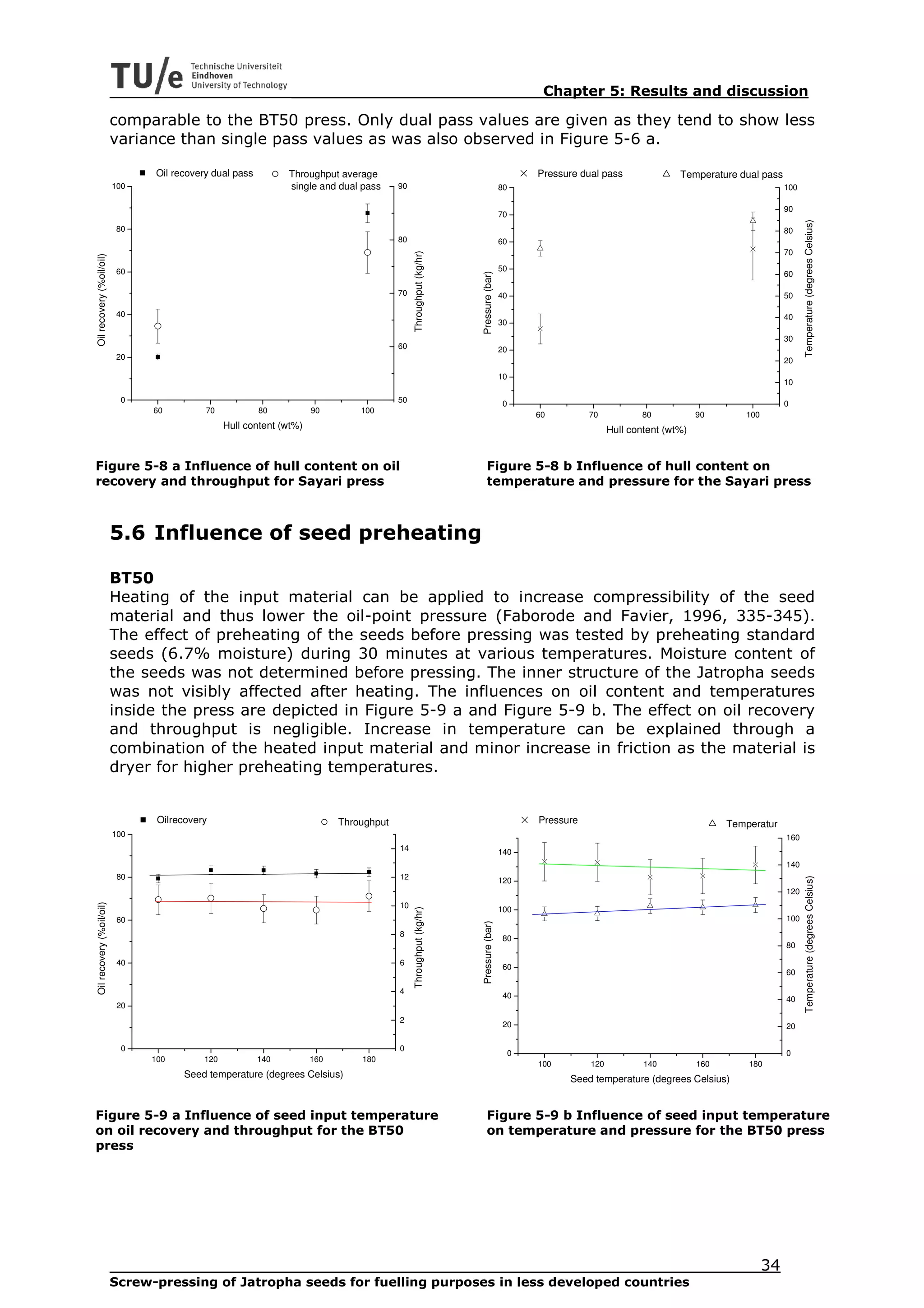
![Chapter 5: Results and discussion
The assumption of minor friction increase is supported by Figure 5-9 c, which shows a
small increase in the amount of energy required for pressing seed that were pre-heated
at higher temperatures while processing time is constant. This indicates that the engine
encounters slightly more resistance. The upper line in Figure 5-9 c indicates a small
decrease in energy use per litre oil at a preheating temperature of 140°C. The reduction
in energy use would not balance the energy needed for preheating and is thus not
advisable for Jatropha seeds. Furthermore the variation is within the error margin and
therefore uncertain.
Power Energy input per liter crude oil
900 900
800 800
700 700
Energy input (kJ/l)
600 600
Energy input (kJ/kg)
500 500
400 400
300 300
200 200
100 100
0 0
100 120 140 160 180
Seed temperature (degrees Celsius)
Figure 5-9 c Influence of seed input temperature on energy
requirement for the BT50 press expressed per kg and per litre crude oil
5.7 Influence of other pre-treatments
In addition to the previously mentioned variables some other test were conducted
although in less detail. The results are presented in Table 5-2. Cracking was expected to
decrease energy use and reduce the oil-point pressure (Faborode and Favier, 1996, 335-
345). The results show that the assumptions do not hold for Jatropha as the energy
reduction is negligible and the oil recovery is lower at pressures comparable to the
standard situation. The BT50 data in Table 5-2 suggest that the oil-point pressure is
lower for the cooked samples as their oil recovery is highest while pressure are
significantly lower than those for dry seeds. The cooking pre-treatment also shows a
positive effect in the Sayari expeller.
Table 5-2 General test results for additional experiments on seed pre-treatment. * Samples were
dried to certain moisture content before pressing. Oil recovery values for Sayari expeller are after
dual pass. The temperatures indicated for the Sayari expeller are the highest temperatures that
occurred, which was during dual pass. Boiling showed a very high oil recovery after single pass in
the Sayari press of 88.7%.
Residual oil Oil recovery ress head temperature [° [° [bar] Throughput [kg/hr] Energy [kJ/l]
P Oil temperature C]
Pressure
C]
BT50
normal 11.0% 79.2% 98 85 122 9.7 142
crushed 11.9% 77.2% 92 82 120 9.8 139
water 70°C 6.1% 89.0% 120 100 220 9.2 312
water 80°C 6.3% 88.7% 141 115 198 9.4 279
Sayari
normal 6.9% 87.5% 84 - 39 54 -
crushed 7.4% 86.4% 84 - 36 63 -
water 80°C 5.0% 91.2% 103 - 86 69 -
5.8 The effects on foots
A striking characteristic of the crude Jatropha oil obtained by screw pressing is the very
high amount of foots or sediments in the oil. After one week settling time approximately
30 to 50% of the volume consists of sedimentary deposits. For normal filtering
35
Screw-pressing of Jatropha seeds for fuelling purposes in less developed countries](https://image.slidesharecdn.com/afstudeerverslagpeterbeerens26-08-07120jatropha20tanzania-120502110635-phpapp01/75/Screw-Pressing-of-Jatropha-Seeds-for-Fuelling-Purposes-in-Less-Developed-Countries-42-2048.jpg)
![Chapter 5: Results and discussion
techniques only 5-10% sediment is acceptable (Ferchau, 2000), which is also the amount
of sediments present in most other plant oils after mechanical extraction. It was not
possible to determine if and how pre-treatments affect the amount of sediments. The
table in Appendix K shows more detailed values of the amount of foot for various
samples.
5.9 Oil quality parameters
Oil quality was judged base don the five parameters shown in Table 5-3. Three very
diverse samples of filtered oil were analyzed by ASG (Analytik-Service Gesellschaft mbH,
Neusäss, Germany). These samples cover both the widest range in oil temperature and
moisture content, which are assumed to be the parameters that affect oil quality most
strongly. None of the samples comply with the PPO norm for rapeseed in Appendix B. For
6.7% moisture acid value and phosphorous content are too high. The other values are in
range. At decreased moisture level of 2.14% phosphorous content reduces close to 15 as
required by the standard at the cost of acid value. At 13.3% moisture acid value and
water content are unacceptable and other values are within limits. The data in Table 5-3
does not provide proper trends as most parameters decrease between 2.14-6.7% and
then decrease form 6.7%-13.3% or vice versa. Acid value tends to increase with
moisture content. Some possible explanations are given here. The strong decrease in
phosphorous content at 13.3% is probably due to lower temperature. Oxidation stability
is increased by increased water content. The higher carbon residue for 13.3% moisture
might be related to the darker colour of the oil due to dissolved pigments.
Table 5-3 Oil quality analysis performed by ASG
Parameter Unit Method Rapeseed standard 2.14% moisture 6.7% moisture 13.3% moisture
Acid value [mg KOH/g] DIN EN 14104 2.0 3.5 3.1 25.8
Phosphorous content [mg/kg] DIN EN 14107 15 16.2 23.2 2.4
Water content [mg/kg] DIN EN ISO 12937 750 741 733 1622
Oxidation stability 110°C [h] DIN EN 14112 5.0 12.6 10.4 21.3
Carbon residue [%] DIN EN ISO 10370 0.4 0.2 0.2 0.4
Processing oil temperature [°C] 97 85 52
5.10 Comparison of suitability for Jatropha processing
between BT50 and Sayari
Based on the results presented in this chapter higher oil recovery is achieved in the
Sayari expeller. At high residual oil content of around 12-15% repressing of the press
cake is possible, resulting in high oil recovery. The BT50 reaches higher oil recovery after
a single pass. However due to the lower residual oil content and the different press
geometry dual pass is not possible for Jatropha in the BT50. For research purposes the
BT50 is preferable because of its small capacity. Batches of around two kg are sufficient
for stable operation and relatively easy to condition. Severe jamming problems were
however experienced when operating at restriction sizes below 9mm and moisture levels
below the natural 6.7%. At 2.14% moisture level, the point at which oil recovery was
highest, continuous processing is not possible in the BT50 due to overheating and
jamming. The Sayari expeller is less suited for experimental use but operates much
better for full time large capacity production. When properly operated jamming of the
press can be avoided whereas this is not possible in most cylinder-hole presses like the
BT50.
5.10.1 Test conducted by industrial press manufacturers
To gain additional knowledge on the pressing process the two German press
manufacturers Keller (KEK EGON Keller GMBH & Co, Remscheid, Germany) and Reinartz
(Maschinenfabrik Reinartz GmbH & Co. KG , Neuss, Germany) were contacted for press
tests with Jatropha seeds. Testing results are shown in Table 5-4. More details on the
presses used for testing are given in Appendix L together with a table showing industrial
oil recovery rates for oilseeds. Rienartz additionally reported seed input temperature of
20°C and oil temperature between 30 and 60 °C increasing from feed section towards the
36
Screw-pressing of Jatropha seeds for fuelling purposes in less developed countries](https://image.slidesharecdn.com/afstudeerverslagpeterbeerens26-08-07120jatropha20tanzania-120502110635-phpapp01/75/Screw-Pressing-of-Jatropha-Seeds-for-Fuelling-Purposes-in-Less-Developed-Countries-43-2048.jpg)
![Chapter 5: Results and discussion
cake discharge. Oil recovery of these machines is higher than for the BT50 and similar to
the Sayari press. The advantage of the Keller and Reinartz presses compared to the
Sayari expeller is that they require only single pass of the material to reach a high oil
recovery.
Table 5-4 Results from tests at KEK Keller and Reinartz conducted in 2007. * [% oil/oil] means the
percentage of the oil present in the seeds that has been obtained by pressing
KEK Keller p0101 date sample description moisture oil contentpress cake oil yield [oil/oil]*
1 4/6/2007 standard settings start sample 6.7% 14.3% 72%
2 4/6/2007 standard settings end sample 6.7% 11.0% 79%
3 6/7/2007 changed pressure cones 6.7% 6.0% 89%
Reinartz AP08
3/7/2007 standard settings 6.7% 5-6.5% 88.3-91.1%
5.11 Conclusions
The most important findings based on the practical research conducted for this study is
presented here. Seed moisture content shows the strongest effect on oil recovery from
Jatropha. The natural moisture content of the seeds (6.7 wt.% w.b.) appears to be close
to optimal. Depending on the desired oil recovery pre-treatments might therefore not be
necessary. Restriction size and rotational speed of the screw are two other influential
parameters. Restriction size should be reduced as far as possible taking into
consideration both operational limits of the press and the effect of temperature on oil
quality. Lower rotational speeds lead to higher oil recovery, which is mainly attributed to
higher residence time. Speed can only be reduced to a limited extent as below 20 RPM
operation is not possible. The choice of rotational speed varies with the demands of the
user. For high production capacity rotational speed should be high and for high oil
recovery per kg input material it should be low. Decrease in hull content below a
threshold value between 66-80% has a strong, although negative, effect on oil recovery.
The influence of seed pre-heating and flaking/crushing proved to be insignificant for
Jatropha seeds. A pre-treatment of one hour cooking followed by seed drying results in
the highest oil recovery for both presses. Single pass pressing of cooked and dried seeds
resulted in the highest measured oil recovery of 89% for both BT50 and Sayari press.
After dual pass oil recovery for the Sayari increased to 91%, being close to the theoretic
maximum of 95%. For comparison normal seeds yields were 79% for the BT50 (single
pass) and 88% for the Sayari (dual pass). Single pass pressing of cooked seeds in the
Sayari expeller thus leads to higher yields than normal seeds after dual pass pressing.
This pre-treatment can thus be used to decrease energy consumption and increase
processing capacity. The energy requirement is of subordinate importance as for the
BT50 the energy input per litre oil varies between 1% and 2.5% of the calorific value of
Jatropha oil.
Taking into consideration all the test results optimal oil recovery is expected at a
moisture content of 2-4% after cooking at 70°C, 100% hull content and the smallest
restriction size and lowest speed possible for a certain press type. Unfortunately the oil
yield using this setup could not be determined due to unexpected breakdown of the press
in the final testing stages. To summarize an overview of the effects of pressing
parameters on the efficiency and conditions inside the press barrel is visible in Table 5-5.
37
Screw-pressing of Jatropha seeds for fuelling purposes in less developed countries](https://image.slidesharecdn.com/afstudeerverslagpeterbeerens26-08-07120jatropha20tanzania-120502110635-phpapp01/75/Screw-Pressing-of-Jatropha-Seeds-for-Fuelling-Purposes-in-Less-Developed-Countries-44-2048.jpg)

